March 31, 2010
BSO/Jayce Ogren, Symphony Hall, Boston
By George Loomis [Financial Times, 31 March 2010]
Like his 2005 cycle Neruda Songs, Peter Lieberson’s new Songs of Love and Sorrow has its origin in a Boston Symphony commission intended for his wife, the mezzo Lorraine Hunt Lieberson, with James Levine conducting. But this treasured singer died of cancer in 2006, and Lieberson subsequently contracted cancer himself.
Opera's Alice Coote on trousers, English songs
Allan Ulrich [San Francisco Chronicle, 31 March 2010]
Few singers in recent years have beguiled San Francisco audiences as instantly as Alice Coote. The English mezzo-soprano bowed brilliantly at the San Francisco Opera in 2002 as Ruggiero in “Alcina” and returned in 2008, earning comparable acclaim as Idamante in “Idomeneo.” On both occasions, Coote proved an artist of enormous conviction, as well as one of the world’s leading operatic interpreters of women-playing-men, what are called trouser roles.
March 30, 2010
In Revival of Verdi, a New Note of Drama
By Anthony Tommasini [NY Times, 30 March 2010]
Who would have guessed that a routine revival of “La Traviata” at the Metropolitan Opera could cause such a ruckus? The problem was that the conductor Leonard Slatkin, appearing at the Met for the first time in 12 years, showed up for rehearsals not fully knowing the score. You did not have to believe the reports that spread on opera chat lines to know this. Mr. Slatkin conceded as much on his personal Web site, leonardslatkin.com.
Dmitri Hvorostovsky, Sondra Radvanovsky sing up a storm for WPAS
By Tim Smith [Baltimore Sun, 30 March 2010]
It’s hard to keep up the lament about the dearth of great, or even just interesting, opera singers today when you encounter American soprano Sondra Radvanovsky and Russian baritone Dmitri Hvorostovsky, who teamed up for a concert Monday presented by the Washington Performing Arts Society at the Kennedy Center. (Hvorostovsky dedicated the evening to the memory of the victims of Monday’s terrorist attack in Moscow.)
March 29, 2010
House of Style — A bumpy season at the Met
By Alex Ross [New Yorker, 29 March 2010]
Peter Gelb’s regime as the general manager of the Metropolitan Opera began triumphantly. On the opening night of the 2006-07 season, the company presented Anthony Minghella’s production of “Madama Butterfly”—a dreamlike, intensely lyrical staging that had originated at the English National Opera. Although most of that season had been fixed in advance by Joseph Volpe, Gelb’s predecessor, the incoming manager deftly inserted the Minghella show into the schedule.
Angels in America, Barbican, London
By Andrew Clark [Financial Times, 29 March 2010]
Peter Eötvös’s opera attracted a large audience for its UK premiere, and deservedly so. This was a beautifully prepared, brilliantly executed rendition of a work that speaks a contemporary language - the F-word much in evidence - without patronising its listeners musically.
Madama Butterfly, NYCO
It says a great deal in her favor that in her sensitive and passionate account of the title role, Shu-Ying Li holds her own against such competition. For example, a great circle dominates the backdrop — red against white for the rising sun or the Japanese flag as the opera opens, turning black against red when the Bonze denounces his errant niece for renouncing her ancestral gods, then white against serene blue for moonlight during the great duet that closes the act.
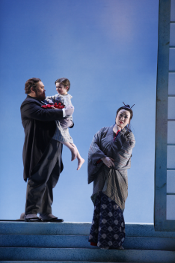 Quinn Kelsey as Sharpless, Eddie Schweighardt as Sorrow and Shu-Ying Li as Cio-Cio San
Quinn Kelsey as Sharpless, Eddie Schweighardt as Sorrow and Shu-Ying Li as Cio-Cio San
There are few props on the wide, bare stage, and therefore those we see
possess greater significance. The tiny ancestral gods that Pinkerton scorns as
“dolls” are placed stage center, as on an altar, during later acts
of the story — first for Butterfly to ignore them, preferring the
wide-awake American god, then for her to atone before them by hara-kiri when
she has lost honor, child and everything else. A fleet of tiny red
“warships” floats like a flock of birds above the stage at
curtain-rise — to be echoed in Act II by the toy ship Sorrow plays with.
A telescope is not merely functional, permitting Butterfly to stare at the
empty harbor of Nagasaki, but also symbolizes her undying hopes.
The traditional screen behind which the heroine kills herself does not appear — instead she shows her gumption (and forfeits a pathos playwright David Belasco and composer Puccini both wished to claim) by turning about to slash her throat in her faithless lover’s face, precisely as Pinkerton enters and after his desperate, perhaps repentant cries of “Butterfly!” This confrontational death is an excess. Butterfly, as Belasco and Puccini conceived her, may be a convenient myth, a construction of the guilty Western colonialist conscience, but that is how they created her; to turn her final act into an expression of vendetta, a spitting in the face of her oppressor — the man she has entirely loved hitherto — seems an intrusive modern afterthought. We may have been patronizing when we took Cio-Cio-San to our hearts — but this resentful figure, this image of hate, will not win our hearts at all.
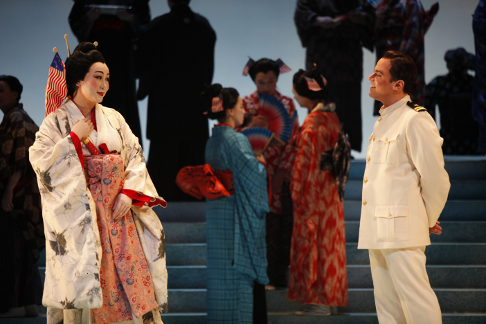 Shu-Ying Li as Cio-Cio San and Steven Harrison as B.F. Pinkerton
Shu-Ying Li as Cio-Cio San and Steven Harrison as B.F. Pinkerton
Shu-Ying Li has a large and genuine Puccini soprano of great beauty, but there is a certain unsteadiness until it warms up. Her entrance was not luminous, but the duet was, and many other soaring phrases as well. Her Cio-Cio-San was a complete portrait, each line part of the whole, not the collection of pretty excerpts it can become. She is a tall woman and does not move like a small one, and in her enormous wedding kimono she all but dwarfs her Pinkerton, but the robe is soon removed — it is present, hanging on rods, for the rest of the opera, a visible symbol of her past — and in slimmer robes she manages to appear becomingly frail.
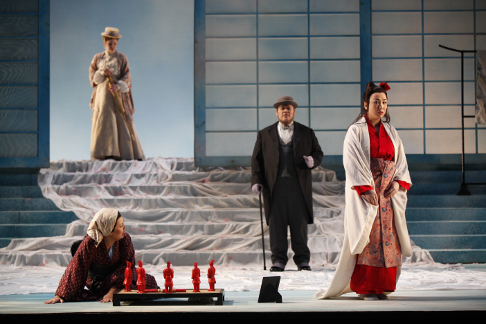 Jessica Klein as Kate Pinkerton, Nina Yoshida Nelsen as Suzuki, Quinn Kelsey as Sharpless, and Shu-Ying Li as Cio-Cio San
Jessica Klein as Kate Pinkerton, Nina Yoshida Nelsen as Suzuki, Quinn Kelsey as Sharpless, and Shu-Ying Li as Cio-Cio San
Broad-shouldered Steven Harrison was, like most modern Pinkertons, cast in the shade by his Butterfly. The role may be thankless, an exemplary cad, but he should be a robust cad and Harrison sounded provincial. Nina Yoshida Nelsen sang an effective Suzuki, especially impressive in the Flower Duet and the penultimate trio. Quinn Kelsey’s Sharpless possessed — not only because of his size — a real presence, so that one accepted the judgments of this involved, sympathetic observer as more than the official boilerplate they can seem. Little Eddie Schweighardt made one of the liveliest Troubles I’ve seen, whacking Jeffrey Halili’s Goro with a fan and chasing about the stage with his toy boat.
George Manahan drew a precise and lustrous account of the score from his orchestra, full of Italian Wagnerism in the way melodies were foreshadowed, then foregrounded, then fragrantly recollected to remind us of joys past or hint at doom to come.
John Yohalem
image=http://www.operatoday.com/2010Butterfly0048.png image_description=Shu-Ying Li as Cio-Cio-San [Photo by Carol Rosegg courtesy of New York City Opera] product=yes product_title=Giacomo Puccini: Madama Butterfly product_by=Cio-Cio-San: Shu-Ying Li; Suzuki: Nina Yoshida Nelsen; Pinkerton: Steven Harrison; Sharpless: Quinn Kelsey; Goro: Jeffrey Halili; Sorrow: Eddie Schweighardt. Production by Mark Lamos. New York City Opera chorus and orchestra conducted by George Manahan. Performance of March 25. product_id=Above: Shu-Ying Li as Cio-Cio-SanAll photos by Carol Rosegg courtesy of New York City Opera
March 28, 2010
Demanding Macatsoris sends opera singers out to the world's stages prepared.
By David Patrick Stearns [Philadelphia Inquirer, 28 March 2010]
One opera book that will never be written is Christofer Macatsoris’ Sweet-Tempered Guide to Verdi. When the longtime Academy of Vocal Arts music director takes the stage for some tuneful old favorite like Rigoletto, the results can be downright terrifying.
A Composer Grows before his Work — The Grapes of Wrath at Carnegie Hall
However, while the evening at Carnegie Hall was more theatrically compelling than most semi-staged performances, the compromise of shortening the three-act opera into two acts of music-theatre with a crossover cast seemed better intended than it was actually effective. Firstly, by replacing the connective recitative with narration from novel (read by Jane Fonda), Gordon’s musical diction was made less effective and, moreover, Michael Korie’s rhyming libretto suffered in comparison to John Steinbeck’s original prose. Secondly, changing the theatrical structure of the evening necessarily altered the musical architecture. Reoccurring motives effectively became musical theatre reprisals rather than the thematic development post-Wagnerian opera audiences expect. At its best, Gordon’s score evoked Ragtime more than Porgy and Bess.
The crossover casting, made possible by across the board sound enhancement, was inspired in some instances but minimized the vocal demands on the singers and did little to establish The Grapes of Wrath as an equivalent to the great American novel. Christine Ebersole was in character from the moment she stepped onto the stage, much more so than most of her counterparts from the world of opera and concert repertoire. That said, while her brief appearance as the waitress Mae should be lauded for the character arc created in a single scene, Ebersole’s vocalism on Monday evening would be considered lacking on either the Broadway or the operatic stage. Victoria Clark and Steven Pasquale, both from the original cast of Adam Guettel’s The Light in the Piazza, fared better. As Ma Joad, it was Clark, rather than headliner Nathan Gunn, who proved to be the both the musical and dramatic lynchpin of the evening. Pasquale used Al Joad’s short second act aria “Hooverville” as an opportunity for cynical showboating à la Gershwin’s Sportin’ Life.
Among the opera singers in the cast, Gunn had the easiest singing and, not coincidentally, the most fun with his musical material. His duet with Sean Panikkar (stepping in for Anthony Dean Griffey as the preacher Jim Casy) featured the evening’s most exciting vocalism. Moreover, Panikkar dealt with the Jiminy Cricket text of his aria “Things Turn Around” with considerable style and dignity. It was unfortunate to hear such a fine singer’s phrasing and coloring flattened by the so-called acoustic “enhancement.”
In order to elide three acts into two, Gordon and Korie had to cut much of the musical and dramatic exposition and development. Therefore, the aria establishing Jim Casy’s character was actually his swan song. This was also the case with Andrew Wilkowske in the role of Noah. Perfectly cast, Wilkowske carried off the evening’s most challenging scene with sweet singing, sensitive acting, and overall aplomb. As Uncle John, Stephen Powell’s performance was fully realized both dramatically and vocally. Within the ensemble cast, Matthew Worth played three parts, but should be especially commended for his turn as the Ragged Man.
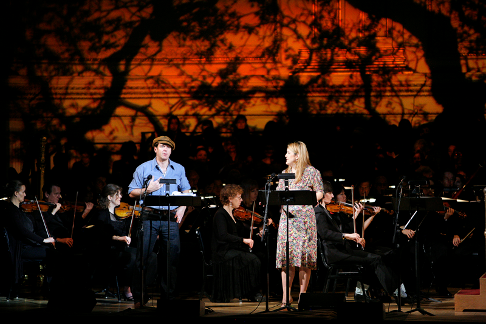 Nathan Gunn and Victoria Clark
Nathan Gunn and Victoria Clark
Costuming by Jacob Climer and projections by Wendall K. Harrington helped to actualize the opera’s considerable theatrical potential. Inexplicably, though, Elizabeth Futral showed no visible signs of pregnancy as Rosasharn. Some of the projections, a mix of black-and-white period footage and color representations of Dust Bowl meteorological phenomena, were more literal than evocative (as in the case of the burning crops during the riot at Hooper Ranch). The evening’s rather abrupt ending, in particular, could have been made more poignant with different projections and lighting. Perhaps this was due to the limitations of the concert stage – a full orchestra of music stand lights took away from the poetry of Rosasharn’s “one star” in the night sky as a beacon of American hope – or, more likely, the rushed feeling of condensing a five hours of original music into two acts.
In either case, as an evening of music-theatre Gordon’s The Grapes of Wrath shows promise. Since its original production at the Minnesota Opera in 2007, members of the original team, including director Eric Simonson, have overseen the subsequent productions at Utah Opera and Pittsburgh Opera as well as this week’s performance at Carnegie Hall. If new creative teams can work with the material as effectively as singers like Andrew Wilkowske, Sean Panikkar, and Stephen Powell have assimilated their roles, then audiences have something to look forward to.
Clearly, Gordon and Korie are open to the idea of re-tooling their opera in order to make it more viable for today’s opera houses and audiences. It would be interesting to see if, rather than featuring a large orchestra and expanding the use of the chorus, the opera could be centered around a core ensemble cast à la John Corigliano’s recent reconfiguration of The Ghosts of Versailles. After all, the difference between a novel and a musical score as a source document is that as a book stands the test of time it eventually becomes a definitive example of something specific within its literary canon. In order for an opera to become part of the standard repertoire, the score and libretto need to inspire many different interpretations so that multiple successful productions may be mounted. The Collegiate Chorale’s concert version of The Grapes of Wrath should definitely be considered a success and a step towards establishing both the composer and the work within the American opera repertoire.
Alison Moritz
image=http://www.operatoday.com/CC100322-074RT%20small.png image_description=Christine Ebersole [Photo by Erin Baiano courtesy of The Collegiate Chorale] product=yes product_title=Ricky Ian Gordon: The Grapes of Wrath product_by=Jane Fonda, Narrator. Nathan Gunn: Tom Joad; Victoria Clark: Ma Joad; Elizabeth Futral: Rosasharn; Sean Panikkar: Jim Casy; Peter Halverson: Pa Joad; Stephen Powell: Uncle John; Andrew Wilkowske: Noah; Steven Pasquale: Al; Christine Ebersole: Mae; Matthew Worth: Ragged Man/Connie/Truck Driver; Madelyn Gunn: Ruthie. American Symphony Orchestra. Ted Sperling, Conductor. Edward Barnes, Producer. Eric Simonson, Director. Frances Aronson, Lighting Designer. Wendall Harrington, Projection Designer. Carnegie Hall, March 22, 2010. product_id=Above: Christine EbersoleAll photos by Erin Baiano courtesy of The Collegiate Chorale
Christianne Stotijn at the Wigmore Hall
In Tamerlano, recently at the Royal Opera House, Christianne Stotijn made her debut both in the title role and at Covent Garden. Tamerlano is a brutal tyrant, and male. Modern audiences are perhaps more used to hearing a lower voice expressing such things. But Handel isn’t Verdi. He wrote the role for female voice, which makes it all the more difficult to create the role convincingly for modern expectations. Tamerlano’s personality doesn’t come naturally to Stotijn, though part of the art of acting means becoming a character completely different to yourself.
Stotijn’s voice is attractive, capable of warmth and sensitivity. She’s Bernard Haitink’s singer of choice, particularly for Mahler. She’s very good in Lieder, so I was looking forward to her song recital at the Wigmore Hall, London.
Her programme was wide-ranging: Pfitzner, Wolf, Tchaikovsky, Mussorgsky, Debussy, Strauss and Loewe. This is the kind of recital singers often create to show their prowess, though Stotijn is well known enough to have passed the stage where she needs to show her facility with languages and styles. The danger with programmes like these is that they stretch singers out too thinly, militating against depth of interpretation.
What Stotijn needed was a vehicle to show how she could penetrate a composer’s unique idiom.The Strauss set showed her at her best. Traum durch die Dämmerung was nicely paced, bringing out the rocking motion between light and shade. The song centres near the middle of the voice, so the flow is smooth, not forced. Similarly Ich schwebe and Die Erwächte Rose benefited from her gentle, lilting approach.
Yet there’s more to Lieder than charm. Loewe’s Herr Oluf was an odd choice, for this song is brutal. It’s often a star turn for baritones who can express its horror. Stotijn was lost, even when she sings the second part, where the bride sings innocently, wondering where Her bridegroom may be. She lifts a cloth and there he is dead. But it didn’t seem to register. Similarly, her Walpurgisnacht didn’t capture the hysteria of a child witnessing demons mother can’t see. Luckily, she sang Loewe’s Erlkönig, rather than Schubert’s, which doesn’t require as much vocal dramatization.
Part of Stotijn’s problem is that her voice is currently underpowered. Sound seems trapped in her chest, not fully projected, either in volume or intensity. Building up her technique will help, and strengthening the middle of her voice. Consonants define words, so sharpening these will increase clarity and attack.
The pianist was Joseph Breinl. He made fast paced, complex tempi flow freely, almost to the extent he was carried away with the vividness of his playing. This was most marked in the beginning of the recital with the Pfitzner songs Stimme der Sensucht and Nachts. To his credit, he pulled back as the recital progressed. Part of being a pianist for song means being sensitive to the singer, especially when she needs support and confidence. In songs like Strauss’s Ruhe meine Seele! where voice is unaccompanied for much of the time, Stotijn could be heard without effort.
Unlike instrumental players, singers “are” their instruments. Unlike machines, their performance can vary, depending on many different factors. Stotijn was born with a good voice, capable of great warmth and sensitivity, but at the moment, something is getting in the way. At times like these, technique comes to the rescue. Indeed, good technique has saved many a lesser voice.
If she takes the opportunity to refine her skills and rebuild her confidence, she’ll emerge from this period with credit. Just as fire strengthens steel, perhaps these current difficulties can strengthen Stotijn in the longer term.
Anne Ozorio
image=http://www.operatoday.com/stotijn.png image_description=Christianne Stotijn [Photo by Marco Borggreve]
product=yes producttitle=Christianne Stotijn at the Wigmore Hall — Pfitzner, Wolf, Debussy, Mussorgsky, Tchaikovsky, Strauss, Loewe productby=Christianne Stotijn (mezzo), Joseph Breinl (piano) Wigmore Hall, London 25th March 2010 product_id=Above: Christianne Stotijn [Photo by Marco Borggreve]
Angels in America, Eötvös at the Barbican for the BBC
Angels in America depicts the first phase of the AIDS pandemic, in the very early 1980’s. Back then, the disease wasn’t even identified. Healthy young men were dying gruesome deaths from “Karposi’s sarcoma”, a cancer of the very old. Then apparently straight people succumbed, even bullying homophobes. It’s hard to appreciate how bad those times were, if you didn’t live through them. Yet AIDS was a turning point in society, because it exposed hypocrisy and prejudice.
Thirty years on, much has changed. In the west, people don’t die of AIDS as long as they can afford healthcare and medication. Now it’s entrenched in the Third World, particularly in Africa. We cannot be complacent.
Eötvös compresses Kushner’s seven hour saga into 2 1/2 hours.In the first part, vignettes of people experiencing death in their own way. Prior Walter (David Adam Moore) is a gay man dumped by his frightened lover. (Scott Scully). Roy Cohn (Kelly Anderson), the bully who thinks he can’t be touched, and Joe Pitt (Omar Ebrahim), the hapless married Mormon, who has to face the contradiction in his life. This concentrates dramatic focus on human relationships, and is very moving. Kushner doubled the parts, so the drama could extend beyond the immediate victims making it relevant for all society.
All roles, except the main protagonist Prior Walter, are doubled in the opera, too, Anderson and Ebrahim sing Ghosts of Plagues past, but Brian Asawa stands out. He sings no major role but a variety of subsidiaries, yet brings such assertiveness to them that they register well. His bright countertenor, these days mellowing lower in the range, extends Kushner’s ambiguity into the music.
Julia Migenes was impressive, too, as Harper Pitt, (male name, female role), Joe’s drug-ravaged wife who intuits his true nature and makes him confront his identity. She’s also Ethel Rosenberg, Roy’s nemesis and Angel Antartica. These are pivotal roles, which Migenes carries off with conviction. Janice Hall is less well served by the opera, her roles bordering on shallow stereotype.
Eötvös’s music illustrates the text nicely. Marimbas and electronics to create weird, surreal sounds, percussion to mark tension, lovely cello and violin melodies to enhance moments of individual reverie. As an extension of the play, the music is usefully mood-enhancing, so in that sense it works. He works following the text as it unfolds, which perhaps accounts for the episodic, reactive nature of the music. This works well in the first part, where the opera is spurred on by the dramatic momentum of Kushner’s vision.
In the second part, Kushner’s venturing into much more abstract territory, depicting Heaven and life after death. In the opera, the narrative isn’t coherent. Life (and the afterlife) isn’t necessarily coherent, so in a sense this unintelligibility is valid. But because music is abstract, this would have been an opportunity for Eötvös to write something distinctive. Opera is much more than film music. It’s more than illustrating text. It can reinforce the narrative with another dimension of original commentary, for opera is as much a composer’s response to a play than just the play itself.
I enjoyed this concert staging (directed by David Gately) because it showed how the simple resources of a concert staging can have a huge impact, done as thoughtfully as this. The lighting effects were superb, evoking huge vistas in the imagination. I “saw” the stars in the heavens and the lights of a night time city.
Ultimately, Angels in America works on stage because the subject is so powerful. It packs such an emotional punch that it would be hard not to be moved by the human drama in the first part. A lot of choices had to be made when Eötvös and his librettist reduced Kushner’s seven hour saga. That’s all the more reason why decisions had to be taken for maximum dramatic and musical effect. As an opera, Angels in America might have served the subject better had it been less dependent on replicating the play, and taken a more original vision.
Anne Ozorio
image=http://www.operatoday.com/PeterE%C3%B6tv%C3%B6s.png imagedescription=Peter Eötvös [Photo by Jean-Francois Leclercq]
product=yes producttitle=Peter Eötvös: Angels in America productby=David Adam Moore: Prior Walter; Scott Scully: Louis Ironson/Angel Oceania; Julia Migenes: Harper Pitt/Ethel Rosenberg/Angel Antarctica; Omar Ebrahim: Joseph Pitt/Ghost2/Angel Europa; Janice Hall: Hannah Pitt/Rabbi Chemelwitz/Henry/Angel Asiatica; Kelly Anderson: Roy Cohn/Ghost1/Angel Australia; Brian Asawa: Belize/Mr Lies/Woman/Angel Africanii; Ava Pine: The Angel/Voice; Ann de Renais, Patrick Ardagh-Walter and Wendy Nieper: Vocal trio. David Gately: Director. David Robertson: conductor. BBC Symphony Orchestra. Barbican Hall; London. 26th March 2010. product_id=Above: Peter Eötvös [Photo by Jean-Francois Leclercq]
March 27, 2010
Harrison Birtwistle: The Minotaur
This disc is based on later performances of the opera, which were given on 25 and 30 April and 3 May 2008 and released on Blu-Ray in 2010. The work is a retelling of the myth of the Cretan minotaur, specifically the culmination of the story in which the Greek hero Theseus survives the labyrinth and rescues Ariadne from the legendary beast. With its libretto in English by David Harsent, the text is a modern retelling, which presents the story in plain and direct terms; the music, as related in the accompanying booklet, has its origins in various sources, including Birtwistle’s Earthdances (1985). The Minotaur also resembles the two-part structure of the composer’s well-known opera Gawain and the Green Knight (2000), a narrative in which a hero also encounters a legendary figure, and in doing so reaches new perspectives about himself. At the same time The Minotaur is an opportunity of the composer to return to the milieu of classical mythology, which he had explored in The Mask of Orpheus (1984).
The Minotaur is a substantial work of about three hours, and its two parts contain a series of scenes in which the story unfolds, starting with the monologue of Ariadne, whose unique perspective offers Theseus an advantage in dealing with the Minotaur. The scenes reflect a structure in which ideas recur, as shown in the following outline: Part 1: (1) Arrival; Toccata 1; (2) The Choice; (3) The Labyrnith; (4) Ariadne; (5) The Labyrinth; Toccata 2; (6) The Minotaur dreams; (7) The Labyrinth; [Intermission]; Part 2: (8) A proposition; Toccata 3; (9) The Minotaur dream; (10) The oracle of Psychro; (11) A blind bargain; (12) The Labyrinth; (13) The death of the Minotaur. The instrumental toccatas function like the instrumental interludes in Berg’s Wozzeck and also allow the audience an opportunity to reflect on the text just presented. Toccata 1, for example, shows Theseus contemplating the situation at the outset in a particularly intriguing juxtaposition with the undulating sea with which the opera opens. The latter image recurs with Toccata 2, which also precedes the first episode of the Minotaur dreaming. The Minotaur, who is actually Ariadne’s half-brother Asterios, refers to the sea, which seems to be a form of escape to the world outside the Labyrinth in which he is imprisoned. The Labyrinth itself is a kind of arena, and the crowd looking on jeers at the Minotaur as much as they comment on the battles with the prisoners in the Labyrinth, with Ariadne seemingly officiating, sometimes from the seats above, other times from the floor of the arena.
One of the more effective scenes is scene 12, the final evocation of the Labyrinth, the projection of a maze being drawn around the stage and framing John Tomlinson as the Minotaur is particularly effective. This leads to the final confrontation in which Theseus slays the Minotaur, and in dying Asterios the Minotaur recovers his humanity. This work is an exploration of personal discovery, and the music functions as a vehicle for the text, while also serving as a means of setting the tone. The sometimes percussive music conveys a sense of the brutal forces at work in this score. While it is difficult to assign any number a kind of aria or arioso character, the music nevertheless allows for some expressive passages, as with the Minotaur’s final monologue, which is key to understanding this fable. If this death scene is prolonged, a convention in opera, it is to call attention to the nature of the Minotaur and the way in which the environment of the Labyrinth contributed to his own self-definition. Theseus may have slain the Minotaur, but that act is not the focus of this work. However heroic one may wish Theseus to be, that is not his function in Birtwistle’s opera, where the famed Greek hero serves as the vehicle of fate and the fulfiller of a bargain with Ariadne. Again, Birtwistle’s score is key to setting the tone, with concepts expressed in text underscored by the accompanying music. The whole is good drama, a stage work that engages the audience in the quest for self-discovery through the final moment, when the Harpy who brought the first part of the work to its conclusion makes the final gesture. Ariadne, whose actions influenced the dénouement, has already worked out her fate, with THeseus serving as her instrument in bringing the Cretan Labyrinth to its conclusion.
The principals are uniformly effective, with Christine Rice standing out as Ariadne, who embodies her character. For this work, Birtwistle has fleshed out the character of Ariadne more fully than some composers have depicted her, an element that requires the finesse Rice brings through her singing and acting. As Theseus, Johan Reuter is also persuasive, but it is John Tomlinson who remains memorable in creating the image of the Minotaur and giving him voice. Through the artifice of the costume, Tomlinson contributes a sense of humanity to this mythic creature, a crucial aspect of this work. The chorus itself works well within the staging, as they serve as commentators on the scenes and also contribute to the setting.
This recording benefits from the high-definition imaging of Blu-Ray technology, along with excellent sound, which serve well to preserve the details of this premiere recording. The sometimes dark sets, especially the opening sea-blues, emerge with definition in this medium, and that helps to give a sense of being present at the performances. The crisp images help to bring the sense of immediacy to the staging, with the details bringing the costumes and sets into the overall effect of this well-thought production. More importantly, the clear images of the performers are preferable to the sometimes distant shots of singers involved with some opera videos. In a similar way, the clarity of the sound helps to bring out the distinctions of timbre that Birtwistle used in his score. The English-language text is always distinct, and reinforced by the subtitles in English, German, French, and Italian.
The disc also includes a documentary about the opera, Myth Is Universal, which offers some useful perspectives for rehearing the work. Those interested in the opera can also use the synopsis, which serves as a fine introduction to the opera in the manner of a plot summary found in the programs of live operas. As a whole these elements work together to introduce and explicate an important new score, a successful new opera on an ancient theme, and this recording preserves in fine sonic and visual detal the staging with which it premiered.
James L. Zychowicz
image=http://www.operatoday.com/OABD7052D.gif image_description=Harrison Birtwistle: The Minotaur
product=yes producttitle=Harrison Birtwistle: The Minotaur productby=The Minotaur: John Tomlinson; Theseus: Johan Reuter; Ariadne: Christine Rice; Snake Priestess: Andrew Watts; Hiereus: Philip Langridge; Ker: Amanda Echalaz. The Royal Opera Chorus. The Orchestra of the Royal Opera House. Antonio Pappano, conductor. Stephen Langridge, stage director. Recorded live at the Royal Opera House, Covent Garden on 25, 30 April and 3 May 2008. productid=OABD7052D [Blu-Ray DVD] price=$45.98 producturl=http://astore.amazon.com/operatoday-20/detail/B0030BK8YE
March 26, 2010
L’Etoile, NYCO
This would be most unsuitable — if this post-Offenbach operetta of 1877 were anything but a perfection of ridiculousness. The gentlemen in bowler hats, bouncing up and down like pistons! the ladies whose mourning frocks and veils are instantaneously transformed into the can-can frippery of rejoicing! the lead singers on scooters! the backdrop that itself becomes tipsy when the mad King Ouf sings a tribute to Chartreuse (the lighting changes at that point too)! the fun-house mirrors that enclose (and might as well describe) the action — which will strike Americans as “Gilbertian,” though Gilbert got his ideas from Offenbach, too.
In the City Opera’s quest to re-establish and re-present itself to New York as the opera company that does what the Met isn’t going to do, Chabrier (the production has already been seen there in 2002) is an excellent place to start. The melodies are light in a slyer way than Offenbach’s, with more opportunity for harmonious display, as in the “kissing” quartet in Act III. The choruses are not mere background, and in the Lamos production give the City Opera ladies and gents a chance to strut to a Broadway standard, all the while singing at a rather higher one. The wit of the piece is the kind of froth that so often evaporates when the Met attempts operetta, and it wouldn’t work at NYCO either if it were not so elegantly presented and if we were not all used to surtitles by now. Ideally, such a work should be given in the vernacular and in a small house, but that’s true of Rossini’s comic operas too — and of Shostakovich’s The Nose, for that matter, concurrently doing sell-out business across the plaza.
The story of L’Etoile makes one reflect on the deep philosophical import of The Mikado. The tyrant here, King Ouf I (I guess that should be le Roi Ouf Ier), always celebrates his birthday with festivities climaxing in a public execution. Knowing this, his subjects are on their best behavior at that time of year — but Lazuli, a boy from out of town, falls into the trap of resenting the world because he is unhappily in love with a strange girl he met on the road. Before he can be impaled on a booby-trapped armchair, however, the royal astrologer discovers that he — Lazuli — is destined to die precisely one day before the king does. (Date unspecified.) The king thereupon decides to spare the boy — which is good news for Siroco, the astrologer, whom the king has condemned to die fifteen minutes after the king does. But Lazuli does not want to live without his adored Laoula — despite the fond attentions of the ladies of the court — and attempts to drown himself. And Laoula, it turns out, is not a traveling cosmetics saleswoman (her disguise) but the princess next door, betrothed to King Ouf. Ouf, like Gilbert’s Koko, prefers life to love-death and orders the lovers wed. “And we’ll have two executions next year,” he consoles his delighted subjects.
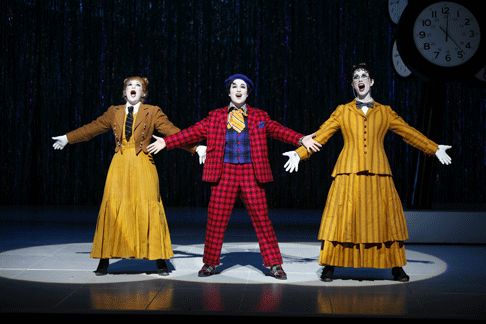 Jennifer Zetlan as Laoula, Julie Boulianne as Lazuli, and Liza Forrester as Aloès
Jennifer Zetlan as Laoula, Julie Boulianne as Lazuli, and Liza Forrester as Aloès
Everyone loves a comic villain, and Jean-Paul Fouchécourt’s King Ouf is the joy of this occasion — as he was in his NYCO debut as Rameau’s frog-nymph Platée. He is the joy of the costume designer Constance Hoffman as tiny Ouf stomps about “in disguise” in the largest overcoat in captivity, and the joy of the conductor, the joyous Emmanuel Plasson, as he warbles his song of Chartreuse ecstasy, his high tenor mated with François Loup’s low bass, and he is the joy of everyone present as he caricatures tiny men with too much power, in his bloodthirst, his lust, his cowardice, his egotism. I heard Fouchécourt last month singing Satie’s Socrate to accompany Mark Morris’s choreography; he was splendid, but he’s far too much fun on stage to let him languish in any pit. Morris should have let him dance.
I was less thrilled with Julie Boulianne as the boyish Lazuli, on purely vocal grounds. Like so many boyish roles in French opera (and theater), the part is written for a young woman, and when Frederica von Stade sang it, her famous charm and musicality conquered all. But Boulianne, though she has a solid technique and many pretty notes (at least high ones — she faded out on lower lines), suffered intonation problems throughout the first act, often landing just shy of otherwise good, clear tones. Too, her trilled “kisses” lacked body, and the joke is not a good one without genuine trills. Only in the quartet, when obliged to intone the extremely musical name “La-ou-la,” did her vocal appeal make the proper effect.
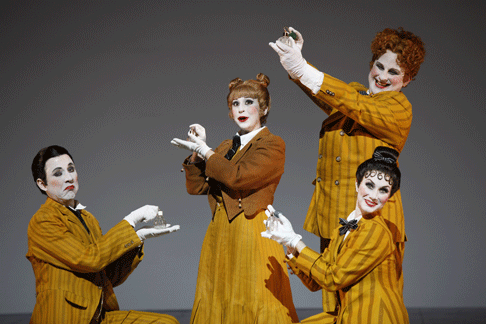 William Ferguson as Hérisson de Porc-Épic, Jennifer Zetlan as Laoula, Andrew Drost as Tapioca, and Liza Forrester as Aloès
William Ferguson as Hérisson de Porc-Épic, Jennifer Zetlan as Laoula, Andrew Drost as Tapioca, and Liza Forrester as Aloès
Tiny Jennifer Zetlan was charming as the princess, but tall Liza Forrester, as her confidant and abettor in tickling strange sleeping men, had a mezzo that made me daydream of hearing her in many larger, more rewarding roles. The supporting parts in this opera are numerous and were all cast with City Opera folk who sang elegantly and cavorted stylishly. Style, the essence of Chabrier, was also the essence of the silly evening.
John Yohalem
image=http://www.operatoday.com/L_Etoile0040.gif image_description=Jean-Paul Fouchécourt as King Ouf and François Loup as Siroco [Photo by Carol Rosegg courtesy of New York City Opera] product=yes product_title=Emmanuel Chabrier: L’Etoile product_by=King Ouf I: Jean-Paul Fouchécourt; Lazuli: Julie Boulianne; Laoula: Jennifer Zetlan; Aloès: Liza Forrester; Siroco: François Loup. Chorus and orchestra of the New York City Opera, conducted by Emmanuel Plasson. Production by Mark Lamos. New York City Opera, performance of March 20. product_id=Above: Jean-Paul Fouchécourt as King Ouf and François Loup as SirocoAll photos by Carol Rosegg courtesy of New York City Opera
March 25, 2010
End of the aria as opera falls on hard times
By Feargus O’Sullivan [Financial Times, 25 March 2010]
How does a notoriously expensive art form such as opera stay healthy when the economy itself is sick? This is the pressing question faced by opera companies across the world as funding shrinks and audiences dwindle.
Eva Marton in Puccini and Strauss
Ultimately the Marton career — which continues to this day — will not rival that of Nilsson’s. The two DVDs reviewed here give evidence of the power that Marton possessed at her best and of the weakness that kept her from truly assuming the Nilsson legacy.
Recorded at the Vienna State Opera house in 1989, this staging of Richard Strauss and Hugo von Hofmannsthal’s Elektra is one of the glories of live opera on film, deserving of eternal availability. The DVD picture has great clarity, despite the darkness of Hans Schavernoch’s set design. Other than the cliché of a huge statue head, toppled on its side, the set manages to be suitably representative of a decaying palace as well as an imposing, theatrical space, dominated by the mammoth body of the statue from which the head apparently dropped, draped with the ropes that seem to have enabled the decapitation. Sooner or later most of the characters cling to and twist around those ropes, an apt stage metaphor for the remorseless repercussions from the murder of Agammenon by his unfaithful wife Klytämnestra and her paramour, Aegisthus. Reinhard Heinrich’s costumes capture a distant era while sustaining a creepily modern look — part Goth, part homeless, part Spa-wear.
Director Harry Kupfer does brilliant work with the cast. Here Marton seems like a major stage performer. Her Elektra boils inside with hatred and disgust, but she can’t let it show. Marton’s impassive mask draws attention to the steely coldness of her eyes. When she recognizes her brother, Orestes, and knows that her wish will soon be fulfilled, she won’t allow herself conventional jubilation. Instead, she sinks back upon her brother and lets the fire die out of her eyes. Her dance of mortal joy at the end finds her wrapping herself in those ropes trailing from her father’s statue — she lived and died for him; there is no escape. Those who know Marton from her later years will be astounded by the firmness of her delivery — never wobbly, never shrieky. If we evaluate a performer by his or her best, Marton proves herself a great singer here.
Cheryl Studer finds a fire, too, in her Chrysothemis. Neither Kupfer or Brigitte Fassbaender will go for any ghoulish caricature for Klytämnestra, which makes her scarier. James King brings more of his heroic tone that one might expect at this stage of his career to the weaselly Aegisthus. Franz Grundheber is in fine form as Orestes, and Kupfer’s inclusion of Orestes at the end, covered in blood and both triumphant and aghast, ensures a shattering conclusion. Claudio Abbado gets a paradoxical performance out of the Vienna State Opera forces — both brutal and refined.
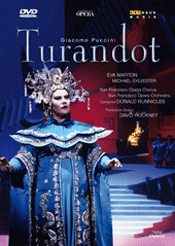
Five years later in San Francisco, Marton is just not the same singer as Turandot. She relies on conventional soprano diva mannerisms, but more damagingly, the voice has deteriorated. High sections are half-hooted, half-screamed, and extended notes flutter from semi-tone to semi-tone. Truthfully, a lot of Turandots sound like this, and many sound worse. Marton herself had established the measure of her abilities with the earlier Elektra; this is simply at a lower level.
The chief attraction here is as a recorded testament to the beauty and ingenuity of David Hockney’s sets. This classic production still gets trotted out (I saw it in San Francisco and San Diego in the early 2000s). However, film doesn’t capture its beauty and charm well. The stage picture is too dark, and frequent close-ups dim the theatrical effect.
Michael Sylvester seemed poised for a notable career at this point, and his Calaf has force as necessary and yet some sweetness of tone. Ian Falconer’s costume doesn’t flatter the tenor, who has a barrel chest and spindly legs. My sister and I had a debate as to whether Mr. Sylvester’s eyes cross at the high note of “Nessun dorma,” but only the wickedly curious will want to get this set to make their own judgment on that. The rest of the cast tends to the pedestrian — Lucia Mazzaria a forgettable Liu, Kevin Langan a prosaic Timur, and the singers of Ping, Pang, and Pong making their scene feel dreadfully long. Donald Runnicles seems to want the evening over fast, with many tempos just a bit too fast.
It is the classic Elektra for which Eva Marton should be remembered.
Chris Mullins
image=http://www.operatoday.com/ArtHaus100049.gif image_description=Richard Strauss: Elektra
product=yes producttitle=Richard Strauss: Elektra productby=Elektra: Eva Marton; Klytämnestra: Brigitte Fassbaender; Chrysothemis: Cheryl Studer; Aegisth: James King; Orest: Franz Grundheber. Vienna State Opera Chorus. Vienna State Opera Orchestra. Claudio Abbado, conductor. Harry Kupfer, stage director. Hans Schavernoch, set design. Reinhard Heinrich, costume design. Robert Stangl, lighting. Recorded from the Vienna State Opera, 1989. productid=ArtHaus Musik 100 049 [DVD] price=$26.99 producturl=http://astore.amazon.com/operatoday-20/detail/B000FII194
Puccini: Turandot ArtHaus Musik DVD 100 089
Strauss: Elektra
March 24, 2010
Take a Play, Then Adorn It With Opera
By Allan Kozinn [NY Times, 24 March 2010]
The English were wary of the Continental taste for opera in the 17th century, but they liked the idea of adorning plays with music. What composers and theater producers came up with is a curious compromise that Roger North, a writer at the time, called “semi-opera.” In this hybrid form, a play is presented straightforwardly, as spoken text, with masques — parades of songs, choruses and dance — interspersed within each act.
Wolfgang Wagner, Director of Bayreuth, Is Dead at 90
By Margalit Fox [NY Times, 23 March 2010]
Wolfgang Wagner, an opera director and impresario who for more than half a century ran Bayreuth, the international music festival conceived by his grandfather, Richard Wagner — and known most recently for the dynastic power struggle that was more toweringly operatic than anything the senior Mr. Wagner could have written — died on Sunday in Bayreuth, in southern Germany. He was 90.
March 23, 2010
La Voix humaine/Herzog Blaubarts Burg, Oper der Stadt Köln
By Andrew Clark [Financial Times, 23 March 2010]
There is no more potent pairing in opera than Poulenc’s monodrama about a suicidal woman and Bartók’s two-hander about an abusive man.
Villazon Triumphs in Stage Return as Love-Sick Twit
By Larry L. Lash [Bloomberg, 23 March 2010]
Sad-faced people held signs reading “Suche Karte” (Seeking Ticket) as the luckier souls piled into the Vienna Staatsoper last night. Scalpers charged as much as 1,000 euros ($1,350) for a seat in the top balcony.
Il pastor fido at the Royal College of Music
By Geoff Brown [Times Online, 23 March 2010]
After last year’s anniversary celebrations a passer-by might imagine there to be no Handel stone left unturned. But with Handel’s productivity, that’s impossible. This term, students and postgraduate associates of the Royal College of Music have been blowing off dust from the third version of his pastoral opera Il pastor fido, as produced at Covent Garden in 1734.
Genoveva — Schumann at UCL Opera, London
Yet Schumann could write dramatic music as the much-loved Overture demonstrates, and the music in the Overture infuses the opera. His songs prove how well he could write for voice. His range as composer was wider than Wagner’s, and he was formidably well-read. What might Schumann have achieved had he continued writing after the age of 45?
UCL Opera is an unusually adventurous company. Since 1951 it has staged no less than 19 world or British premieres, and last year staged Ernest Bloch’s Macbeth . Next year, they’re planning Weber’s Die drei Pintos (completed by Mahler). Because UCL Opera does repertoire where there’s little entrenched performance tradition, its approach can be fresh and imaginative.
The original folk tale on which Genoveva is based dates back to the Middle Ages. Indeed it’s the basis of stories like Snow White, for in legend, Genoveva lived in the forest, protected by animals and by her virtue. Significantly, though, Schumann rejected the medieval concept, choosing instead to base his opera on Friedrich Hebbel’s more psychological drama, published only four years previously. Schumann wanted a “modern” take on the story. As Hebbel said “Any drama will come alive only to the extent that it expresses the spirit of the age which brings it forth”.
Schumnann’s Genoveva focuses on fundamentals — good versus evil, integrity versus deceit, the individual against the mob. Such concepts apply just as much today as they did in Schumann’s time. Its basis is the dynamic between Golo and Genoveva, who isn’t as passive as the legend would have. This gives the opera inherent drama and energy, which a really good performance can bring out.
Schumann’s orchestration is colourful. Genoveva and Seigfried have just married, but he’s going off to war. Glorious trumpet fanfares, woodwind and drums depict the excitement of battle. Alone, and isolated, Genoveva’s music is tender, heightening her confrontations with Golo and the baying mob. Later, when Drago’s ghost appears, Schumann’s dark, gloomy textures would have evoked, to his audience, the Wolf Glen scene in Weber’s Der Freischütz.
There’s plenty of incident in this narrative - a rape, mob violence, murder and of course the ghost and the witch. The sharpness of the German original is muted in English. Although the translation is by David Pountney, it’s clumsy and doesn’t adapt well to the musical line. However, it’s unrealistic to expect a largely student cast to sing idiomatically in a foreign language, and audiences might justifiably complain if they don’t know the libretto.
Perhaps, too, the drama might have been much more pointed if the set wasn’t quite so self-consciously medieval. Although the story is supposed to happen at the time of Charlemagne, Schumann (and Hebbel) quite explicitly understood the setting as allegory for universal concepts. Yet again, though, it’s asking too much of a production like this to be too ambitious. Audiences who don’t know the opera need to be guided into it gently.
What was good about the direction (Emma Rivlin) was that it didn’t gloss over the violence. The rape scene is graphic. Drago is beaten to death by the mob, whipped into frenzy by Golo’s accusations. Later Balthasar and Caspar (Simon Hall and Dan Hawkins) take yobbish delight in humiliating Genoveva. The fight scenes were well choreographed.
Unlike most student companies, UCL Opera employs professionals in key roles. In Genoveva, this makes a difference as Schumann writes the parts using the full range of each voice type. The duets and trios are so well written that the voices are clearly differentiated. Bibi Heal and Richard Rowe as Genoveva and Golo, acquitted themselves well.
Adam Green’s Seigfried was unusually impressive. He’s a natural actor, who brings depth and credibility to the part. Green’s Seigfried is sexy and charismatic. You can understand why Genoveva will suffer so much for his sake. It’s more than conventional loyalty. Also impressive was Lynton Black as Drago, the servant who is murdered as a scapegoat. When he reappears as a ghost he frightens Golo’s fellow plotter Margarethe (Magdalen Ashman) so much that she tells Siegfried the truth.
Perhaps the Bloomsbury Theatre is on the small side for an opera like this, with fairly large chorus and orchestra, at times overwhelming the voices. Yet again, that’s not really a fault. It is much more important that performers are enthusiastic and energetic, and enter into the spirit of the music. Genoveva is raw drama, after all, and a few ragged edges are a small price to pay when performances are as committed as this. That, ultimately, is the point of UCL Opera, to raise new generations to learn and care about operas that are off the beaten track.
Anne Ozorio
image=http://www.operatoday.com/GenovevaUCL.gif imagedescription=Lynton Black as Drago
product=yes producttitle=Robert Schumann: Genoveva op 81 productby=Bibi Heal: Genoveva, Adam Green: Siegfried, Richard Rowe: Golo, Magdalen Ashman: Margaretha, Lynton Black: Drago, Ed Davison: Bishop Hilulfus, Simon Hall: Balthasar, Dan Hawkins: Caspar, Nick Goodman: Conrad. Chorus and Orchestra of University College. Charles Peebles: conductor. Emma Rivlin: Director,Christopher Giles: set designer, Ryszard Andrezejewski: costumes, Dan Swerdlow: lighting, Nichoilas Hall: fight director, Dena Lague: choreographer. University College Opera, Bloomsbury Theatre, UCL . London 22nd March 2010 product_id=Above: Lynton Black as Drago
March 22, 2010
Regieoper with a twist in Dresden Ring
Director Willy Decker has made the Ring very much his own, but there is not a hint of the tendentiousness that attempts to bring relevance to the cycle elsewhere. Sets and costumes by Wolfgang Gussmann and Frauke Schernau are timelessly contemporary and simple throughout, and on-stage rows of sometimes undulating seats that surround the action make this a play within a play.
Characters not involved at the moment sit and share their view with the audience. Wotan, so obviously central to Decker’s interpretation, evesdrops on Hunding’s hut throughout Act One of Walküre and he is there to catch Siegfried when in falls in Götterdämmerung. But more important is that Brünnhilde does not throw herself upon Siegfried’s funeral pyre that ends the cycle, but rather returns the accursed ring directly to the Rhinemaidens and joins the three in what is Decker’s most astonishing departure from Wagner’s stage directions. Siegfried might well die a Liebestod, but Brünnhilde lives, offering hope — scant as it might be — that the many injustices of the Ring have now been undone. It would be selling Decker short to call his a “feminist” Ring, but it is his unique concern for Wagner’s women that sets him happily apart from other directors currently on stage.
For each of the Dresden Ring operas Decker has written a brief essay of such profound insight that the four should be published — and translated — as a guide to the massive work. In the first of the four he speaks of the polarization that has accounted for the tensions between man and woman since their beginning. “The purity of woman and the guilt of the male,” he writes, “ is the basic motiv of the Ring — as it is in all of Wagner’s work.” And viewing the Ring — quite correctly — as a profound mythic work of art, Decker sees Siegmund and Sieglinde as a new Adam and Eve at the threshold of a New Age.
The problem is, of course, that the apple has already been eaten in Alberich’s theft of the Rheingold. This Decker identifies as “the original sin” of Wagner’s narrative. From this perspective the most crucial scene in the Ring is the exchange between Wotan and Brünnhilde in Act Two of Walküre. Here Wotan, an Expressionist reborn, is at work in his studio to create the New Man, so passionately dreamed of in German literature from the years of World War One. He caresses his models and points with pride to the architecture in which they will live. But he knows, of course, that it is too late, and Ukrainian bass Vitalij Kowaljow sang the second “das Ende” with a pathos of suffering more wrenching than Hans Hotter’s legendary Sprechstimme delivery. (More about Kowaljow later.)
In his notes Decker locates the pessimism that dominates the completed Ring in Wagner’s encounter with the philosophy of Arthur Schopenhauer that came midway in the years that he spent on the cycle. Decker follows this interpretation with impressive consistency, making of Brünnhilde in Götterdämmerung the most wronged woman ever experienced in Wagner.Others are too involved in getting Siegfried on his way to heroic deeds — does anyone ever ask what heroic deeds? — to confront the dreadful abuse that he inflicts on his newly-wedded wife. But Decker is out to set things right: as the Immolation ends Wagner’s men are dead; the women survive. (It’s a fine touch that Gutrune kills Hagen before the curtain falls.)
The glory of the outstanding Dresden cast was bass Vitalij Kowaljow, the young Ukrainian who is also the Wotan of Achim Freyer’s controversial Ring now nearing competition at Los Angeles Opera. Freed of Freyer’s excessive trappings Kowaljow, a basso cantate once a fireman in his homeland, leaves little doubt that he is the first great Wotan of the post-Hotter Wagnerian world. His magnificently resonant voice, which he employs with total ease, is rich in colors and shadings and capable of every nuance.
Dresden’s 2010 Brünnhilde was Evelyn Herlitzius, currently Germany’s most reliable singer in this role. (On its most recent American tour Simon Rattle had Herlitzius in tow to sing Arnold Schoenberg’s Erwartung with the orchestra.) As Sieglinde German-born and Indiana-trained Melanie Diener is clearly a Wagnerian with a future, while Christian Elsner, her Siegmund, already enjoys that status. Doris Soffel, who first appeared in the role at Bayreuth in 1983, was a Fricka comfortably beyond caricature. And in Siegfried Norway’s Terje Stensvold was an appropriately matured Wotan/Wanderer.
In supporting roles Christa Mayer was both a moving Erda and a Waltraute of genuine sisterly concern. Hans-Peter König wss a singularly sinister Hagen, while Matthias Henneberg was a many dimensioned Alberich. Markus Butter (Gunther) and Sabine Brohm (Gutrune) were a near-comic parody of the incest that earlier gave birth to Siegfried. It was a particular delight to hear Wolfgang Schmidt, a major Heldentenor of an earlier decade, as an unmannered Mime.
This production, launched at the Semper Opera in 2001, clearly identifies the company as a major Wagnerian stage. Decker’s Ring is the polar absolute anthesis of Freyer’s Los Angeles staging. Those who see both will profit from comparisons. While elsewhere the Ring is seen largely as a festival production, in Dresden it is standard repertory that brings together singers familiar with each other in a variety of roles. In addition there is the luxury of one of the world’s most beautiful theaters with a mere 1300 seats. Forget about Bayreuth with its trials of succession; the Dresden Ring is currently in a class by itself.
Wes Blomster
See related story: Changing conductors bring color to Dresden Ring
image=http://www.operatoday.com/6c60df2411.png image_description=Scene from Das Rheingold [Photo by Matthias Creutziger courtesy of Sächsische Staatsoper Dresden]
product=yes producttitle=Der Ring des Nibelungen productby=Semperoper, Sächsische Staatsoper Dresden product_id=Above: Scene from Das Rheingold [Photo by Matthias Creutziger courtesy of Sächsische Staatsoper Dresden]
Changing conductors bring color to Dresden Ring
Fabio Luisi, music director of Dresden’s Semper Opera with a contract that was to run through the 2010-2011 season, was slated to conduct two spring cycles of Wagner’s Ring des Nibelungen with the company.
In February, however, Semper administrators signed a contract with German television for a New Year’s Eve concert by the Saxon State Orchestra, the pit band at the Semper Opera. Conductor will be Christian Thielemann, already named to succeed Luisi in Dresden in 2012. Luisi, told nothing about the contract, was understandably miffed and resigned his Dresden position — including the Ring engagement — immediately. This left the opera with less than a month to find replacement conductors the Wagner cycles.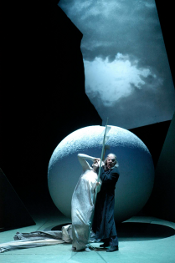 Scene from Siegfried
Scene from Siegfried
In a world poor in great Wagnerians, the Opera did amazingly well by engaging several maestros, each of whom brought his particular stamp to the performances. Jonas Alber, who has conducted numerous Ring cycles at lesser houses, stepped in on short notice for the March 10 Rheingold, the opening opera of the tetralogy.
With the Saxon State Orchestra at his disposal, of course, Alber could hardly do anything wrong. Dating back to 1548, it is Germany’s oldest orchestra and among opera ensembles without its equal. Alber proved himself an experienced craftsman who brought coherence to the fragmented drama that Rheingold is.
Things moved in quite another direction when John Fiore took over the podium for Walküre. The still-youthful American, now at home at Germany’s Deutsche Oper am Rhein, the joint venture that serves both Düsseldorf and Duisberg, is a passionate conductor who brought vivid animation to the tangled passions of the chapter of the story focused on the incestuous love match of twins Sieglinde and Siegmund.
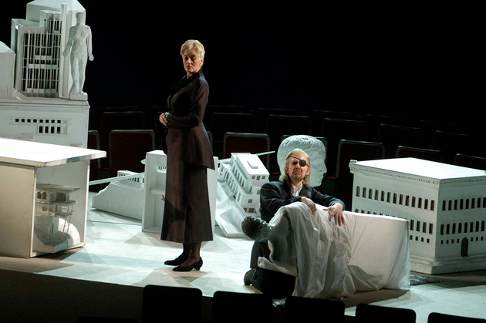 Scene from Die Walküre
Scene from Die Walküre
Next in line was Israel’s Ascher Fisch, who although not allowed to conduct Wagner in his homeland, has built a reputation as a major interpreter of his works in other countries. (Fisch conducts the new Tristan slated for Seattle in August.)
Alber returned to go beyond himself in making the final Götterdämmerung on March 17 overwhelming.
Watching the 100-plus musicians of the Saxon orchestra from the balcony in the fury of Act Three of the opera made clear that when Wagner is on stage in Dresden the ensemble is simply a member of the cast. The impassioned involvement experienced here — four harps, eight horns! — confirmed the world-class quality of the Semper Opera, currently celebrating its 25th season in the rebuilt historic house reduced — like the rest of Dresden — to ruins in the night of February 13, 1945.
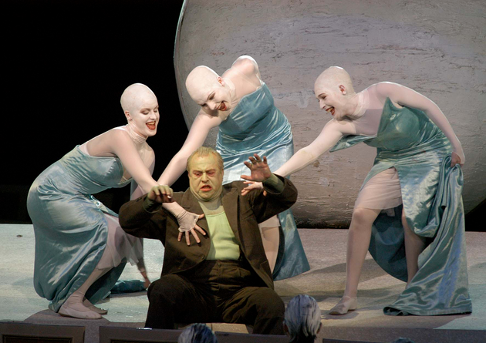 Scene from Das Rheingold
Scene from Das Rheingold
This Ring is further the first complete staging of the cycle in Dresden since World War Two. (In the earlier spring Ring Fisch conducted both Siegfried and Götterdämmerung.)
Wes Blomster
image=http://www.operatoday.com/03075f7399.png image_description=Scene from Götterdämmerung [Photo by Matthias Creutziger courtesy of Sächsische Staatsoper Dresden] product=yes product_title=Der Ring des Nibelungen product_by=Semperoper, Sächsische Staatsoper Dresden product_id=Above: Scene from GötterdämmerungAll photos by Matthias Creutziger courtesy of Sächsische Staatsoper Dresden
March 21, 2010
How a Coloratura Soprano Saved the Met
Dana Chivvis [AOL News, 20 March 2010]
Two weeks ago, the Metropolitan Opera in New York found itself in a predicament. Ten days before the opening night of “Hamlet,” a French opera that had not been performed there for 103 years, the production had no soprano. Natalie Dessay, who was scheduled to perform, had fallen sick and had to cancel.
The Cunning Little Vixen, London
what with this and The
Gambler, things seem to be looking up, following a dispiriting spell
in the Christof Loy doldrums. Indeed, the theatrical and musical magic woven
here could not stand further removed from the pretentious dreariness inflicted
upon new productions of Lulu
and Tristan
und Isolde. Bill Bryden’s production of The Cunning Little
Vixen was first staged in 1990 but, twenty years on, it is yet to look
tired. For this, William Dudley’s designs deserve a great deal of credit.
There is to action and staging a crucial sense of life, in all its complexity,
never more ambiguous than when it is apparently straightforward. The
life-cycle, human or animal — should the distinction even be made?
— is the guiding force, in every sense, of Janáček’s drama,
and so, appropriately enough, one sees a huge circle on stage, which provides a
treadmill for walking as well as a frame in which the first act’s
acrobatic ‘Spirit of the Vixen’ may swing. Here, form is wondrously
imparted to the Vixen’s dream, both for the eye and the ear. Humour,
arguably more immediate, if less idiomatic, when sung in English, was present
too, for instance in the portrayal of the clannish farmyard hens, large and
contented, unable to heed the Vixen’s siren-voice of feminist revolt. It
is, however, the interplay between wondrous machinery and Nature that
penetrates to the very heart of the opera. This both highlighted such
relationships in the score and put me in mind of another Royal Opera
production: David McVicar’s Magic Flute — never more
magical than when heard under Sir Colin Davis (available on DVD). Lighting
(Paule Johnson), colours, and scenery ensure that Nature is present,
overflowing in her abundance, without being domesticated or prettified; for
there is wildness aplenty in Janáček’s score, and this must be
reflected in the action.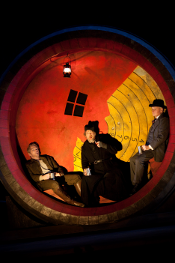 (Left to Right) Christopher Maltman as Forester, Jeremy White as Priest and Robin Leggate as Schoolmaster
(Left to Right) Christopher Maltman as Forester, Jeremy White as Priest and Robin Leggate as Schoolmaster
It must, of course, above all be expressed by the orchestra, and so it was here. The name of Sir Charles Mackerras is so indelibly associated with Janáček’s music that one might take for granted his excellence. However, I doubt that even the most jaded listener — note that one must listen, rather than passively consume — could have done so in this case. The angularities of Janáček’s score, so often ironed out by conductors not so intimately attuned to the idiom, were immediate and telling, but they were always integrated into a longer line, never aggressive, let alone exhibitionistic, for their own sake: the opposing temptation to smoothing out. Equally apparent, and again never merely for their own sake, were the ravishing beauties of the score’s extraordinary sound-world — extraordinary even by Janáček’s standards. One example would be that utterly characteristic high string sound, split into several parts, which one might be tempted to call Straussian, but which is in reality quite different, if anything more akin to the Schoenberg of Gurrelieder. (Janáček was greatly interested in the music of the Second Viennese School.) Building of climaxes was masterly, above all in the great, pantheistic conclusion, so redolent, or rather prophetic, of the Glagolitic Mass. Life goes on, yet is transformed, transfigured. Tension had sagged slightly, I thought, both on stage and in the musical performance, during the first half of the third act, but this conclusion certainly compensated. As Sir Charles’s aforementioned knighted colleague sounds so effortlessly right in Mozart, so does Mackerras in Janáček. How odd, then, that this was the first time he had conducted the work at Covent Garden, though not quite so odd as the fact that Bryden’s production has no predecessors in the house. (Having said that, The Cunning Little Vixen received its Paris premiere as recently as 2008, and then in a production borrowed from Lyons.)
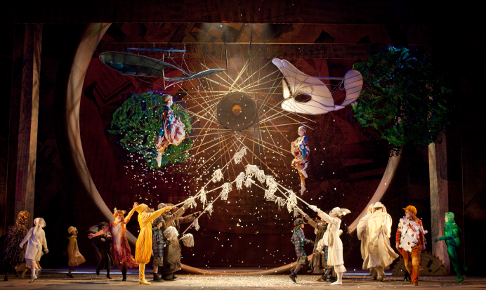 A scene from The Cunning Little Vixen
A scene from The Cunning Little Vixen
If Mackerras and the orchestra, which throughout played superlatively, a match for any other ensemble, were the brightest stars in the firmament, then they were ably supported by much of the cast. Most impressive of all was Christopher Maltman, whose Forester grew in stature, as he should, as the work progressed. The final transfiguration was as much his as the natural world’s. Elisabeth Meister, a Jette Paker Young Artist, had originally been slated to sing the roles of the Rooster and the Jay, but had to replace Emma Bell at very short notice, the latter having been rushed to hospital for an emergency appendectomy. Meister proved a winning replacement, moving in her love for the Vixen: an anthropomorphic fantasy, maybe, but an irresistible one. Sadly, Emma Matthews brought no especial individuality to the title role, though she did nothing especially wrong either. Many of the smaller roles, however, were sharply etched, most memorably Matthew Rose’s poacher, Harašta, Robin Leggate’s lovelorn Schoolmaster, and Jeremy White, both as priest and badger. The children, drawn from various London schools, did not disappoint either.
Performance in English did not disconcert me as much as I had feared. There is loss, of course, in terms of the music’s relationship to the language’s speech-rhythms, but this registered less than it had during ENO’s Katya Kabanova earlier in the week. Perhaps it was a better translation; there was certainly more opportunity, often very well taken, for wit. Banking jokes may be easy, but sometimes we should be grateful for any weapon we have. One gripe though: why start at 8 p.m.? It made no especial difference to me, but a 7.30 start would have been of help to those who had to travel out of London, or who simply wished to dine a little earlier. Such practical reservations should not detract, however, from a triumphant return to form for the Royal Opera.
The Cunning Little Vixen will be broadcast by BBC Radio 3 on Saturday 15 May at 6 p.m.
Mark Berry
image=http://www.operatoday.com/VIXEN-2010_01269-MATTHEWS%20AS%20VIXEN%20%26%20CARR%20AS%20HARE-%28C%29PERSSON.png image_description=Emma Matthews as Vixen Sharp-Ears and Marnie Carr as Hare [Photo by Johan Persson courtesy of The Royal Opera House] product=yes product_title=Leoš Janáček: The Cunning Little Vixen (sung in English) product_by=Vixen Sharp-Ears: Emma Matthews: Gamekeeper: Christopher Maltman; Fox: Elisabeth Meister; Schoolmaster/Mosquito: Robin Leggate; Gamekeeper’s Wife/Owl: Madeleine Shaw; Priest/Badger: Jeremy White; Harašta: Matthew Rose; Innkeeper’s Wife: Elisabeth Sikora; Pásek: Alasdair Elliott; Pepík: Simona Mihai; Frantík: Elizabeth Cragg; Rooster/Jay: Deborah Peake-Jones; Dachshund: Gerald Thompson; Forester’s Wife: Madeleine Shaw; Cricket: Peter Shafran; Caterpillar: Talo Hanson (front), Korey Knight (back); Young Vixen: Eleanor Burke; Blue Dragonfly: Tom Sapsford; Spirit of the Vixen: Lyn Routledge; Chief Hen: Glenys Groves; Woodpecker: Amanda Floyd; Hare: Marnie Carr; Flies, Foxcubs, Other Children, Dancers. Director: Bill Bryden; Designs: William Dudley; Lighting: Paule Constable; Movement: Stuart Hopps. Royal Opera Chorus (chorus master: Renato Balsadonna); Orchestra of the Royal Opera House; Sir Charles Mackerras (conductor). Royal Opera House, Covent Garden, London, Friday 19 March 2010. product_id=Above: Emma Matthews as Vixen Sharp-Ears and Marnie Carr as HareAll photos by Johan Persson courtesy of The Royal Opera House
March 18, 2010
New World order dominate line up for this year's Edinburgh International Festival
By Tim Cornwell [The Scotsman, 18 March 2010]
THE voices of the New World return to the old in this year’s Edinburgh International Festival. A flamboyant, colourful, thunderous line-up focused on Latin America and the United States ranges from the Grammy award-winning gospel group the Blind Boys of Alabama, to Australian opera, Brazilian dance and some of the world’s greatest orchestras.
Handel Festival: Apollo e Dafne and selected arias
By Alexandra Coghlan [MusicalCriticism.com, 18 March 2010]
Lucy CroweThere seems to be something of a curse blighting London’s tenors at the moment; hot on the heels of Domingo’s withdrawal from Tamerlano we had both John Tessier and his understudy unable to perform in ENO’s Elixir (resulting in a polyglot performance, with guest tenor Edgaras Montvidas singing in Italian while the rest of the cast continued in English), and last night’s Handel Festival concert continued in this vein with tenor Simon Wall unable to perform.
This Prince: What a Piece of Work
By Anthony Tommasini [NY Times, 18 March 2010]
The Metropolitan Opera under general manager Peter Gelb is defining itself through the choice and quality, however debatable, of its ambitious new productions. Yet bringing successful existing productions of overlooked works to the Met is just as important to the company’s artistic mission, not to mention a safer bet. And few operas have been as overlooked as Ambroise Thomas’s “Hamlet.”
New soprano finding her footing in Lyric's ‘Figaro'
By John von Rhein [Chicago Tribune, 18 March 2010]
When persistent bronchitis forced Anne Schwanewilms to withdraw from the cast of Lyric Opera’s fine revival of “The Marriage of Figaro,” the company again turned to one of its own to help keep the show afloat. Replacing her for the remaining five performances of Mozart’s comedy is American soprano Nicole Cabell, who took over the role of Countess Almaviva on Monday, little more than a month after she portrayed Adina in the company’s “Elixir of Love.”
Thomas Adès in concert
By Joshua Kosman [San Francisco Chronicle, 18 March 2010]
The operatic concert paraphrase is one of the most time-bound of musical genres. It’s almost exclusively an artifact of the 19th century, an era when keyboard wizards were rife, operas were popular blockbusters, and home stereos didn’t exist.
March 17, 2010
The Saint of Bleecker Street, Marseilles
In his prize winning account of music in the twentieth century The Rest is Noise New Yorker magazine critic Alex Ross accords Menotti two mentions — 1) a composer invited into Jacqueline Kennedy’s newly art responsive White House, and 2) an openly gay composer. There is no reference to Menotti’s art perhaps because musically it was a dead end street, and because Menotti’s melodrama, like the broad, latter day melodramma of Italian verismo had soon morphed first into cinematic realism and then disappeared into populist television.
Ironically Menotti did leave a significant artistic legacy. He founded the Festivals of Two Worlds first in Spoleto (1958) and then in Charlotte (1977), stalwart bastions of everything that is progressive in opera and music — a contradiction left unaddressed by Alex Ross.
The Saint of Bleecker Street premiered in 1953, rife with the baggage of the post WWII era. This was when operatic art was expected to abandon its high perches and descend onto Main Street and long runs in Broadway theaters. The Saint of Bleecker Street endured 72 performances. Its has had sporadic revivals in the U.S., notably a 1978 televised version from New York City Opera with Catherine Malfitano (once a Marseilles Butterfly) and a 2007 revival at Central City Opera directed by Mme. Malfitano.
Immigrant life in New York, the quintessential melting pot of the early and mid-century America, is the background for Menotti’s tale of alienation, a subject deeply explored in the ’50’s by artists like Edward Hopper and George Tooker. In fact Tooker’s iconic painting of alienation The Subway (1950) was the basis of the design of the original Broadway production. But Menotti complicated his take on the alienation of Italian immigrants by slathering on a lurid, melodramatic overlay of questionable religious fervor.
If nothing more Menotti’s Broadway success spawned a true masterpiece, Leonard Bernstein’s West Side Story that had its premiere in 1956, just three years later. It is a work so similar in subject that its provenance from Menotti’s little opera is blatantly obvious. But where Bernstein incorporated and expanded the musical discoveries of the twentieth century in his score Menotti kept his tonalities banale and his structures derivative of traditional sources.
The Marseilles Saint of Bleecker Street production was in the hands of British director Stephen Metcalf and British designer Jamie Vartan (neither boast American credits) who placed all the action in a courtyard between two nineteenth century oddly un-New York tenement facades. This confined space supported the scene changes uncomfortably, cramping Menotti’s facile music into a dramatic focus it could not support. Missing was the punctuation of Broadway’s quick-change theatricality, changes that in fact Menotti cleverly incorporated into his descriptive music — à la Puccini.
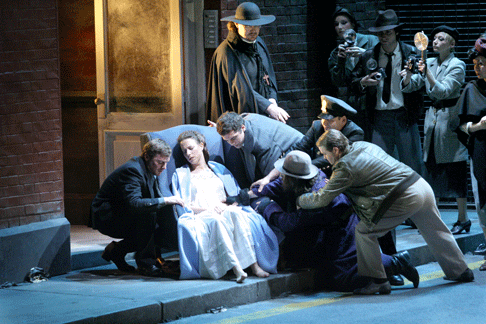
The Broadway style thrives on razzle-dazzle, and messieurs Menotti and Metcalf obliged with a couple of good, lively scenes — the murder of Assunta and the assumption of the Bleecker Street saint Annina — but the overall scenic rhythm was in fits and starts that missed a Broadway crescendo.
Somehow the underlying theme of incest was always gnawing, perhaps this was subtle direction by Mr. Metcalf or more likely it is latent Menotti, an active participant in the sexually giddy circles of New York’s artistic crème de la crème of that era. This thread carried a potential wallop that never materialized, impossible obviously for Main Street art of the 1950’s but not for the jaded sensibilities of this new century — a missed opportunity for a new production of this potentially shabby little shocker.
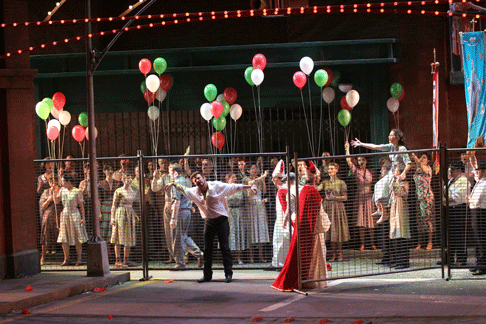
There was not an American in the cast, unusual for almost any opera production in the south of France these days. Though she gave a fine, detailed performance French soprano Karen Vourc’h did not capture a saintly rapture, or the crazed rapture of a consenting sexual victim. She was a too plain, too real Annina. Hungarian tenor Attila B. Kiss used a Broadway style voice to expound the trails of the lover Michele when a more beautiful voice could have added dimension to this role. His too careful enunciation of the American underscored the homelessness of this Marseilles production.
Armenian mezzo soprano Juliette Galstian was a good Assunta, capturing a convincing, grandly temperamental jealousy as Michele’s jilted girl friend. But her character was betrayed by the too stylish lines of her costume, in fact the period haute couture look of all womens’ costumes in this production was more important than the character they clothed (a typical complaint to the hereabouts ubiquitous costume design of Katia Duflot).
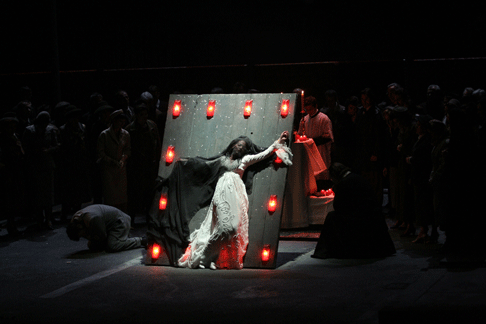
Russian bass Dmitry Ulyanov was a fish-out-of-water as the priest Don Marco, simply to young and too green to inhabit the soutane of the spiritual and temporal shepherd of Menotti’s needy Italian immigrants. The myriad of supporting roles were however well cast and uniformly effective.
British conductor Jonathan Webb played the Menotti score for all it was worth. The Friday (02/19/10) evening audience indicated by its warm but limited enthusiasm that it had not been duped into believing it had had a significant opera experience.
Michael Milenski
image=http://www.operatoday.com/Bleeker01.gif imagedescription=Photo by Christian Dresse courtesy of Opéra de Marseille
product=yes producttitle=Gian Carlo Menotti: The Saint of Bleecker Street productby=Annina: Karen Vourc’h; Assunta: Juliette Galstian; Carmela: Pascale Beaudin; Maria Corona: Sandrine Eyglier; Desideria: Giuseppina Piunti; Michele: Attila B Kiss; Don Marco: Dmitry Ulyanov; Salvatore: Marc Scoffoni. Orchestra and Chorus of the Opéra de Marseille. Conductor: Jonathan Webb. Stage Director: Stephen Medcalf. Set Design: Jamie Vartan. Costumes: Katia Duflot. Lighting Design: Simon Corder. product_id=Photos by Christian Dresse courtesy of Opéra de Marseille
Les Troyens at Carnegie Hall
Every hearing brings new beauties to attention, each representation attains new miracles — and every staging (at least, of the several I have seen) has lacked something essential, done something inane that ought to have been serious or something ponderous that ought to have been gossamer.
Berlioz, a traditionalist revolutionary, left none of the tools he made use of as they stood but developed the traditions on offer. From Gluck (and Lully and Cherubini) he took a style of declamatory singing that makes up in hieratic dignity for what it sometimes lacks in the sheer sensuousness of the contrasting Italian manner — though nothing in opera surpasses the quintet-septet-love duet sequence in Act IV of Les Troyens for sheer throbbing passion.
The forms in Les Troyens are traditional: soliloquy aria, aria with chorus, duet, concertato, ballet interlude, orchestral entr’acte, war chorus — but Berlioz employs none of them casually. Each verse of a strophic melody differs from each other, no line of a melody is repeated without altering an instrumental color, brightening the effect, speeding up or slowing down to suit the dramatic pulse of the scene. No matter how familiar the score, it is still full of undiscovered wonders. This is meat only for the most intent of conductors and the most committed singers.
All this being so, and staged performances being rare (in New York, we see it once a decade), a concert performance is no poor compromise, especially if the performers are worthy of the ambitions of a Berlioz. The chorus and orchestra of St. Petersburg’s Mariinsky Theatre, trained on the over-the-top grandeur of Russian epic opera, are clearly primed for Les Troyens, and the dynamic Valery Gergiev is a proven hand with this most idiosyncratic of composers. The only dubious side of the enterprise is the French accent of the Russian soloists — and those who are used to, say, Anna Netrebko’s Antonia or Manon will hardly find anything to object to even here. (Madame Netrebko was in the audience at Carnegie Hall, cheering on her old pals.)
With no sets to distract the eye and no choreographers to embarrass us during the ballets — not to mention no director’s follies to interrupt the orchestral interludes — Maestro Gergiev seems to have felt it wiser to do the piece in two parts, La Prise de Troie and Les Troyens à Carthage, as it often used to be staged. This stratagem kept the orchestra and the tenor fresh for the second evening. (Berlioz lovers in New York, to be sure, might have preferred to have it all on Tuesday and repeat it all on Wednesday, and we would have attended both evenings.)
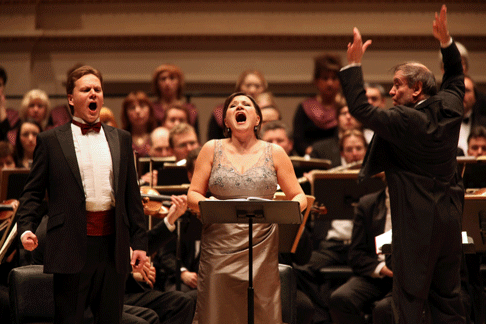 Alexei Markov (Chorèbe) and Ekaterina Gubanova (Cassandra)
Alexei Markov (Chorèbe) and Ekaterina Gubanova (Cassandra)
First of all: a word about the orchestra, which played five hours of music without a single brass misfire or a mis-cue of the backstage band on its several entrances, a lush, various, delirious, precise reading, heartily theatrical as a theater orchestra should be. The chorus were solid as well. Gergiev, who leads without a podium, waggles his fingers as much as his stick, and dances in place, and clearly everyone knows what each wiggle implies. I sat in the orchestra on both nights, and did wish for an opportunity to hear the whole score again (immediately!) from the higher reaches of the hall, where the sound in more orchestrally intricate works like this one can attain a still more magical imprint.
Ekaterina Gubanova, who has been miscast at the Met (Giulietta? c’mawn!), sang Cassandra with great distinction and dignity and a well-managed rise to the top in a role often given to sopranos. Her thunder was rather stolen on the second night, when Ekaterina Semenchuk, the delicious Olga of last year’s Met Onegin, gave a passionate, tremendously involved account of Didon. She never stood still when “acting,” but emoted fervently, and her eyes grew warm with passion, sick with despair, while her voice, once it was warmed up, filled the house with urgent appeal — in very decent French, moreover. When she was not singing, she was clearly following every word and emotion of the score. There are other ways to perform this wonderful role — New Yorkers have been spoiled by Christa Ludwig, Shirley Verrett, Tatiana Troyanos peerless in passion, Jessye Norman’s hauteur, and Lorraine Hunt Lieberson’s lieder-singer attention to the detail of each phrase — but Semenchuk’s turn matched them in memorability. In the smaller female roles, I especially liked the glowing low notes of Zlata Bulycheva’s Anna.
Not even Valery Gergiev can conjure first rate tenors out of the thin air of Muscovy, where — perhaps due to early Russian Orthodox church music training (although that didn’t hold back Nicolai Gedda) — low voices tend to be the top grade ones: Russia has always been more famous for basses and mezzos than for tenors and sopranos. Sergei Semishkur declaimed expressively and got over the high passes without coming to grief, but his voice is hardly Heppner pretty or Vickers intense, and as for his French diction — well, it was clear that this is no longer the second language of St. Petersburg, as it was in Tolstoy’s day. Daniil Shtoda, an effective lyric tenor, sang Iopas’s aria with the proper courtly elegance, but Dmitry Voropaev, though possessing a good basic sound, phoned in Hylas’s music with a bad accent and none of that air’s delicate homesick sadness.
Alexei Markov’s Chorèbe was sung with ardent dignity and grace, Yuri Vorobiev sang a fine Narbal, and Alexander Nikitin and Timur Abdikeyev, who covered most of the small, lower roles agreeably, were especially charming in the comical duet for two Trojan sentries.
These were two long, long opera concerts that one wished would never end.
John Yohalem
image=http://www.operatoday.com/Gergiev_Troyens_CH.gif image_description=Valery Gergiev [Photo by Steve J. Sherman] product=yes product_title=Hector Berlioz: Les Troyens product_by=Cassandra: Ekaterina Gubanova; Didon: Ekaterina Semenchuk; Anna: Zlata Bulycheva; Enée: Sergei Semishkur; Iopas: Daniil Shtoda; Hylas: Dmitry Voropaev; Chorèbe: Alexei Markov; Narbal: Yuri Vorobiev. Chorus and Orchestra of the Mariinsky Theatre, led by Valery Gergiev. At Carnegie Hall, Part 1 on March 9, Part 2 on March 10. product_id=Above: Valery Gergiev [Photo by Steve J. Sherman]Concert of Arias by Arizona Opera
Generally, one goes to the opera to hear an entire masterwork, but here we were treated to a succession of the arias and ensembles that have helped to make the operas which contain them famous. It was a perfect program for introducing people to opera and quite a few young faces were to be seen in both the Tucson and Phoenix theaters.
On March 6 in Tucson and March 12 in Phoenix, Arizona Opera presented this evening of arias and ensembles together with a few orchestral excerpts. At the Tucson concert, mezzo-soprano Daveda Karanas substituted for Dolora Zajick who was ill. Karanas won the Metropolitan Opera National Council Auditions in 2008 and was later awarded an Adler Fellowship at San Francisco Opera. She has a smooth, buttery quality to her voice and she sang the aria, ‘La luce langue,’ from Verdi’s Macbeth with considerable dramatic power. Her rendition of ‘O don fatale' from the same composer’s Don Carlo soared over the orchestration with sumptuous tones as did her lines in the Bellini duet ‘Mira, o Norma’
On March 12, the Phoenix concert featured soprano Christine Brewer,
mezzo-soprano Dolora Zajick, tenor Richard Margison and baritone Gordon Hawkins
along with the Arizona Opera Orchestra directed by Joel Revzen. The opening
selection was the overture to Wagner’s Die Meistersinger and it
served to show that this group of players has become an excellent orchestra
capable of playing the most complex music with ease. The brass instruments, in
particular, produced a sumptuous expanse of blended sound.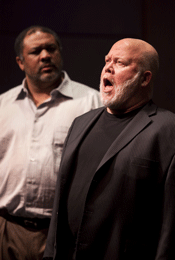 Gordon Hawkins and Richard Margison
Gordon Hawkins and Richard Margison
The vocal program opened with Christine Brewer singing a rousing version of ‘Abscheulicher! Wo eilst du hin?’ from Beethoven’s Fidelio and she set a very high standard for the rest of the concert. She and Richard Margison then sang the duet from the last act of that same opera with great intensity and resonance.
Gordon Hawkins sang ‘Eri tu’ from Verdi’s Un ballo in maschera with dark and robust tonal colours. Later, he would perform Jack Rance’s aria ‘Minnie dalla mia casa’ from Puccini’s La fanciulla del west and join Margison in the duet ‘Dio, che nell’alma infondere’ from Verdi’s Don Carlo. All of Hawkins’ singing was powerful and passionate but, unfortunately, he had a persistent excess of vibrato on his top notes.
Dolora Zajick first sang ‘La luce langue’ from Verdi’s Macbeth. Her ability to act with the voice is legendary, and she put it to good use here. Later her luminous, powerful voice was heard in a riveting ‘O don Fatale’ and a resplendent rendition of the duet ‘Mira o Norma’ with Brewer. Richard Margison delved into Puccini for ‘Nessun dorma’ from Turandot and concluded with the Prize Song from Die Meistersinger. He delivered both selections with keen intelligence and blazing high notes.
The orchestra, seated on stage instead of hidden in the pit for a change, played several pieces that its members might not normally get to perform: the overture to Tchaikovsky’s The Queen of Spades, the overture to Verdi’s Luisa Miller and the Intermezzo from Puccini’s Manon Lescaut. Revzen is a fine interpreter of Russian music and he brought out all the fine points of the Tchaikovsky. The Luisa Miller is a very difficult piece and it served to show that this group could perform the most detailed music with consummate accuracy. Although Puccini wrote his Manon at the beginning of his career, his unique sonorities cut right to the emotions of the listener.
Brewer brought this wonderful concert to a close with a lyrical but full-powered rendition of the Liebestod from Wagner’s Tristan und Isolde. Needless to say, the applause at the end was deafening, but it only started after a moment in which the listeners continued to absorb the emotional impact of the music. Next season Arizona Opera will perform five fully staged operas instead of four and a concert. Perhaps in a future year they will again give us a concert similar to this truly memorable evening.
Maria Nockin
image=http://www.operatoday.com/AZ_Opera_02.gif image_description=Christine Brewer [Photo by Tim Fuller / Arizona Opera] product=yes product_title=Arias by Arizona Opera product_by=Christine Brewer, Dolora Zajick (March 6, 12, 14), Daveda Karanas (March 7, 13), Richard Margison and Gordon Hawkins. Arizona Opera. Joel Revzen: Conductor. product_id=Above: Christine BrewerAll photos by Tim Fuller / Arizona Opera
Katya Kabanova, London
Therein, perhaps, lies the one weakness in this powerful and impressive staging. For Janačék’s opera, while admittedly melancholic and menacing, contains contrasting moments of ecstatic joy, matched by melting sonic radiance — moments which resonate with gleams of light and colour, but which were almost wholly subdued by the sinister grey tones of Alden’s vision.
Alden knows this territory well, as his 2006 Jenůfa and more
recent Peter Grimes testify. The slanted perspective of the steeply
raked set, lend an air of edginess. Sudden and extreme changes of lighting
(designed by Adam Silverman) cast monstrous shadows across the immense expanses
of the bare, decrepit stage, its distressed emptiness broken only by a lone
chair, a single lamp-post. All seems somewhat familiar … And indeed, as
an abstract portrait of torment and pain, it serves its purpose well. Yet, the
very vastness of this landscape makes it difficult to convey the claustrophobic
tension which suffocates the eponymous protagonist. Set in a stifling,
provincial community, Katya Kabanova relates the persecution and
destruction of a pure heart; Katya battles with her inner demons and struggles
against the mean-spirited hypocrisy of the mercantile Russian villagers who
judge her. It is the explosive shattering of the chains that bind her soul and
body that destroys the village’s self-righteous complacency, and propels
Katya to tragedy — Ostrovsky’s play, on which the opera is based,
is aptly called ‘The Storm’. But Charles Edward’s design,
which suggests the infinite vistas of the Siberian steppes, does not capture
the constriction and restriction which is both within and without the tragic
heroine.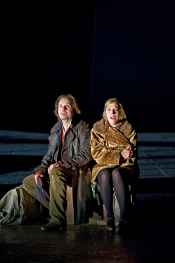 Alfie Boe as Vanya Kudrjas and Anna Grevelius as Varvara
Alfie Boe as Vanya Kudrjas and Anna Grevelius as Varvara
The characterisation of Katya by American soprano, Patricia Racette, making her debut at ENO, was in accord with Alden’s expressionistic conception. Her total isolation was sustained throughout, her psychological and spiritual distance from the other characters and her yearning for escape suggested by her frequent positioning at the furthest edges of the stage. Isolation increasingly became self-absorption; separated by the entire width of the stage, Katya and her lover, Boris (Stuart Skelton), seemed emotionally disconnected — Racette’s Katya is more in love with love than with this weak, pitiful merchant. Confident and sure throughout, Racette was certainly technically in command of the role. Yet, when Katya sings to Varvara in Act 1 of her youthful dreams, her melody should float and soar as easily and freely as the birds she has longed to emulate. Racette’s strong tone, together with a tense, close vibrato, seemed too mature, and lacked the sweetness and air of fragility which might express her essential innocence.
Janačék’s compression of Ostrovsky’s drama does to some extent render the characters one-dimensional. But Alden, and his costume designer, Jon Morrell, take this one step further, and reduce nearly all the other roles to caricatures. A floor-length black cloak hiding a glittering red gown, topped with a threatening, pointed headpiece, Susan Bickley’s Kabanicha is a terrifying figure of authority and intimidate — the stereotypical butt of all mother-in-law jokes, she resembles a vicious Lady Macbeth, dominating and demeaning all. Bickley’s full, true tone fortunately prevented this harridan from sounding as well as looking shrew-like; but, should she really so openly acknowledge her own hypocrisy and sexual avarice, brazenly turning the disapproving gaze of a religious icon to the wall before subjecting the willing Dikoy (Clive Bayley) to some degrading sexual bullying?
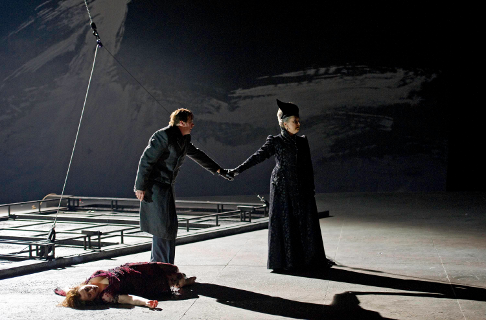 Susan Bickley as Marfa Kabanicha and John Graham-Hall as Tikhon Ivanich Kabanov
Susan Bickley as Marfa Kabanicha and John Graham-Hall as Tikhon Ivanich Kabanov
The men, on the whole, were a pitiful and contemptible bunch. Both Boris and Tikhon are weak-willed, self-preserving specimens. Skelton sang lyrically, but his tone was rather lifeless — there was little to suggest that he could inspire Katya to such heights of passion. John Grahan Hall’s Tikhon was a wretched victim of his mother’s oppression, and at times he communicated the pathos of his situation, although like Bayley’s Dikoy, his mannerisms were frequently too exaggerated and over-blown. It was left to Anna Grevelius as Varvara and Alfie Boe as Kudrjas to introduce some convincing humanity into this community of grotesques. The brightness and energy of their singing injected a convincing sense of fun and spirit, Boe’s warm tone in particular conveying the optimism of youth. The healthy, down-to-earth practicality of this pair of lovers presented a stark contrast to the self-destructive, dreamy solipsism of Katya and the directionless ineptitude of Boris.
From the opening bars, where muted lower strings tenderly evoke Katya’s purity of spirit and the frailty of her hopes, as well as the dark depth of the river which will claim both, Mark Wigglesworth draw from his orchestra playing of exceptional clarity and rhythmic vitality. The layered textures of Janačék’s driving motifs were expertly constructed, each melodic pattern contributing to the meaning of the whole. Wigglesworth effectively built up the tension in Act 3, confidently controlling both the rhythmic onslaught and the silences, as the drama lurched to its bitter conclusion.
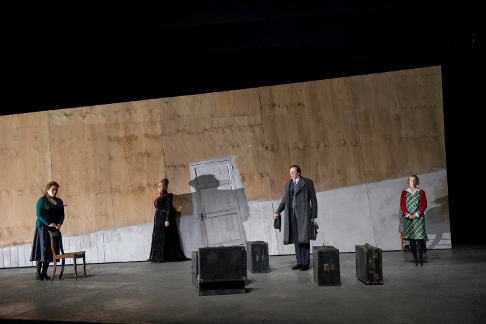 Patricia Racette as Katerina Kabanova, Susan Bickley as Marfa Kabanicha, John Graham-Hall as Tikhon Ivanich Kabanov and Anna Grevelius as Varvara
Patricia Racette as Katerina Kabanova, Susan Bickley as Marfa Kabanicha, John Graham-Hall as Tikhon Ivanich Kabanov and Anna Grevelius as Varvara
On stage, in contrast to this detailed musical drama, the semiotics were unashamedly blatant. A vast propaganda poster depicting a Munch-like impression of hell prophesised damnation, its fall to the ground foreshadowing Katya’s own suicidal descent into the waters of the Volga. Why does she confess and leap into the treacherous waters? Katya is a victim not just of her own conscience. In such a soul-destroying, emotionally-deadened world, her innate life-spirit and passion can only find an outlet in religious devotion. And, she is watched and judged not just by God but by the Kabanicha and the village she represents. Thus, Katya is sacrificed to preserve a self-satisfied and repressive regime. However, in Alden’s view, Katya is as alone in death as she has been in life. Having reduced the repressive village to a few grotesque eccentrics, even the latter are distanced at the close, emotionally removed from the human loss which is so profoundly and poignantly conveyed in the music.
Claire Seymour
image=http://www.operatoday.com/Katya_Kabanova_001.png image_description=[Photo by Clive Barda courtesy of English National Opera] product=yes product_title=Leoš Janačék: Katya Kabanova product_by=Katerina Kabanova: Patricia Racette; Marfa Kabanicha: Susan Bickley; Varvara: Anna Grevelius; Boris Grigoryevich: Stuart Skelton; Vanya Kudrjas: Alfie Boe; Tikhon Ivanich Kabanov: John Graham-Hall; Dikoy: Clive Bayley. Director: David Alden. Conductor: Mark Wigglesworth. English National Opera, London Coliseum. Monday 15th March 2010. product_id=Above: Patricia Racette as Katerina KabanovaAll photos by Clive Barda courtesy of English National Opera
STORACE: Gli Equivoci
Music composed by Stephen Storace. Libretto by Lorenzo da Ponte, after William Shakespeare's The Comedy of Errors, translated into English by Arthur Jacobs.
First Performance: 27 December 1786, Burg, Vienna.
| Role: | |
| Eufemio of Syracuse, son of Egeon and twin brother of Eufemio of Ephesus | Tenor |
| Dromio of Syracuse, servant of Eufemio of Syracuse and twin brother of Dromio of Ephesus | Baritone |
| Eufemio of Ephesus, son of Egeon and twin brother of Eufemio of Syracuse | Tenor |
| Dromio of Ephesus, servant of Eufemio of Ephesus and twin brother of Dromio of Syracuse | Baritone |
| Silinus, Duke of Ephesus | Baritone |
| Egeon, a merchant from Syracuse | Baritone |
| Sofronia, wife of Eufemio of Ephesus | Soprano |
| Sostrate, sister of Sofronia | Soprano |
| Angelo, a goldsmith | Baritone |
| Lesbia, wife of Dromio of Syracuse | Soprano |
| Dromia, young child of Lesbia and Dromio of Syracuse | Soprano |
Synopsis
Act I
A violent storm shipwrecks Euphemio of Syracuse and his servant — unluckily they have arrived at Ephesus where any Syracusan must pay a ransom or face execution. Meanwhile in the city the elderly Aegeon is under that very sentence. However, his story moves the Duke Solinus to grant him a day's remission: Aegeon had been searching for his twin sons (with their twin servants), one of whom had been lost in another storm many years ago.
When Euphemio and Dromio slip into the city, every separation and meeting between them brings inexplicable misunderstanding, and they soon fear the presence of witchcraft. When they meet with two beautiful sisters, Euphemio is roundly berated by Adriana, who claims him as her philandering husband. Eventually he gives way and goes in to dine with Adriana and Luciana, whilst Dromio is posted to keep watch at the gate.
Meanwhile, Adriana's real husband, Euphemio of Ephesus, is counselled by the goldsmith Angelo from whom he has ordered a chain. His servant Dromio is attacked by a raving woman, Lesbia, who claims to be his long-abandoned wife. The Ephesians are horrified when they are refused entry to their own home, and they angrily attempt to beat down the door. Mounting confusion turns to mayhem, and everyone fears the arrival of the night-watch.
Act II
Further misunderstandings develop around the delivery of Angelo's gold chain, and Euphemio of Ephesus tries to track down his 'unfaithful' wife. The Syracusans remain perplexed when everybody addresses them – strangers in the city — by name. Euphemio of Syracuse attempts to woo Luciana, who is incredulous at the duplicity of her 'brother-in-law'. Euphemio of Ephesus is arrested for failing to pay for the chain, and in prison Angelo disguised as a magician tries to exorcise the 'lunatic'. Lesbia at last comes across her lost husband, Dromio of Syracuse, and confronts him with their child, Dromia.
In the town square, as the Duke prepares for the execution of Aegeon, Adriana petitions him for help over the irrational behaviour of her husband. When all parties gather, the true extent of the comedy of errors is revealed.
[Synopsis Source: Bampton Classical Opera]
image=http://www.operatoday.com/comedy.png image_description=Stephen Storace: The Comedy of Errors (Gli Equivoci) audio=yes first_audio_name=Stephen Storace: The Comedy of Errors (Gli Equivoci) first_audio_link=http://www.operatoday.com/Gli_equivoci.m3u product=yes product_title=Stephen Storace: The Comedy of Errors (Gli Equivoci) product_by=Adriana: Janet Price; Luciana: Eiddwen Harry; Eufemio of Ephesus: Kenneth Bowen; Eufemio of Syracuse: Neil Jenkins; Dromio of Syracuse: Alan Watt; Dromio of Ephesus: Malcolm King; Duke Solinus: John Tomlinson; Aegeon: Colin Wheatley; Angelo: Leslie Fyson; Lesbia: Della Jones. BBC Northern Symphony Orchestra. Steuart Bedford, conducting. Live performance, London, 10 December 1977.
Debussy’s Pelléas et Mélisande
Just as the desire for empathy as the basis for aesthetic experience finds satisfaction in organic beauty, so the desire for abstraction finds its beauty in the life-renouncing inorganic, in the crystalline, in a word, in all abstract regularity and necessity…
Thus all transcendental art sets out with the aim of de-organicizing the organic, i.e. of translating the mutable and conditional into values of unconditional necessity. But such a necessity man is able to feel only in the great world beyond the living, in the world of the inorganic. This led him to rigid lines, to inert crystalline form. He translated everything living into the language of these imperishable and unconditional values. For these abstract forms, liberated from all finiteness, are the only ones, and the highest, in which man can find rest from the confusion of the world picture. (Abstraktion und Einfühlung, 1907)
The present DVD is Worringer’s dream production of the Debussy opera: the stage set consists of slabs of stone, a slab of light atop a thick low turret, white outlines of boxes made of thin planks, and a curved background of whitish corrugated iron; the colors vary from gray to silver to celadon; a layer of snow covers the stage floor and snow occasionally falls from above. The ostumes of the male singers are decorated with scenes that seem to be abstractions of lunar craters and other extraterrestrialities. The director, Sven-Eric Bechtolf, listened carefully when Golaud said, “This castle is very cold and very dark.”
Maeterlinck was in some sense an abstractionist, interested in a kind of théâtre pur in which the fairy-tale, art-nouveau-Medieval staging stylized human life into something simple and intense and stark. But it’s far from clear that his abstractions are to be considered in any sense chill: his plays aren’t about ascending into the imperishable and unconditional, not about finding rest from the world’s confusion, but about tracing the paths of perishable and confused things in as lucid a manner as he could. Antarctica isn’t quite the right venue for the words or the music, although there is some sense in which the characters inhabit a Fortress of Solitude. Still, when Mélisande says that she can’t take Pelléas’s hand because her arms are full of flowers, and we see her holding a heap of snow, the stage picture touches on something true to the opera’s aesthetic, the way in which Maeterlinck’s seasons are all, in T. S. Eliot’s phrase, a zero summer.
This production shows its love for the abstraction not only through frigid geometries, but also through its predilection for dolls. Each character cohabits with a life-sized dummy, and in most scenes the singers sing not to one another but to the dummy of their interlocutor. When the singers actually turn toward their human counterparts, it creates a feeling of unusual intimacy: for example, when Golaud examines Mélisande’s hand, before discovering the absence of the wedding ring, he clasps both the dummy’s hand and the singer’s own—you can see how startled she is to feel a human touch. And when the singers turn away from their human counterparts to sing to the dummy, it creates a shiver of distance: most of the love duet (act 4, scene 4) has Pelléas and Mélisande singing human-to-human, but toward the end there is a section where she prefers the company of the dummy.
Here Mr. Bechtolf seems on firm ground with respect to Maeterlinck’s dramaturgy. Maeterlinck in many ways preferred puppets to human actors, and some of his finest plays were intended for marionettes. He had a dualistic imagination, and considered that the soul had little to do with the body and even the body’s passions:
What would happen, for example, if our soul suddenly became visible and she had to move forward into the midst of a gathering of her sisters, stripped of her veils, but laden with her most secret thoughts and dragging behind her the most mysterious acts of her life—acts that nothing could explain? What would make her blush? What would she want to hide? Would she start to throw, like a modest women, the long mantle of her hair over the numberless sins of the flesh? She did not know them, and these sins have never reached her. They were committed a thousand leagues from her throne; and even the Sodomite’s soul would pass in the midst of the throng without suspecting anything, and bearing in her eyes a child’s transparent smile. She hasn’t intervened, she spent her life close to the light, and this is the only life she will remember. (Le trésor des humbles)
In some sense Golaud has nothing to do with his jealousy, or Mélisande with her fragility: there is a part of each of us that is immune from the events of our lives, a part to which our very character traits are irrelevant. There is no reason why our soul—a perfectly uninflected thing—might not be properly represented by a doll.
But I’m not sure that the dolls in this production ever behave in a fashion congenial to Maeterlinck’s notion of the childlike pathos at the heart of the human subject. Sometimes they seem to represent social roles, the outer husks of personality that we display to our acquaintances and our lovers. Yeats thought that every love affair had four parties: him, her, his mask, her mask; and the Bechtolf production sometimes takes its cue from that logic. In the scene in which Mélisande carelessly tosses her ring above the Fountain of the Blind, Mr. Bechtolf provides us with four fountains: his, her, his dummies’, her dummies’; and Mélisande and her dummy each drop a ring into a fountain, Mélisande when she talks of letting her hair down into the water, the dummy when the ring is supposed to fall. At other moments, it seems as if the singer represents the character’s soul while the dummy represents the body: in act 5, the dummy lies in on the sick bed, while Mélisande wanders about the room, eventually finding Yniold’s big gold ball, and eventually leaves the stage, gaily tossing the ball, as the other characters weep over her dummy-corpse.
Mr. Bechtolf, I suspect, likes dummies mostly because you can inflict a lot of damage on them, and this is indeed the most violent production of the opera I’ve ever seen or heard of. Golaud tears off the arm of the dummy-Yniold in the course of persuading the boy to spy on Pelléas and Mélisande; and soon Golaud holds up the dummy’s severed head, the eyes glowing from within by electric light, in order to see what is above his range of vision. When Golaud swings Mélisande by her hair, left and right and right and left, the dummy must endure almost comical abuse. When Pelléas and Golaud edge along the wall of the subterranean vault, the Pelléas-dummy is enclosed in a glass cylinder, looking like a sleep-pod for interstellar trips in a science-fiction movie, and mad scientist Golaud turns on the valves of gas tanks in order to flood the cylinder with dense fumes—clearly Golaud has contrived the whole episode for the sake of persecuting Pelléas.
Some of the violence menaces the singers as well as the dummies. In the very first scene, Mélisande threatens to stab Golaud with a dagger as she recounts the harm she endured in her earlier life; and she threatens him again with a dagger as he murders Pelléas in act 4. I like this idea: Maeterlinck’s characters have interchangeably blank souls, and there might be murderous rage in Mélisande, just as there’s certainly a great deal of weakness and fragility in Golaud, a giant of a man, roaring like Othello, but a man who easily gets lost, and whose horse keeps falling on him—bramble patches trouble him, too.
The strangest, most imaginative touch is the presentation of the tower as a Citroën automobile locked in ice. Mélisande stands on top of it as she sings her haunting song and lets her hair down; Pelléas scrutizines her from the driver’s seat, through the car’s outside rear-view mirror, and traps her hair in the car door; eventually Golaud climbs out of the back seat and dismisses the young folk. This will be distasteful to some, but the peculiar suggestion of transient intimacy—necking in the auto in some secluded place, able to zoom away at a moment’s notice—I found moving. And Maeterlinck in some sense wanted to write plays about contemporaneous matters (and occasionally did write plays about contemporary life, such as Le bourgmestre de Stilmonde, 1918, concerning the mayor of a Belgian town during the Great War). He was fascinated by Ibsen’s experiment, in Ghosts, of finding an equivalent for the Necessary of Greek tragedy in congenital syphilis:
We can affirm that the poet who would find today, in the material sciences, in the unknown that surrounds us, or in our own heart, the equivalent of the fatality of the ancients, that is to say a predestining force as irresistible, as universally acknowledged, would for certain write a masterpiece. (Le temple enseveli)
I’m not sure that the world of the internal combustion engine provides much of the fatality of the ancients, but no one should reject out of hand the notion of providing contemporary touches to Maeterlinck—in some sense his plays are Modernist, and concern modern life.
The singing in the production is distinguished. László Polgár is the best Arkël I’ve ever heard—his cavernous voice gives a strong impression of just what Debussy said he wanted, a voice “d’outre-tombe.” Michael Volle’s Golaud is vehement, Wotan-like, somewhat in the manner of George London on the second Ansermet recording, though Volle’s voice is better focused—you often feel that he’s lacerating someone or something, his own heart if nothing else. Pelléas and Mélisande are both cast contrary to type, in enjoyable ways. The Pelléas, Rodney Gilfry, is strong in voice, slim and brawny in physique, a Pelléas unusually commanding, unusually dangerous, with a strong erotic presence—this may actually be closer to what Debussy wanted than the normal neuresthete—we might remember that Jean Périer, the first Pelléas, can be seen in old photos with a mustache and a beard. The Mélisande is Isabel Rey: her voice is richer and more vibrant (sometimes to the point of unsteadiness) than most Mélisandes, but the warmth was welcome in this lost-in-space production—all the singers sang with a humanity that counteracted the deadness of the dolls, the wheelchairs, the ice. The conductor, Franz Welser-Möst, led a taut performance, sometimes refreshingly fast (as in the conversation at the beginning of the scene in the seaside grotto), but full-throated and resplendent at the appropriate moments.
The last thing to mention is the quality of the Blu-ray DVD, almost hair-raisingly excellent: for example, the dark sparkle on the Pollock-like squiggles on the backdrop shone with such clarity that we might have been watching through an airless medium, as if the opera really did take place on the surface of the moon.
Daniel Albright
For standard DVD, click below:
image=http://www.operatoday.com/TDK_Pelleas.gif image_description=Claude Debussy: Pélleas et Mélisande product=yes product_title=Claude Debussy: Pélleas et Mélisande product_by=Pelléas: Rodney Gilfry; Mélisande: Isabel Rey; Golaud: Michael Volle; Arkel: László Polgár; Geneviève: Cornelia Kallisch; Yniold: Eva Liebau; Le berger: Guido Götzen; Le médecin: Guido Götzen. Zurich Opera House Chorus and Orchestra. Franz Welser-Möst, conductor. Sven-Eric Bechtolf, stage director. Rolf Glittenberg, set design. Recorded live from the Zurich Opera House, 2004. product_id=TDK DVBD-OPPEM [Blu-Ray DVD] price=$35.99 product_url=http://astore.amazon.com/operatoday-20/detail/B002USGXJCKarl Böhm: In Rehearsal and Performance
As effortless as those performances may see, Böhm worked to achieve the results, and as much as his legacy points to the work he would do in rehearsal, it is not easy to find visual documentation of it. Yet a fine DVD exists to call attention to this aspect of the conductor’s career. Recorded on 17 September (rehearsal) and 18 September 1970 (performance), this recording offers a welcome focus on the final preparations of a single piece from start to finish. While some recordings offer selections of rehearsal footage as a bonus or among the “extras” included with a video, the premise behind this release is the rehearsal. In doing so, it affords a glimpse at Böhm in rehearsal, where the formal face known from stills and several recordings gives way to the conductor’s involvement with the details of the score.
With the orchestra in shirtsleeves, the tone is set to show the conductor working out the details that make a difference in Strauss’s finely detailed score. While some of the stops may seem for minutiae, when taken together those refinements make the core come to live in performance. The subtleties of dynamics emerge in the first part of the rehearsal, and Böhm was good not only in attending to the mistakes, but also to call attention to places where the performances succeeded. In the reality of this rehearsal, Böhm is not merely running through the score for the sake of neither the camera nor positing an image of a tyrannical director. Rather, he reviews the details to his satisfaction, even when some of the players seem from their facial expressions to tire of the continual interruptions the conductor brings to the playing. After all, this is where the work needs such dissection, and the comments Böhm makes to the performers is crucial to the results he would bring to the performance.
Just as he would stop rehearsal to describe certain markings (like the “non espressivo” marking before rehearsal letter G), Böhm’s remarks over the music also help to show how he wanted to shape the interpretation. It is unusual to see this kind of detail used on a piece which some orchestras perform with less preparation, but the concepts he brought to this work would have a bearing on style Böhm brought to Strauss’s orchestral music. It is not difficult to imagine how he could shape the other tone poems, since the details in the released performances bear out such fine attention.
This video is an excellent opportunity to see Böhm working with his musicians in one of the more familiar pieces of orchestral repertoire. As much as the score is well known, he brings out details that not only address the color of the orchestration, and thus, the effects important to the tone poem, but also the articulations and other elements essential to punctuating phrases and placing emphases. Lengths of notes, pauses, and silence come into play as this score takes shape from the fine rendering the Vienna Philharmonic would be expected to give this or any work, to the distinctive way they present a reading under the leadership of Karl Böhm. It is interesting to see the rehearsal’s duration of forty-five minutes - about three times the length of the actual performance of the piece.
Those familiar with the conductor’s work should find this recording of interest for the insights it gives to the score of this familiar tone poem. Böhm emerges as demanding, but not obsessive, with the demands taken as a whole demonstrating the standards he would expect of his players. Just as studies of sketches and drafts should point to an increased appreciation for the finished works, this recording resembles such source studies in preserving the process that takes the orchestra into a polished execution. (The concert performance is offered in a single track, framed by a brief introductory trailer and the final credits.) While it is difficult to generalize from a single video like this one, Böhm’s rehearsal for this specific 1970 rehearsal of Don Juan serves to document the efforts of this highly respected conductor. Moreover, it offers a sense of the Vienna Philharmonic in the latter part of the twentieth century.
This DVD is in color, with crisp, clear images that suggest a documentary film rather than a televised broadcast. This makes it possible to observe accurately the gestures, body language, and demeanor of Böhm and his performers. More than that, the sound is clear and resonant, giving a good sense of the quality associated with Vienna’s Grosser Musikvereinssaal. Also, the navigation of this rehearsal documentary helps for those who would want to use the film in the classroom. Music students may gain an enhanced appreciation of this work when they see it in rehearsal and those unfamiliar with German benefit from the solid translations found in the subtitle track. All in all, the presentation and the content have much to recommend in this DVD, which documents the career of one of the outstanding conductors of the twentieth century. This is the first of several DVDs, which capture Böhm’s work, and we anticipate further releases under the label “Karl Böhm in Rehearsal and Performance.”
James Zychowicz
image=http://www.operatoday.com/EuroArts2072188.gif image_description=Bohm, Karl: In Rehearsal And Performance, Vol. 1 — Richard Strauss: Don Juan
product=yes producttitle=Karl Böhm: In Rehearsal and Performance, Vol. 1 — Richard Strauss: Don Juan productby=Wiener Philharmoniker. Karl Böhm, Conductor. Recorded Live at the Grosser Musikvereinssall, Vienna, 17-18 September 1970. productid=EuroArts 2072188 [DVD] price=$25.99 producturl=http://astore.amazon.com/operatoday-20/detail/B0014QNGX2
Philip Glass: Satyagraha, ENO, London 2010
Satyagraha doesn’t sound promising in theory, because it’s sung in Sanskrit and Glass’s repetitive monotones drone on shapelessly. But for once, that’s the whole point, that words alone are meaningless. Real change is brought about when people think and act.
The story is set in Gandhi’s youth, when he still believed that conventional, middle class ideas could change things. While he lived in South Africa, he was a facsimile of the British middle class intellectual, agitating through the press, hoping thus to change the entrenched colonial system.His big breakthrough came when he switched to direct action. By swapping his tweed three-piece suit for a simple cotton loincloth, he was making a truly radical statement: you don’t change the power structure by playing its own games.
Glass’s strange repetitive music works perfectly with the theme, too. His cadences hardly vary, so you worry that the musicians will get RSI. Yet listen carefully, and the repeats mutate in microtones, gradually shifting gears, so that when there’s a flight into lyricism, it strikes you all the more. This unrushed monotony is as natural as breathing. Hindus chant the word “Om” endlessly, until the vibration enters their bodies, allowing their minds to float, beyond consciousness. So it is with Glass’s music, informed by other and older traditions than western music.Your focus shifts inwards, beyond outward form.
There was exceptionally idiomatic playing from the ENO orchestra, conducted by Stuart Stratford. When the orchestra took their bows, parts of the audience went wild with enthusiasm. Clearly an audience that knows new music, or accepts it on its own terms. Satyagraha is the biggest selling contemporary opera the ENO has produced.
The text is in Sanskrit, which most people, including Indians, don’t understand. This is deliberate because what Gandhi discovered was that words and meaning aren’t the same thing. Hence the scene from the epic myth of Arjuna. The hero’s enemies are puppets, men with sticks who crumble when moved. Scene titles appear, like chapter headings in books, but what unfolds on stage isn’t narrative. Tolstoy and Tagore appear in panels above the stage. You don’t really need to know who they are, because the idea is that you’ll want to find out more, later.This opera moves outside the box in time and space!
There are so many amazing images in this production that it’s hard to take them all in at once. Some are striking, like the giant puppets that descend menacingly on Gandhi, corralled by bigots singing “hahahaha”. Others are elusive, like the fish which materializes in the second act. It doesn’t matter if we don’t get them all. Like words, images are hints of meaning, not meaning in themselves. Like poetry, meaning is oblique, revealing itrself slowly.
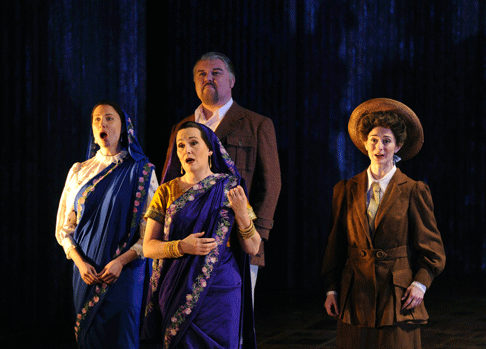 Stephanie Marshall as Kasturbai Gandhi’s wife, Elena Xanthoudakis as Miss Schlesen Gandhi’s secretary, Janis Kelly as Mrs Naidoo’s Indian co-worker and Ashley Holland Mr Kallenbach’s European co-worker
Stephanie Marshall as Kasturbai Gandhi’s wife, Elena Xanthoudakis as Miss Schlesen Gandhi’s secretary, Janis Kelly as Mrs Naidoo’s Indian co-worker and Ashley Holland Mr Kallenbach’s European co-worker
Because Glass’s music is so unusual, and his text obscure, staging in this opera is even more important than usual. Phelim McDermott, Julian Crouch and Improbable and their team have created a theatrical masterpiece which is sensitive and well-informed.
The staging is so atmospheric that the simple clean lines of the Third Act come as quite a shock. Gandhi sits front stage while a man ascends a ladder. The reference is Martin Luther King. who adapted the principles of Satyagraha to the Civil Rights Movement. At the premiere in 2007, I thought this act was too abrupt a change from the sepia-tinted mystery that had gone before, and that the image of King waving to the clouds was contrived, as if designed for American audiences who might not appreciate how powerful the British Empire once was.Since then, Barack Obama has become President. But have we really”reached the mountain top”?
On the other hand, the spareness of this Act hones in on Alan Oke as Gandhi. Perhaps it’s significant that until this stage in the opera, Oke sings with an ensemble or remains relatively quiet. Now he’s centre focus. He sings two extended “arias”, the first with its references to “athletes of the spirit” who hold steadfast unto death. The second is more lyrical for he’s expressing transcendence. Oke has matured into the part, and is singing with greater depth and dignity than three years ago. He’s in his element now. You don’t need to know the exact words he’s singing, because he conveys their sense with such conviction. Also more comfortable this time, in the role of Miss Schlesen, is Elena Xanthoudakis: whose sings lovely flights of lyrical beauty. Musically, this production is even better than before, superb performances all round. It’s far tighter than the Stuttgart production available on DVD. Let’s hope this one is preserved on film. It’s a classic.
Anne Ozorio
image=http://www.operatoday.com/Satyagraha011.gif imagedescription= Alan Oke as M. K. Gandhi [Photo by Alastair Muir/ENO]
product=yes
producttitle=Philip Glass: Satyagraha
productby=Alan Oke: Gandhi; Elena Xanthoudakis: Miss Schlesen; Janis Kelly: Mrs Naidoo; Stephanie Marshall: Kasrurbai; Ashley Holland: Mr Kallenbach; James Gower: Parsi Rustomji and Lord Krishna ;Anne Mason: Mrs Alexander; Roger Poulton:Prince Arjuna. Skills Ensemble. Improbable. Phelim McDermott: Director. Julian Crouch: Set Designer. Kevin Pollard: Costumes. Stuart Stratford: Conductor. English National Opera,The Coliseum, London. 25th February 2010
product_id=Above: Alan Oke as M. K. Gandhi
All photos by Alastair Muir/ENO
March 16, 2010
Platée, Opéra national du Rhin, Strasbourg
By Francis Carlin [Financial Times, 16 March 2010]
Taking on Rameau’s only comic work Platée in France is like trying to remake a famous film. Laurent Pelly’s staging for the Paris Opera in 1999, which is still in repertoire and also a DVD, has rightly or wrongly become a template.
March 15, 2010
‘Degenerate’ Opera: Hear No Evil
By Seth Colter Walls [Newsweek, 15 March 2010]
The story of Franz Schreker flips classical music’s greatest cliché on its head. Instead of toiling in obscurity during his life and gaining fame only after death, the Austrian was a star as a young composer—before he was all but erased from history. In 1919, the influential critic Paul Bekker wrote that Schreker was the only operatic author with a claim to Wagner’s exalted legacy.
A Midsummer Night’s Dream by ETO
Joanna Parker’s simple single-set design for this revival of James Conway’s thoughtful production was in some ways the star of the show. Bathed in ultramarine gleams, the twisted tendrils tripped and tangled the confused lovers; there would be no sweet dreams in this enchanted wood, just nocturnal nightmares and strange imaginings.
From the haunted shadows emerged Jonathan Peter Kenny’s Oberon, a haughty warlord, clad in black, strutting proudly and contemptuously through his midnight kingdom. Kenny’s timbre was sweet and eerie, but the perennial problem of balance in the duets between the fairy monarchs was not overcome, and Oberon – lacking power and clarity of diction – was somewhat overshadowed by his tempestuous Tytania. As the Fairy Queen, Gillian Ramm’s bright voice shone, matching the shimmers of her silvery gown. The brilliance of her upper range pierced like a moon beam through the night sky, and it was no wonder that that beauty of her chain of falling thirds, ‘I how I love thee’, won the ass-headed Bottom’s heart.
The four lovers all gave solid individual performances, but there was little dramatic distinction between them – perhaps this is an inherent weakness of the score, for the lovers often share the same predominant melodic material, rising and falling scales. Most impressive was Robert Davies as Demetrius; he used both the words and vocal colour effectively to establish character. Niamh Kelly (Hermia) and Laura Mitchell (Helena) were tidily matched, and Michael Bracegirdle conveyed the yearning and urgency of Lysander’s passion.
The final act often lacks the intensity of the night-time meanderings of Acts 1 and 2, so it was pleasing here to see coherence maintained. For once, the rude mechanicals’ amateur dramatics did not feel like a redundant add-on, a gratuitous send-up originating from Peter Pears’ drag impersonation of Joan Sutherland. The pace was well-sustained, physical movements deftly choreographed, and the lunacy of the proceedings kept just the right side of farce. Andrew Slater, as Bottom, sang warmly and surely throughout, while Mark Wilde (Flute) demonstrated confident comic timing and a sharp awareness of the impact of small gestures, musical and dramatic. Mayhem was balanced by majesty, Nicholas Lester’s Theseus and Lise Christensen’s Hippolyta injecting some solemnity into the proceedings. Similarly, the arrangement of the lovers at the foot of the performing platform, and their involvement in the concluding dance, lent an air of harmony and unity to the scene.
The fairies were less successful. Owing to the exigencies of touring, four young female sopranos were joined by a countertenor, and supplemented by eight local boys and girls. A little uncertain and hesitant, this mixed voice medley could not recreate the uncanny, ethereal timbre of a band of goblin brothers. In contrast, David Gooderson’s Puck was assured, his spoken text expertly and chillingly delivered. Just one query: why did he spend the evening with his arms taped to his side?
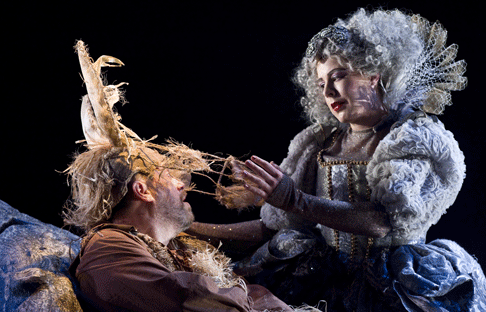 Andrew Slater as Bottom and Gillian Ramm as Tytania
Andrew Slater as Bottom and Gillian Ramm as Tytania
In this opera, so much depends on the orchestral fabric, and it was evident from the opening glissandi sweeps, that the instrumentalists, under the skilful baton of Michael Rosewell would expertly lull us into the world of dreams, shimmering and enticing us with colours of enchantment.
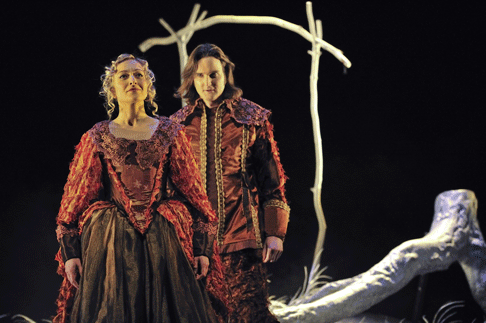 Lise Christensen as Hippolyta and Nicholas Lester as Theseus
Lise Christensen as Hippolyta and Nicholas Lester as Theseus
At the final curtain, true love and clear sight were thankfully restored. Slipping his arms free from the ropes that bound him, Puck assured us that all was now mended: “Give me your hands if we be friends, And Robin shall restore amends.” The captivated audience was glad to oblige.
Claire Seymour
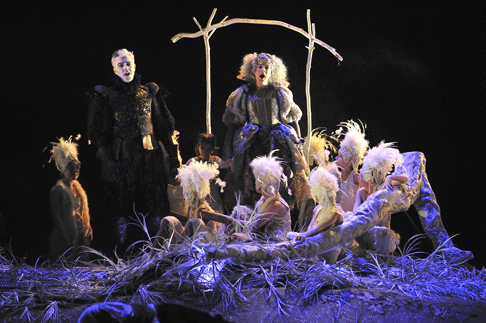 Jonathan Peter Kenny as Oberon and Gillian Ramm as Tytania
image=http://www.operatoday.com/Jonathan-Peter-Kenny-and-Da.gif
image_description=Jonathan Peter Kenny as Oberon and David Gooderson as Puck [Photo by Richard Hubert Smith courtesy of the English Touring Opera]
product=yes
product_title=Benjamin Britten: A Midsummer Night’s Dream
product_by=Jonathan Peter Kenny: Oberon; Gillian Ramm: Tytania; Niamh Kelly: Hermia; Michael Bracegirdle: Lysander; Robert Davies: Demitrius; Laura Mitchell: Helena; David Gooderson: Puck; Nicholas Lester: Theseus; Lise Christensen: Hippolyta; Andrew Slater: Bottom; Martin Robson: Quince; Henry Grant Kerswell: Snug; Mark Wilde: Flute; Nicholas Merryweather: Starveling; Benedict Quirke: Snout; Abigail Kelly: Cobweb; Catrine Kirkman: Moth. Director: James Conway, Conductor: Michael Rosewell. English Touring Opera, Sadler’s Wells. Wednesday 10th March 2010.
product_id=Above: Jonathan Peter Kenny as Oberon and David Gooderson as Puck
Jonathan Peter Kenny as Oberon and Gillian Ramm as Tytania
image=http://www.operatoday.com/Jonathan-Peter-Kenny-and-Da.gif
image_description=Jonathan Peter Kenny as Oberon and David Gooderson as Puck [Photo by Richard Hubert Smith courtesy of the English Touring Opera]
product=yes
product_title=Benjamin Britten: A Midsummer Night’s Dream
product_by=Jonathan Peter Kenny: Oberon; Gillian Ramm: Tytania; Niamh Kelly: Hermia; Michael Bracegirdle: Lysander; Robert Davies: Demitrius; Laura Mitchell: Helena; David Gooderson: Puck; Nicholas Lester: Theseus; Lise Christensen: Hippolyta; Andrew Slater: Bottom; Martin Robson: Quince; Henry Grant Kerswell: Snug; Mark Wilde: Flute; Nicholas Merryweather: Starveling; Benedict Quirke: Snout; Abigail Kelly: Cobweb; Catrine Kirkman: Moth. Director: James Conway, Conductor: Michael Rosewell. English Touring Opera, Sadler’s Wells. Wednesday 10th March 2010.
product_id=Above: Jonathan Peter Kenny as Oberon and David Gooderson as PuckAll photos by Richard Hubert Smith courtesy of the English Touring Opera
March 12, 2010
The Nose, New York
Should they talk or should they shush? Was it time to recharge the cell phone? Would that just sound like more of Shostakovich’s raucous, blurting score?
True, no one was singing at that moment but people hardly do sing in this opera, and the leading character — Kovalyov, a faceless bureaucrat who has just awakened to discover that he is noseless as well — performs much of his role in falsetto or in oaths and exclamations and excited jabber. Paulo Szot, who’s been singing Ezio Pinza’s role in South Pacific next door to great acclaim (with a microphone) might not be impressive as Don Giovanni in so huge a house as the Met, but he’s splendid in what is largely an acting part and in a staging that stints nothing on the acrobatic shenanigans it demands of all the performers. The actual title role — Kovalyov’s nose, portrayed by Gordon Gietz — runs about committing antics, getting into fights, picking up strange women, but hardly sings at all except when impersonating an officer.
When the opera premiered in 1930, Shostakovich had the happy advantage of being certain everyone in his audience — and every literate Russian — would know Gogol’s classic short story by heart, and therefore be able to follow the surreal twists and turns of a plot that echoed Gogol’s in detail. (Those planning to attend might want to read the story, too — it’s easy to find on the Internet.) Much of the opening night audience appeared to be Russian, but those who were not were often uncertain whether director/designer William Kentridge was making fun of them or just being silly. Madly inventive as his creations are, Kentridge was following Gogol (and Shostakovich) pretty closely in the storyline, though his sets seemed more inspired by the “Constructivist” epoch of early Soviet art during which Shostakovich wrote the opera.
You may or may not care for Shostakovich’s anti-lyrical — indeed, anti-operatic — score, which lacks the yearning, emotional center that endears his Lady Macbeth of the Mtsensk District, composed four years later, to audiences around the world. In any case, here we have an appropriate production for this strange, unoperatic opera. This isn’t the only way to present it, but it’s a way that takes the work seriously and deals with it in terms of contemporary stagecraft. The contrast to, say, the awkward, undramatic production of Verdi’s Attila that premiered at the Met a week earlier was striking: Though often handsome, nothing about that staging suited the opera being performed or helped make sense of it to a public who did not know it. The Met, it seems, will only suit the production to the work if that work is modern and alien to grand opera tradition.
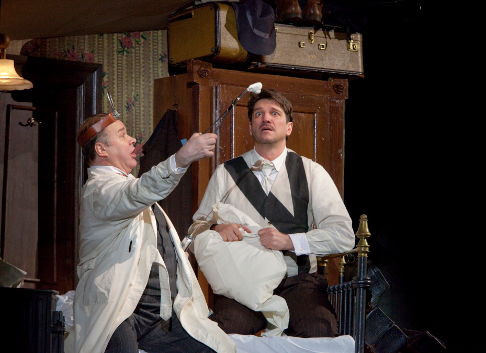 Paulo Szot as Kovalyov and Gennady Bezzubenkov as the Doctor
Paulo Szot as Kovalyov and Gennady Bezzubenkov as the Doctor
The set of The Nose is a wall of newsprint and graffiti, crisscrossed by bridges and inset with rooms, houses, offices, railway stations. The newsprint with its excitable but meaningless headlines seems to emphasize that the events of the opera are at once the very latest news and as insignificant as the filler of so much popular journalism. A man’s nose has run off — or been sliced off by a drunken barber (Vladimir Ognovenko, growling superbly) — and the hapless legal owner has pursued the runaway appendage to church and been snubbed in his polite request that it return to its place. The nose has not even admitted to working in the same bureaucratic department! And now our hero hardly dares approach the haughty lady whose daughter he was hoping to marry because — well, it’s plain as the nose on your face — he really can’t right now, can he? The authorities are unsympathetic and the newspapers will not print this story, even as a paid advertisement — he might be faking it, after all — and when the police do apprehend the runaway schnoz (attempting to leave town with a passport to Riga), poor Kovalyov has to bribe them in order to get it back. And then, at first, it won’t stay on!
Gogol’s depiction of the dullness and egocentricity of everyone in this world when faced with impossible events is precise and funny — and a forerunner of such writers as Kafka, Borges, Calvino and Barthelme. Shostakovich has set the tale with fiendish glee, in percussive explosions and astringent parody of popular song styles. The instruments often seem to sneeze or whine or fart as much as they play music. Pretty “vocalism” is a sure sign of hypocrisy — as in the case of the snobbish mother and daughter, sweetly sung by Barbara Dever and Erin Morley, or the police inspector serenely warbled by Andrei Popov — or of brainlessness, as in the charming serenade sung to balalaika by Sergei Skorokhodov as Kovalyov’s uncomprehending valet. Claudia Waite is both the barber’s shrewish wife and a bagel-seller raped by the police (a scene very like the rape of Aksinia in Lady Macbeth), Gennady Bezzubenkov is Kovalyov’s unsympathetic doctor, Adam Klein is Kovalyov’s sympathetic friend. There are twenty minor parts in the passing parade Kovalyov encounters — all too busy with their own problems to notice his — and all of them seemed to be sharing the high old time.
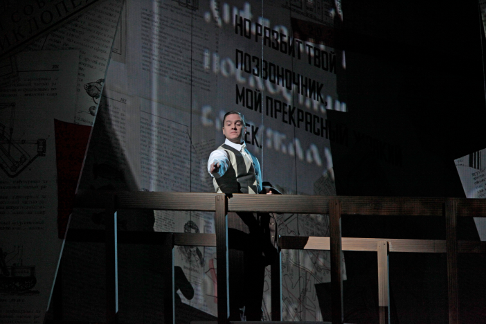 Gordon Gietz as the Nose
Gordon Gietz as the Nose
Yet, well before the end of the evening one tired of the shenanigans of both plot and score. Gogol’s story is short. So is the opera (less than two hours when played, as here, with no intermission), but I can’t say it flew by — it’s draining. One joke, since there is never an explanation for it, hardly sustains an entire evening.
All the singers and actors and dancers merited their applause, but the musical star was Valery Gergiev, who kept the joint jumping from start to finish with an energy that never seemed to wear out. It wore me out, but Gergiev could clearly have played a few Shostakovich symphonies as encores.
John Yohalem
image=http://www.operatoday.com/Szot_Nose_Met.png image_description=Paulo Szot as Kovalyov [Photo by Ken Howard courtesy of The Metropolitan Opera] product=yes product_title=Dmitri Shostakovich: The Nose product_by=Kovalyov: Paulo Szot; Police Inspector: Andrei Popov; The Nose: Gordon Gietz; Ivan Yakovlevich: Vladimir Ognovenko; Ivan: Sergei Skorokhodov; Matron: Theodora Hanslowe; Praskovia and Pretzel Vendor: Claudia Waite; Doctor: Gennady Bezzubenkov; Yaryzhkin: Adam Klein; Mme. Podtochina: Barbara Dever; Her daughter: Erin Morley; Dandys: Philip Cokorinos and Michael Myers. Production by William Kentridge. Chorus and orchestra of the Metropolitan Opera conducted by Valery Gergiev. Performance of March 5. product_id=Above: Paulo Szot as KovalyovAll photos by Ken Howard courtesy of The Metropolitan Opera
March 11, 2010
Verdi’s Attila, New York
Seated precariously atop the heap of ruin, resembling a large, destructive boy who has been playing where he shouldn’t, is Ildar Abdrazakov with what looks like a feathered teapot on his head. The chorus, in uniform gray, sit on the floor at his feet and sing a hymn to Wodano (you know – Wotan – the god of war) and to Attila the Hun – for it is he – who has just destroyed the great Roman city of Aquileia. When I visited Aquileia in 2006 – admittedly 1554 years after Attila’d been and gone – there wasn’t a rod of reinforced concrete in sight but there wasn’t much ruined Roman cityscape either; just some glorious mosaics, a fine museum and a peaceful tree-lined path beside the canal that was once a harbor for the imperial fleet. Most of the city’s monumental stonework has been “borrowed” over the centuries by nearby towns like Venice. (Venice was founded by refugees from Attila – an event that opens the second scene of Verdi’s opera.)
I’m not sure if singing from atop a heap of an elevated set undercuts vocal production, but Abdrazakov’s Attila, though competent and musical – and fearless on that rickety ledge – lacked the mighty depths signifying monumental and barbaric emotion that Jerome Hines and Samuel Ramey brought to the part. Abdrazakov was sturdy but never a force to be reckoned with, much less the Scourge of God.
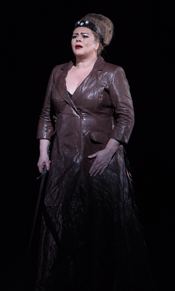 Violeta Urmana as Odabella
Violeta Urmana as Odabella
The contrast between a competent voice and a real one was clear the moment
Giovanni Meoni entered as Ezio, the Roman general, his baritone rolling out to
fill the room on the line: “Avrai tu l’universo, resti
l’Italia a me!” (Take the universe, but leave Italy to me), which
is the cry that made Attila a hit on its original appearance in
Austrian-occupied Italy. Meoni has a genuine Verdi baritone timbre and line,
makes a sturdy if stiff figure on stage in Miuccia Prada’s meter-long
leather fringe epaulets, and if he hadn’t run out of breath towards the
end of his Act II cabaletta, this would have been a headline occasion for him.
The world seems to have run short of Bastianinis and Merrills and Milneses, and
Verdi is hard to put over without them.
The sound of a real Verdi voice came, too, from the Attila of the previous
generation, Samuel Ramey, who walked on – the part is no more than that
– as “Leone, an ancient Roman,” in a crimson miter (for
censorship reasons, the librettist demoted this figure, who is actually Pope
Leo the Great) to forbid superstitious Attila from attacking Rome itself.
Ramey’s ugly wobble was in evidence, but also his
from-the-depths-of-the-earth authority, an echo of the true Verdi sound. Is it
a coincidence that he was singing on stage level, and not two stories up in the
air?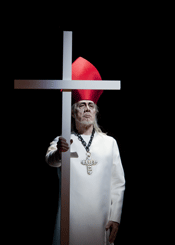
Samuel Ramey as Leone
Violeta Urmana, though she sang all the cascading notes of Odabella’s famously hectic arias, seemed to lack a center, a depth of heart. Urmana has a beautiful instrument and an assured technique – is there anyone else nowadays who can sing Odabella without peeling paint? – and she got all the intricacies beautifully, but she has never shown much dramatic instinct for Italian music and this stern placidity was in evidence here. There was none of the suppressed passion one felt in her Kundry at the Met some years ago, or her Isolde broadcast in December from Vienna.
Odabella’s tenderer music never does seem credible, perhaps because sopranos are hired to sing the role based on their ability to deal with the fire-breathing coloratura of her sortita, “Santo di patria.” Connoisseurs sometimes refer to Odabella’s “Sutherland aria” (“Santo di patria”) and her “Caballé aria” (“Oh nel fuggente nuvolo”), for the matchless recorded versions, but the recording studio is one thing, the stage another – and neither of those sensible ladies ever sang the role on stage. Voice lovers nonetheless come to Attila irrationally expecting Sutherland’s blazing fioritura in “Santo di patria,” Caballé’s luxuriant velvet in “Oh nel fuggente nuvolo,” and they’re never going to get both, seldom either one. Verdi composed them for Sofia Loewe, also the first Elvira in Ernani – and for the same house, Venice’s La Fenice, which is one-quarter the size of the Met.
Urmana sang all this music with impressive ease, ducking some high notes for
the honorable reason that she doesn’t have them, but never sounding less
than in command. As a technical exercise, her presence was very welcome and I
doubt anyone now singing could do it better – but there was little
feeling behind it. Too, she looked absurd in a Queen of Outer Space coiffure
(“They sacked my city, but I didn’t have a hair out of
place!”), but that’s not her fault.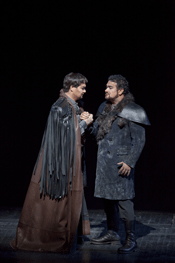
Giovanni Meoni as Ezio and Ramon Vargas as Foresto
That leaves Ramón Vargas in the role of Foresto, who is not a character at all but a jumble of tenor “tropes” – soprano’s suspicious lover, refugees’ heroic leader, incompetent conspirator. There wasn’t much of Vargas’ youthful honey in his first scenes; his tone was dry, his pitch all over the place. He didn’t warm up until his aria in the last act, a lovely account full of melting phrases.
The musical stars of the evening were none of the named singers but the orchestra and chorus, and Riccardo Muti, making his long-deferred house debut. Attila, like nearly all of Verdi’s early operas, is a major vehicle for chorus (not until Rigoletto and Traviata did he seem to find individuals more interesting than nationalities), and here we have rapacious Huns, pious monks, desperate refugees, unbowed Romans – although since they are dressed pretty much the same at the Met, or are visible only from the shoulder up, you might not know the chorus was playing any characters at all on this occasion. Still, they sang with the vigor and subtlety that has marked them ever since Donald Palumbo took over their headship.
As for Muti, he brought the score a sense of swiftness, lightness, speed, melodic arching, Rossini-esque brilliance that made me want to close my eyes and just forget about what was going on on stage. The many touches that reveal Verdi’s talent as an instrumental colorist beginning to achieve mastery were all brought forth.
If an opera has been around so long, and the composer has been represented in nearly every one of the 126 Met seasons (a few early all-German ones aside), and the Met has never chosen to stage it, there are probably very good reasons not to bother. All of them were apparent: The libretto is ungainly (director Pierre Audi barely tried to stage it, contenting himself with posed attitudes), the solo parts are difficult to cast, the dramatic effect of the work mediocre at best. Attila is worthy of its obscurity – as are most early Verdi operas, the thrilling Macbeth and the brooding Luisa Miller being the great exceptions. The only good reasons to put the others on are, first, to experience the master’s fascinating apprenticeship and, second, if you have spectacular singers who can do wonders with great melodies. Attila requires first-rate Verdi tenor, baritone and bass and a superhuman soprano, and the Met does not have such singers in its stable.
Herzog & de Meuron, the architects who designed this production, appear to have looked at the five-story-high Met stage and thought, “How can we fill that?” Not: “How can we stage an exciting drama there?” but “How can we fill it?” – as if they were designing a wall hanging. They have filled it, to be sure, with an eye-popping vertical green rain forest (turning a sere brown for the final act, and blood red when at last Attila is slain) in which little cavernous hollows appear so that Attila can have a nightmare and Ezio a change of heart. It’s very attractive but highly unsuitable for stage action. In order to present the scenes Verdi asks for (I’m sure Mr. Audi was very annoyed with him about it, but couldn’t get his phone calls returned from the tomb), the set has to rise in the air a story or so, and singers appear underneath it to “emote” against bare backdrop. This undercuts Verdi’s masterful scene-painting, dawn over the lagoons of Venice, sunset over Attila’s tent, saints appearing in the heavens at the pope’s command and so forth – all played magnificently by the Met orchestra under Muti – because nothing on stage corresponds to the music we are hearing. They might as well have given the whole thing in concert and saved a lot of money.
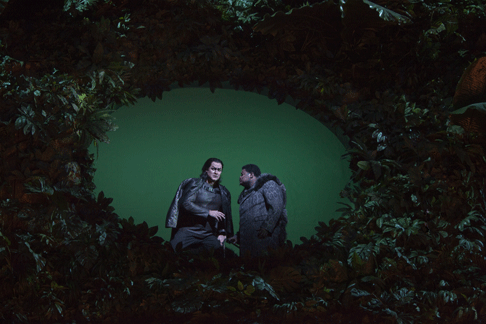 Ildar Abdrazakov as Attila and Russell Thomas as Uldino
Ildar Abdrazakov as Attila and Russell Thomas as Uldino
There is a certain logic in pushing the singers to the stage apron – the singers like that – they feel somewhat lost fifty feet back. In front they think they can make more effect, more noise, and keep an eye on the conductor as well. But it’s a waste of space and of playing room, and it makes the action impossible to play.
Miuccia Prada’s costumes probably call for a special word: what the well-dressed refugee is wearing, a runway with cavalry in hot pursuit. The principals wear leather and fake fur and gold lame in improbably contemporary styles (when did capes come back in fashion?), but the chorus of monks are dressed in undistinguished shmattas so if we do not follow the titles we’ll have no idea they’re supposed to be monks, and the refugees in their fur vests who seek them out seem to be ladies out for an evening stroll. There is no theatrical thrill to this unless all you want from an opera is a fashion show.
John Yohalem
image=http://www.operatoday.com/Attila_Met_01.gif image_description=Ildar Abdrazakov as Attila [Photo by Ken Howard/Metropolitan Opera] product=yes product_title=Giuseppe Verdi: Attila product_by=Attila: Ildar Abdrazakov; Odabella: Violeta Urmana; Ezio: Giovanni Meoni; Foresto: Ramón Vargas; Leone: Samuel Ramey. Metropolitan Opera Chorus and Orchestra, conducted by Riccardo Muti. Performance of March 3. product_id=Above: Ildar Abdrazakov as AttilaAll photos by Ken Howard/Metropolitan Opera
March 9, 2010
Das Rheingold, Paris Opera (Bastille)
By Francis Carlin [Financial Times, 9 March 2010]
Das Rheingold has been a long wait. The Paris Opera has not seen a full Ring cycle since 1957. Now, Nicolas Joel has embarked on a new cycle over two seasons with a first, very mixed, result.
Regarding ‘The Nose’: What Did the Art Critic Think of the Opera?
NY Times ArtsBeat [9 March 2010]
Today on ArtsBeat three New York Times critics — Anthony Tommasini, chief classical music critic; Roberta Smith, art critic; and Dwight Garner, book critic — are discussing the music, the art and the literary threads of “The Nose.” Daniel J. Wakin, classical music reporter for The Times, is moderating.You can read the previous posts here.
The Elixir of Love at ENO
On the evidence of this production, first aired by New York City Opera, he’s not too concerned about the ‘dark side’ of medical charlatanry; for here Miller invites us to enjoy a light-hearted evening of music and food, mischief and fun, at ‘Adina’s Diner’ — a popular stopping place way out in the America Midwest, beloved by homespun yokels and travelling tricksters alike. We lap up the aural and visual candyfloss and, after a charming evening, skip home, refreshed by the reassuring spirit of innocence and optimism which prevails.
Isabella Bywater’s set is a superbly naturalistic recreation of the era. The rolling yellow plains and flawless blue sky evoke the landscapes of Edmund Hopper, and Bywater’s bubblegum pink and lime green diner recreates Hopper’s ‘Nighthawk’, albeit with a more golden, ambient glow. The revolving set is ingenious, but the dusty exterior is more successful than the interior, the latter seeming cramped and overcrowded. Despite Miller’s detailed direction of the chorus, there was simply too little room, forcing many to remain seated — including, in the opening scene, Nemorino, who, set back and enclosed by the set, was swamped by the chorus and orchestra.
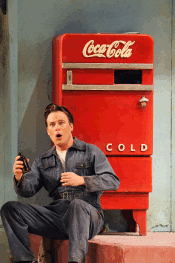 John Tessier as Nemorino
John Tessier as Nemorino
Into this rural eatery waltzed the confident proprietor, Adina. Sarah Tynan, sporting a peroxide bob, was perky and coquettish rather than a vamp. Her voice was as agile as her wiggling hips, and bright and warm; and she offered a lively, engaging performance, perfectly conveying the mannerisms of a 1950s blond bombshell. However, there was no sense of ’depth’ beneath the flighty surface and Tynan offered little to mitigate her cruel treatment of Nemorino.
Indeed, there was a disappointing lack of chemistry between the Adina and Nemorino, the latter presented here as a gauche garage hand. Canadian tenor John Tessier was a naïve and trusting yokel, but while his clear, true rendering was well-received, his voice is fairly light-weight and lacks an Italianate warmth and colour that hints at passionate depths beneath. Tessier’s ‘miraculous’ transformation from garage dunce to matinee idol was not entirely credible and too often he sang to the audience, rather than to the other characters on stage. However, the production did create a dramatic context for ‘Una furtive lagrima’, which for once did not seem like a convenient ‘add-on’.
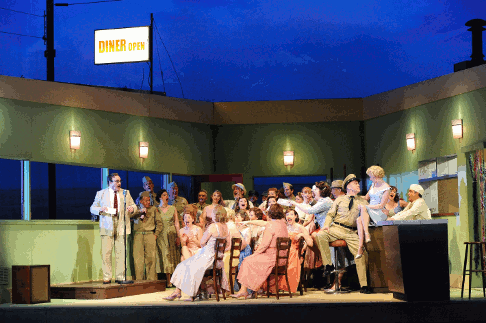 Andrew Shore as Dulcamara and company
Andrew Shore as Dulcamara and company
The real star of the show was the experienced Andrew Shore, as the oleaginous quack doctor, Dulcamara. He slid in, seated in an ostentatious open-top Cadillac cabriolet (its shine a little sullied after a journey across the dusty plains), looking sharp but shifty in white suit, shades and brogues, panama hat perched rakishly on ill-fitting wig. Shore’s swindler was confident, assured, and crafty. [The automatic dispenser for Coca-Cola — that ‘pure refreshment’ that ‘revives and sustains’ — was cleverly positioned ...] Indeed, for Shore’s sparkling salesman’s pitch the surtitles disappeared — one assumes this was an intentional acknowledgement of Shore’s prowess rather than a technical hitch — but every word of Kelley Rourke’s clever libretto was crystal clear. Shore presented Rourke’s wittily rhymed medicinal claims — “You reek of halitosis/ Then take a couple of doses” — with consummate mastery, although (if one was being harsh) one might accuse him of trying a little too hard at the risk of straining the voice. The subsequent wedding celebrations were pure MGM gold. Impersonating Elvis, Shore’s line ‘I’ve got a little ditty’, drew the largest laugh of the night; and when Adina joined him ‘on-stage’ in the diner, there was considerably more knowing interaction between them than was apparent in her exchanges with the younger heart-throb Nemorino. Adina’s Marilyn drawl might have been a bit too self-knowing, but Tynan, and Miller, pulled it off, just staying short of overkill.
As a gum-chewing GI, David Kempster’s Belcore swaggered and boasted his way, temporarily to Adina’s heart. Julia Sporsén’s Gianetta was sparkling and full of life.
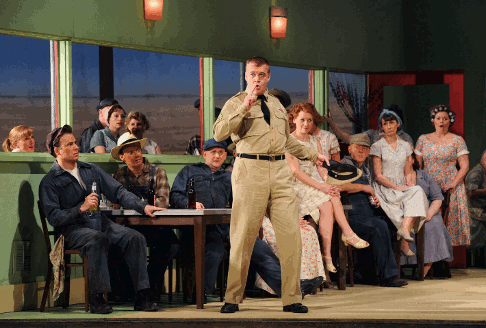 David Kempster as Belcore and company
David Kempster as Belcore and company
Miller and Bywater had clearly, and effectively, thought hard about the realism of this production. But there was one incongruity: the inconsistency between the text and its delivery, with regard to accent. It was decided (so the programme told us) to use Americanisms (‘a knuckle sandwich’, ‘hello cupcake’), to pay homage to Porter and Sondheim (‘an elixir with a kick, sir’), and to attempt American accents throughout. The problem was that no one seemed to have told the chorus, and the principals frequently only remembered at the ends of phrases, which made Tessier’s native Canadian burr seem rather out of place.
Another problem was the over-enthusiasm of the conductor. Spaniard Pablo Heras-Casado, who enjoyed himself just a bit too much, encouraging the orchestra too excitedly and destroying the balance between stage and pit. Moreover, the tempi were often too slow: fine for the patter songs but fatal in the acts’ final choruses which should whip up a froth.
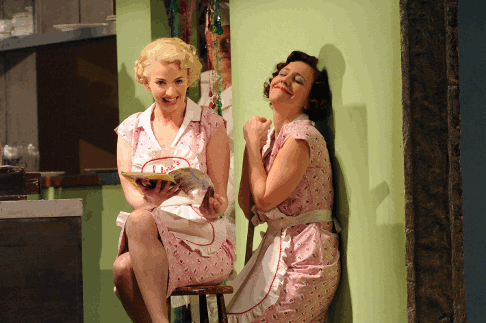 Sarah Tynan as Adina and Julia Sporsén as Gianetta
Sarah Tynan as Adina and Julia Sporsén as Gianetta
So, this was a charming, folksy show. Miller’s humour was of the gentle kind — Nemorino turning momentarily into a bass-baritone when swigging the elixir, the outside loo flushing incongruously as Gianetti announced Nemorino’s financial good fortune. Dulcamara’s slugging of his own elixir when he observed the ladies chasing after Nemorino drew an appreciative chuckle from the audience. However, despite its ‘silliness’, there are some shades of darkness in this work — innocence is threatened by deception, guileless by guilt, and love seems indissolubly linked to money; but such shadows were kept well under wraps in this affectionate, enjoyable show.
Claire Seymour
image=http://www.operatoday.com/Elixir_ENO_01.png image_description=Sarah Tynan as Adina [Photo by Tristram Kenton / ENO] product=yes product_title=Gaetano Donizetti: The Elixir of Love product_by=Nemorino: John Tessier; Adina: Sarah Tynan; Dulcamara: Andrew Short; Belcore: David Kempster; Gianetta: Julia Sporsén. Director: Jonathan Miller. Designer: Isabella Bywater. Conductor: Pablo Heras-Casado. English National Opera, London Coliseum. Friday 12th February 2010. product_id=Above: Sarah Tynan as AdinaAll photos by Tristram Kenton / ENO
The Gambler, London
As our hapless politicians stake the security of future generations, and self-absorbed bankers obsessively take their chances with the populace’s finances, it sometimes seems that the world stability hangs not on the spin-doctors’ platitudes but on the spin of the Dow Jones’ roulette wheel.
Dostoyevsky’s 1866 novel The Gambler provided Prokofiev with the inspiration for this tale of economic and emotional ruin. The drama takes place in an hotel in a fictional German spa resort, Roulettenburg — reminiscent of the Baden-Baden where Dostoevsky recklessly propelled himself into bankruptcy. As the twinkling signs adorning the front curtain unambiguously declare, the Casino is the place to be, and gambling the only occupation to distract the assorted European residents from their ennui and snobbery.
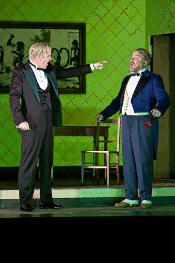 Kurt Streit as the Marquis and John Tomlinson as the General
Kurt Streit as the Marquis and John Tomlinson as the General
Alexey, tutor to the widowed General’s children, is passionately in love with the latter’s step-daughter, Paulina. Unaware that she is indebted to the Marquis, Alexey has tried to ease her despair, and win her heart, by gambling with the proceeds from her sold jewellery, but he has lost all the money. Meanwhile, the impoverished General waits impatiently for his elderly aunt, Babulenka, to die, so that he can inherit her fortune, marry his courtesan mistress, Blanche, and relieve himself of his own obligations to the Marquis. Unfortunately, Babulenka proves rather more robust than her relations had hoped or anticipated; she arrives at the spa town to recuperate, and is herself enticed into the gamblers’ den. As she frits away the family’s inheritance, Blanche turns her attentions to more lucrative suitors, while the General collapses in despair.
Alexey finds Paulina in his hotel room; she is being pursued by the Marquis for her outstanding debts, and begs him to find the money to save her from selling herself on the marriage-market. In the casino, Alexey has an amazing streak of lucky and breaks the bank. Yet, when her offers Paulina the money she angrily declines; her love cannot be bought. By this stage, Alexey is so consumed with the ecstasy of his winning streak that he forgoes all thoughts of human love for the thrill of the roulette wheel.
Determining to imitate the naturalist idiom with which Mussorgsky experimented in Boris Godunov, Prokofiev produced his own libretto, here rendered in David Poutney’s translation which retains the unrhymed dialogue of the original. Essentially the text is a stream of continuous recitative — although on this occasion the diction was so poor that one couldn’t actually hear a word! — and this relentless melodic uniformity is one of the problems which any production must overcome. For, while there is much power in Prokofiev’s score it is not immediately touching or involving and the listener can feel rather distanced from the onstage action, at least in the opening two acts.
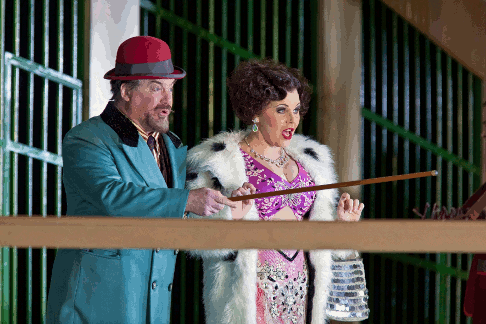 John Tomlinson as the General and Jurgita Adamonyte as Blanche
John Tomlinson as the General and Jurgita Adamonyte as Blanche
Richard Jones does his best to draw us into the characters’ dilemmas and traumas. He imaginatively updates the action to the 1930s, and the décor is stylishly and imaginatively designed by Antony McDonald. A sharp perspective ensnares the audience’s eye, mimicking the irresistible force of the addict’s compulsion and the undeniable gravitational pull of the roulette ball’s progress. This is a perfect visual match for Prokofiev’s unyielding score, its driving ostinati conveying the inescapable urges and cravings of the gamblers who stake all on the roulette ball’s destiny. In this regard, the composer saves the most chillingly evocative instrumentation for Act 3, in the Casino, where the clientele and croupiers of Jones’ casino scuttle about like demented pinballs, their lurid costumes flashing and spinning, before taking their places in rigid rows like the resting columns of a one-armed bandit.
Jones’ garish, anti-naturalistic staging highlights the extremism of Dostoevsky’s vision. In Act 1 the leisured guests stroll through the zoological gardens; barred windows denote the cages, but who is looking in and who out? It’s a grotesque menagerie, for morally misshapen disreputables — symbolised by a dancing seal (heroically performed by the costumed dancer), whose ghastly writhing betokens the bestial urges to which all succumb. On a projection screen, a tiger paces back and forth impatiently, trapped in its small cage, hinting at the cruelty and viciousness which lurks beneath the aristocratic veneer of the hotel lounge.
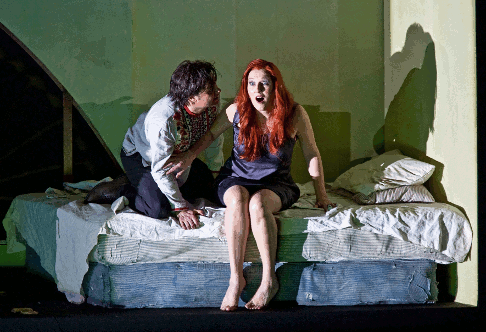 Roberto Saccà as Alexey and Angela Denoke as Paulina
Roberto Saccà as Alexey and Angela Denoke as Paulina
The dramatic temperature is at boiling even before the opera begins, and there is little light and shade in the opening acts. There is a large ensemble cast, to which Jones added even more characters — seen, for example, running feverishly across the stage during the impassioned overture, and returning during the final scene to intrude on Alexey’s closing number (and somewhat diminishing the poignancy of his rejection by Paulina). The revolving doors of the hotel fling a continual stream of guests into the lounge, and the atmosphere is tense and frenetic. However, Prokofiev’s score does possess moments of lyricism, most noticeably for Alexey, Paulina and Babulenka who, with a nod in the direction of the literary original, are the most sympathetic characters. Dressed like Russian peasants (costumes by Nicky Gillibrand), they intimate a nostalgia for a Russia unsullied by European vices — indeed, having lost all her wealth, Babulenka returns to her Russian village — and exhibit real ‘human’ emotions, conjured by brief melodic fragments which float above the grinding dissonances of the obsessively busy score.
Tenor Roberto Saccà, as Alexey, was in powerful voice, and certainly had the necessary stamina for this demanding part. He injected drama and emotion into the role at every opportunity, finding a variety of colourings to reflect his transformation from guileless lover to heartless addict. In the role of Paulina, Angela Denoke displayed a strong, well-centred tone, appropriately suggesting wilfulness, confidence and, at the close, honest self-recognition.
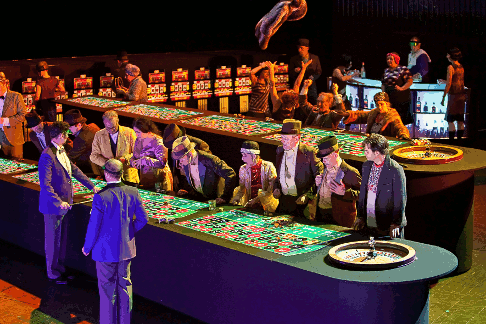 Scene from The Gambler
Scene from The Gambler
Making a ‘Lady Bracknell-esque’ entrance, Susan Bickley was a vigorous, life-loving Babulenka. She was both strident and tender, as the drama demanded; and the contrast between her initial headstrong independence and subsequent disappointment was touching and full of pathos. Strong, sustained characterisation was also a praiseworthy feature of baritone Mark Stone’s mysterious Mr Astley and the Marquis of tenor Kurt Streit. Most impressive of all, John Tomlinson’s General was a superlative presentation of a defeat and delusion; his act 3 mad scene was a tour de force.
In this ‘recitative opera’ it is in fact the score which tells the story. The ROH orchestra were once more on tremendous form, as Pappano relished the pounding rhythms, driving tempi and the thick brassy timbre, expertly exercising control in the pit as the characters on stage spun into moral chaos.
By the final act, the mercenary financiers — the so-called ‘gentlemen’ — have gambled with Fate and lost both their money and their souls. Alexey has thrown away his innocence and exchanged Paulina’s love for a banker’s safe. This is not just a social satire but a real human tragedy. All are in the grip of vices which consume them. You can’t beat the odds or evade your destiny, and we ignore this disturbing lesson at our own peril.
Claire Seymour
image=http://www.operatoday.com/Gambler_ROH_02.png image_description=Roberto Saccà as Alexey, Susan Bickley as Babulenka and Angela Denoke as Paulina [Photo by Clive Barda courtesy of Royal Opera House] product=yes product_title=Sergey Prokofiev: The Gambler product_by=Roberto Saccà: Alexey; Angela Denoke ; Paulina; John Tomlinson: The General; Jurgita Adamonyte: Blanche; Kurt Streit: The Marquis; Susan Bickley: Babulenka; Mark Stone: Mr Astley. Director: Richard Jones. Conductor: Antonio Pappano. Royal Opera House, Covent Garden, London. Thursday 11th February, 2010. product_id=Above: Roberto Saccà as Alexey, Susan Bickley as Babulenka and Angela Denoke as PaulinaAll photos by Clive Barda courtesy of Royal Opera House
March 8, 2010
A dark but moving "La Bohème" at the Minnesota Opera
By Becca Mitchell [TC Daily Planet, 8 March 2010]
There’s no denying La Bohème is one of the world’s most famous operas. Giacomo Puccini’s 1896 opera is staged frequently across the globe and was the inspiration for the Tony-winning musical Rent, which ran for more than 12 years on Broadway and was just staged in an acclaimed Minneapolis production. One could argue it’s the love story at the center of the piece that’s contributed the most to the opera’s lasting resonance. And on that level, if not on all levels, the current Minnesota Opera production delivers.
Philip Langridge, British Operatic Tenor, Dies at 70
By Allan Kozinn [NY Times, 8 March 2010]
Philip Langridge, an English tenor who was renowned for roles by Benjamin Britten and was an eloquent interpreter of Handel, Mozart, Schubert, Janacek and Stravinsky, died in England on Friday. He was 70 and lived near Guildford, southwest of London.
Love Triumphs in L’Elisir d’amore at Lyric Opera of Chicago
The bright and festive staging featured, in its opening cast, Nicole Cabell and Giuseppe Filianoti as the pair Adina and Nemorino, whom love finally unites. The rival to Nemorino in his courtship of Adina, Sergeant Belcore, was sung by baritone Gabriele Viviani. Whereas both suitors of Adina are making their debut this season at Lyric Opera, the pivotal role of Doctor Dulcamara, who produces the elixir allegedly causing love, was portrayed by familiar baritone Alessandro Corbelli. The orchestra was conducted by Bruno Campanella.
In it performance of the overture the Lyric Opera Orchestra yielded a firm balance of strings and woodwinds, with the oboe and flutes especially standing out. Campanella led with tempos that allowed for motivic expression of individual segments while maintaining an overall conception of the orchestral flow. The first scene of the opera in this production is bathed in sunlight; the Lyric Opera chorus in its opening number gives the impression of a nineteenth-century village gathering. Nemorino threads his way through the crowd of peasants and townspeople in order to snag a glimpse of his beloved Adnia. She seems to be lost in her reading and, with book in hand, she ascends to an elevated balcony and seeks out space for concentration. In his first solo number, “Quanto è bella,” [“How beautiful!”] Nemorino details his infatuation with ardent lyricism. Mr Filianoti truly gave such an impression while lacing his verses with an admirable sense for legato. In his appeals to gain access to Adina’s attentions Filianoti relied, perhaps more than needed, on forte expression, a more even balance showing itself once interaction with the other performers began. During the following, parallel aria Adina reveals that the subject of her reading is the story of “Tristan and Isolde” whose boundless love was engendered by a potion. Here Ms. Cabell indicated Adina’s absorption in the tale of the magical love by, at first, an understated approach with spare use of vocal decoration. As Adina continues to muse and wishes that she knew more about the potion, a troop of soldiers enters under the direction of Sergeant Belcore. In his introductory aria he offers a token of admiration to Adina and sings of his own love being tantamount to that of a Classical or mythological model of amor. Mr. Viviani worked his way into this entrance so that his elaborate decoration was securely applied to suggest an image of self-importance by the close of his declaration. Adina does not commit herself as a result of this paean, yet Nemorino feels that he could lose any chance to win her love. By the point of the trio ending this scene all three principals had achieved a vocal and dramatic characterization of their roles and interacted well to express the hauteur of the Sergeant, the desperation of Nemorino, and the coyness of Adina. The duet which follows this exchange features the latter two characters in their first scene alone together. As Adina attempts to dissuade Nemorino from further displays of devotion, he seems willing to neglect even the fortunes of an ailing uncle. Filianoti sang graceful arching lines in his description of the unstoppable flow of the river, in order to describe the futility of trying to stay his emotions [“Chiedi al rio perchè gemente dalla balza” (“Ask of the river why it parts from its source and fountain”)]. Ms. Cabell’s voice seemed to bloom here as she matched the touching bel canto decoration of her suitor, even though her response to Nemorino essentially denied his entreaties.
In a shift suggesting the scene at the start of the opera numerous villagers collect around the cart of Dr. Dulcamara, who enters from his travels with great spectacle. Mr. Corbelli inhabits the role in all its facets convincingly. From this point until the close of the act Dulcamara’s personality and his influence have an effect on Nemorino’s hopes and behavior. At first Dulcamara brags to the villagers of selling a panacea for any possible ill. Mr. Corbelli handles the doctor’s rapid monologue with idiomatic ease, and he infuses the words with believable posture. Once the townspeople leave, Nemorino asks if a potion to induce love is also sold by the doctor. True to expectations of Dulcmara, a potion akin to Isolde’s is produced: the doctor sells Nemorino a bottle of wine and suggests that he allow a days’ time for the elixir to take effect. In the well-known duet including “Obbligato!” [“Much obliged!”] both Filianoti and Corbelli maintain and enhance their characterizations of a lovelorn youth and a self-serving charlatan. Their challenging vocal lines were delivered crisply and with sufficient independence so that each made a distinct impression while, at the same time, being caught up audibly in the sense of a progressive duet. Nemorino imbibes from the elixir as instructed and he becomes, of course, emboldened in his sense of confidence. When he next sees Adina, Nemorino seems disinterested and he declares that her emotional response will surely be kindled before long. Ironically Belcore enters and presses his suit again. In the trio which concludes Act I Adina agrees, at first, to give her consent to Belcore by the following day. When reminded of the sergeant’s imminent departure, she agrees to a marriage on this very day. Mindful of the doctor’s prediction, Nemorino is now aghast that sufficient time will not have elapsed for Adina’s love to be awakened by the potion. Accompanied by increasingly rapid tempos, all three principals in this production sailed toward the finale while communicating individual emotions as part of a larger canvas in the ensemble. The well-rehearsed chorus contributed to the picture of unexpected dilemmas at the close of the act.
At the start of Act II festivities for the wedding between Adina and Belcore have been set up. While Belcore waits for the marriage document to be signed, Adina regrets the absence of Nemorino. The crowd is entertained by a song performed in duet by Dulcamara and Adina. At this pont Ms. Cabell and Mr. Corbelli engaged in play-acting to suggest the amorous tone of the song, a skillful maneuver which enhanced the tension of love as gradually depicted here in its development. Once the notary arrives to seal the marriage, Adina finds further reason to delay her agreement. She leaves Dulcamara alone at the banquet until Nemorino appears to beg more of the elixir. Since he has no cash to buy the potion, Nemorino sells his time to the army: Belcore gives him twenty crowns in exchange for military service. In these two scenes Filianoti showed a skillful application of vocal colors, first in his exchange with Dulcamara followed by the pointed duet with the sergeant. Once the news that Nemorino’s wealthy relative has passed away is communicated by the village girl Giannetta, the youth returns under the influence of the elixir. In the role of Giannetta, Angela Mannino gave full-voiced lyrical expression to a memorable characterization. Now many of the women in the village vie for Nemorino’s attentions, as Adina must rely on her own charms to settle the emotional quandary. In their final solo numbers of the act both Filianoti and Cabell demonstrated their skills at this repertoire. “Una furtiva lagrima” [“A furtive tear”] was performed with great pathos, a superior command of legato, and an effective use of diminuendo toward the close. Ms. Cabell’s ultimate declaration of her love was sung with appropriate and well-executed decoration as well as carefully observed shifts in tempo during the course of the aria. The assembly of well-wishers provided a happy ending as Dulcamara, initiator of the elixir, departs upon having completed his task.
Salvatore Calomino
Click here for a photo gallery and other information regarding this production.
image=http://www.operatoday.com/Elisir_Chicago.gif image_description=Giuseppe Filianoti as Nemorino and Nicole Cabell as Adina [Photo by Dan Rest courtesy of Lyric Opera of Chicago] product=yes product_title=Gaetano Donizetti: L’Elisir d’amore product_by=Adina: Nicole Cabell; Nemorino; Giuseppe Filianoti; Nemorino: Frank Lopardo; Dulcamara: Alessandro Corbelli; Belcore: Gabriele Viviani; Giannetta: Angela Mannino. Bruno Campanella, conductor. Original Production: Giulio Chazalettes. Director: Vincent Liotta. Designer: Ulisse Santicchi. Lighting Designer: Jason Brown. Chorus Master: Donald Nally. Wigmaster and Makeup Designer: Richard Jarvie. product_id=Above: Giuseppe Filianoti as Nemorino and Nicole Cabell as Adina [Photo by Dan Rest courtesy of Lyric Opera of Chicago]Puccini: La Rondine
In blunter terms — his failures. He never got Edgar into any kind of shape to save it from obscurity, although the Puccini name still managed to get the opera recorded a time or two, and a recent “discovery” of some alternative material led to a production, available on DVD, with Jose Cura in the lead. With La Rondine, the “Traviata-lite” story of a pampered, kept woman (Magda) and her sad attempt at finding true love with a young man rich in good looks but poor in dollars, the gorgeous music Puccini composed has gotten the opera a fair amount of attention. As an alternative to another round of the master’s ubiquitous La Boheme, there’s a refreshing aspect to La Rondine. Nevertheless, a production that can truly make the opera’s narrative work has not appeared (except possibly to those besotted, understandably so, with the beauty of the score). An opera should build to its final act; La Rondine collapses as that point. The title character’s love interest, Ruggero, is so one-dimensional that he makes Traviata’s Alfredo seem like Hamlet, and the decision Magda makes when she realizes her past will always thwart their happiness (the “swallow” flies away) comes off as unmotivated or irrational.
Interestingly, for the 1998 Washington National Opera performance that Decca offers on DVD, director Marta Domingo opted for a later revision where Puccini thought a tragic ending would make the third act viable. Here, Magda not only realizes her past will obliterate any chance for happiness, not just this one with Ruggero, and so at opera’s end she walks into the sea (here a cloud of fog) to end it all. In Michael Scott’s lovely seaside cottage setting, the scene plays effectively in itself, but still feels like no resolution to the story and characters of the much lighter first two acts. The odd mix of the libretto is reflected in the names of the librettists: Dr. A. M. Willner, Heinz Reichert, and Giuseppe Adami. Three librettists walk into an EU bar, the joke might begin.
Domingo’s direction of the first two acts gets too busy at times — all the supers in the second act cafe scene make too much noise during lighter scored music — but she has an attractive cast. Inva Mula’s career now takes her to main stages (more in Europe, perhaps) and major roles; here she sings Lisette, a light role in a light opera, and Mula charms. As her poet boyfriend, Richard Troxell gets to camp it up a bit, and thankfully he knows not to let that get annoying. Ruggero is a good role for Marcus Haddock. He is not a tenor who brings much dramatic face to any performance anyway, so the role of a callow, smitten rube doesn’t tax him. The voice remains able but unmemorable.
Ainhoa Arteta’s Magda makes this a Rondine that flies above the competition. Her tone remains feminine in the more challenging moments — especially the tricky high notes of Doretta’s song, which need float — and in the conversational sections, her complete assumption of the character shines through. When Arteta takes center stage, Puccini’s inspiration matches his craftsmanship. Elsewhere, more than in any of his other operas, a sense of the great composer operating on auto-pilot can’t be evaded. Conductor Emmanuel Villaume treats both the lesser and greater parts of the score with great taste and care.
The booklet essay in the Naxos DVD of the 2007 Puccini festival staging blandly states that this is “yet another version” of the opera. Here, Ruggero rejects Magda at the end, leaving her devastated. Surely Puccini considered this option in an attempt to make Ruggero minimally interesting, and just as surely he rejected it because it goes against the concept of Magda as “swallow,” light and mobile. Director Lorenzo Amato’s solution to that problem is to bring a giant bird cage on at the end. Get it? But just in case the viewer needs more help, on a rear screen a sketch of a bird skull is projected (sets and costumes are by Nall).
Domingo’s staging for Washington maybe be too pretty for some, but anyone looking for ugliness in a Rondine production should be fully satisfied by Amato and Nall’s efforts. Unfortunately, the singing offers little beauty in compensation. Soprano Svetla Vassileva has too heavy and dark a voice for Magda. Fabio Sartori also has more voice than he needs as Ruggero; if it were a more attractive instrument, viewers might be able to overlook the fact that Sartori — a hefty, plain man — isn’t very convincing as a country lad who turns the head of a high class Parisian courtesan. Maya Dashuk as Lisette makes the best impression of the rest of the cast. In fact, the designer of the packaging apparently thought the blond and attractive Dashuk was the star, as her portrait appears on the front cover, not Vassileva’s. Alberto Veronesi leads the Puccini festival forces in an efficient performance, though perhaps recorded a bit loud and thus harsh hearing at times.
Perhaps the Metropolitan Opera’s HD moviecast with Angela Gheorghiu and Roberto Alagna will come to DVD — that would be strong competition for the Washington Opera set. The Naxos is recommended only for the morbidly inclined.
Chris Mullins
image=http://www.operatoday.com/Naxos2.110266.gif imagedescription=Giacomo Puccini: La Rondine
product=yes producttitle=Giacomo Puccini: La Rondine productby=Magda: Svetla Vassileva; Lisette: Maya Dashuk; Ruggero: Fabio Sartori; Prunier: Emanuele Giannino; Rambaldo: Marzio Giossi; Périchaud: Fernando Ciuffo; Gobin: Giorgio Berrugi; Crébillon: Andrea Patucelli; Yvette: Polina Volfson; Bianca: Alessandra Meozzi; Suzy: Annunziata Vestri; Fleury: Katia De Sarlo; Mariette: Chang Chiung Wen; Roro: Elisabetta Lombardo; Un maggiordomo: Alessando Manghesi. Puccini Festival Chorus and Orchestra. Alberto Veronesi, conductor. Recorded live from the 53rd Puccini Festival, Torre del Lago, Italy, on 8, 10 and 16 August 2007. productid=Naxos 2.110266 [DVD] price=$29.49 producturl=http://astore.amazon.com/operatoday-20/detail/B001U1L9NK
Brilliant Schubert programme: Matthias Goerne, Wigmore Hall
Starting a recital with An die untergehende Sonne was daring. Immediately we’re thrown into darkness and the murky depths of inner consciousness. “Immer tiefer, immer leiser, immer ernster”. The text may be peaceful, but the dizzying descent in the piano part hints at something more unsettling. Without a break, Goerne launched into Der Tod und das Mädchen. The tolling prelude makes it clear this sleep is death. The poet is Matthias Claudius, but the concept goes right back to the Middle Ages, It permeates Schubert’s aesthetic.
The theme recurs in Die Rose and Viola. Note the contrast between the two poems and Schubert’s settings. Die Rose is a poem by Freidrich von Schlegel. It’s beautifully, concisely written. The first stanza in particular scans so tightly, it’s like music: no wonder Schubert was drawn to it. It’s such a good poem, it’s a joy to read and savour word by word. Schlegel covers a wide range of images in a few brief lines. Goerne respects each word, colouring and shading with nuance, so the rose comes alive in sound, before it slowly fades away.
In contrast Viola, is to a poem by Schubert’s rakish friend Franz von Schober. “Schneeglöcklein” runs the refrain. Six verses down the violet awakes. Seven stanzas later she flees “von der tiefsten Angst verfleischt”. The violet’s come out too soon and is caught by the frost. Silver bells, bridegrooms, flowers anthropomorphized so corny that even Disney might cringe. Even Schubert struggles to make sense of the endless verses. Both Schubert and von Schober would have known Goethe’s poem Das Vielchen, and probably Mozart’s setting of it. Strophic ballads don’t have to be maudlin. Goerne makes the song believable by singing without excess ornament. After Die Rose, it’s hard to take Viola. It’s a measure of Goerne’s skill that he can pull it off.
Another very intelligent pairing : Auf dem Wasser zu Singen and Der Zwerg. Both songs describe death on the water, but in sharp contrast. In the former, Schubert’s melody dances delicately, so you can almost see the “schimmernden Wellen” as the boat gently glides on the lake. Don’t be lulled. The little boat is a metaphor for the passing of time. The poem, by Friedrich Graf zu Stollberg-Stolberg ( double barreled prince) is altogether more sophisticated than the shock horror gothic in Der Zwerg which ends in suicide-murder.
Matthäus von Collin’s poem isn’t bad, though. Rather than being a subtle mood piece it’s a saga in miniature. The dwarf and the queen have a long, complex history. She willingly accepts being murdered, even absolving the killer. It’s pretty kinky. Schubert doesn’t exaggerate the lurid colours, though his setting is dramatic. This song is always a show stopper, it’s so good. Again, Goerne doesn’t give in to pathos, his singing giving the dwarf dignity and respect. That last line, “An keiner Küste” is so chillingly sung that Goerne hints that the real horror is yet to come. The dwarf might not escape in death, but be cursed to sail forever on the lake, trapped in time.
But as usual, Goethe gets the last word. Pairing An die Entfernte with Ganymed brings out another dynamic in this extremely well planned programme. The first ends with the plaintive call “O komm, Geliebete, mir zurück”, and the second contains the soaring phrase “Ich komme, ich komme ! Wohin? Ach, wohin?” Schubert emphasizes the significance of this phrase by setting it in high relief, pauses on either side to accentuate the arc in the line. And then, “hinab strebt’s ‘s hinauf!,” Goerne’s voice lifts upwards, impressively. He catches the impatience in the song - “Mir! Mir!” and “Aufwärts!”. The stillness that prevailed before is now blown away by urgency. The concert began with the downward spiral of the piano prelude of An die untergehende Sonne, but ended with energetic animation, thrusting upwards.
Anne Ozorio
image=http://www.operatoday.com/GOERNEBorggreve006.gif imagedescription=Matthias Goerne [Photo by
product=yes producttitle=Franz Schubert: Lieder productby=Matthias Goerne, baritone; Helmut Deutsch, piano. Wigmore Hall, London. 2nd March 2010.
Tamerlano: Handel at the Royal Opera House, London
Plácido Domingo had been billed to sing five of the seven performances, but was rushed to hospital days before opening night. Kurt Streit had to step in at short notice. This is his first Bajazet, although he’s very experienced and professional. Domingo’s name sells tickets, but his withdrawal wasn’t an issue for me, sad as the circumstances are, for his Bajazet is a known quantity. I’d been planning to hear Streit anyway, later in the run.
Unlike Domingo, Streit is a baroque and Mozart specialist, so he brings a completely different perspective to the role. Bajazet is not a sympathetic character. He is used to being an autocrat, whose will is unquestioned:. Suddenly he’s in chains, defeated by “a common herdsman”. It’s so far beyond his comprehension that he cannot adapt. Suicide is his only option. It’s a kind of warped autonomy. Because he can’t learn or change, it’s the only form of self-preservation left to him.
Streit’s Bajazet is regally dignified. Men like he don’t do empathy, they rule. This makes the tenderness between father and daughter all the more poignant. Streit’s Bajazet is perceptive, for Bajazet is fundamentally isolated by his inability to relate to others. After swallowing poison, he has nothing to lose, so gives in to feelings. Streit’s calm, magisterial singing at this point conveys the sense that the Ottoman has found sublimation. Being an absolute monarch can be a burden, and perhaps Bajazet at last senses release.
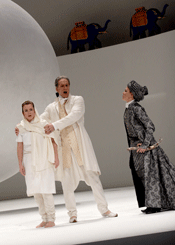 Christine Schäfer as Asteria, Kurt Streit as Bajazet and Sara Mingardo as Andronico
Christine Schäfer as Asteria, Kurt Streit as Bajazet and Sara Mingardo as Andronico
Tamerlano represents the new order wiping away the old. His costumes
constantly change, a dash of colour against the stark black and white design of
the set. Eventually, Tamerlano appears in full wig and train, like a monarch of
the Ancien Regime. It’s not in the libretto, but a telling
observation, for Tamerlano became a tyrant. Handel didn’t need to spell
this out explicitly, but the implications would not have been lost on him. Full
credit to Graham Vick and his team (Richard Hudson, designs).
This production looks uncompromisingly modern, because Handel’s ideas are relevant to modern times : power, integrity, loyalty. The lighting (Mathew Richardson) is oppressively bright, but throws the moral issues in the opera into full focus. Because there’s no unnecessary detail, such details as they are become significant - rows of anonymous servants, moving in stylized obeisance, like machines. Great Empires function through rituals like these. Power is symbolized by a huge foot, bearing down on a sphere which perhaps represents the world. When Bajazet and Asteria crawl under, it feels dangerous, as it should be. They’re not crushed by the set but by what it means.
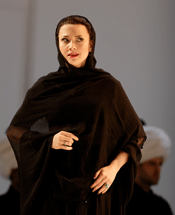 Renata Pokupić as Irene
Renata Pokupić as Irene
Princess Irene appears astride a huge blue elephant. It’s marvelous theatre. But power “is” theatre. The elephant looks comic, like an illustration in a children’s book. But again, there is something faintly ludicrous about these monarchs handing out kingdoms as if they were candy.
Christine Schäfer is a superb Asteria. It’s her debut in this role, too, though like Streit, she has extensive experience in Handel and the Baroque. Indeed, they’ve appeared together, including Partenope at the Theatre an der Wien. The dynamic between them is good.
Schäfer’s Asteria is so strong that she really comes over as her father’s daughter. Such ferocity and strength of purpose. From Schäfer’s diminutive frame emits a voice so coolly resolute, it’s frightening. The famous “whiteness” of her timbre is ideal. Virginal as Asteria is, she has integrity. To honour her father, she’d kill and die. Ostensibly Tamerlano is attracted by her beauty, but her personality is more than a match for his. Perhaps he’s wise not to marry her. He’s safer with Irene.
Asteria’s purity is indicated in her simple white dress and pigtails. She’s a princess from a long line of bluebloods, but rates moral integrity far higher than worldly power. Irene, in contrast, loves power and status, which is why she won’t settle for second best. Renata Pokupić’s Irene makes a grand entrance on the blue elephant, but spends most of the opera huddled under a black veil. She’s biding her time. She sang the role in Madrid in 2008, so she sings it with assurance.
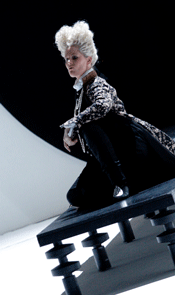 Christianne Stotjin as Tamerlano
Christianne Stotjin as Tamerlano
As Tamerlano, Christianne Stotijn makes a debut both in the role and at the
Royal Opera House. Although she’s well known as a singer, Tamerlano is a
tricky role. Few women can portray a tyrant as butch and as uncouth as
Tamerlano must have been. Possibly more steel in the voice would have helped.
Even though Tamerlano is prepared to spare Asteria, he isn’t a nice
fellow. Acting this part is difficult, as it doesn’t remotely resemble
Stotijn herself. Maybe she’ll distance herself as the run continues and
play it with greater abandon.
Sara Mingardo is new to the Royal Opera House, too, though she sang Andronico in Madrid. She’s accomplished, but the part is very long and wordy. Handel wrote the whole opera in 24 days. Perhaps with more stringent revision he might have reshaped the part so it’s less verbose, so the singer doesn’t have to stretch herself so far for relatively little purpose. Even Leone, a relatively minor but critical part is sung by a newcomer to the Royal Opera House, Vito Priante.
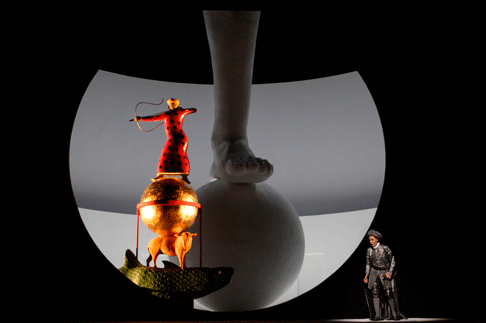 Sara Mingardo as Andronico
Sara Mingardo as Andronico
I liked this first night performance for its freshness and immediacy. If some of the performances were a little tentative, they might mature as the run continues. But Streit and Schäfer are impressive, making this “new” Tamerlano a rewarding experience.
Anne Ozorio
image=http://www.operatoday.com/Bajazet_Streit.gif image_description=Kurt Streit as Bajazet [Photo by Catherine Ashmore courtesy of Royal Opera House] product=yes product_title=G. F. Handel : Tamerlano product_by=Kurt Streit: Bajazet; Chreistine Schäfer: Asteria; Christianne Stotjijn: Tamerlano; Sara Mingardo: Andronico; Renata Pokupić: Irene; Vito Priante: Leone. Ivor Bolton: conductor. Orchestra of the Age of Enlightenment. Graham Vick: director. Richard Hudson: designs. Matthew Richardson: lighting. Ron Howell: choreography. Royal Opera House, London. 5th March 2010. product_id=Above: Kurt Streit as BajazetAll photos by Catherine Ashmore courtesy of Royal Opera House
March 7, 2010
Tamerlano, Royal Opera House, London
By Andrew Clark [Financial Times,7 March 2010]
The good news first: having lost the indisposed Plácido Domingo for the entire run, the Royal Opera found a passable replacement for the role of Bajazet, the imprisoned king in Handel’s most serious opera.
March 5, 2010
Karlsruhe: Rare Verdi, Well Done
But then, does anyone really dream of I Masnadieri? One thing absolutely dreamy about the performance was the starry cast, a first rate quartet of soloists that could hold its own in any major international house. Indeed, when I remarked to a Viennese colleague that I thought the Staatsoper might be happy with these fine vocalists he retorted: “Are you kidding? They would be jealous!”
Barbara Dobrzanska continues to be one of my most favorite spinto sopranos. Having first been bowled over by her Suor Angelica, I subsequently marveled at her Butterfly, admired her Desdemona and Elisabetta in equal measure, and was wrung out emotionally by her tender Liu. But Amalia is one of those early-mid-Verdi hybrid roles that requires in equal part: steely dramatic output over the sometimes noisily scored oom-pah-ing band, heroic Bellini-holdover lyric singing, and Donizettian coloratura fireworks (make up your mind, Giuseppe!). True to form, the Divine Miss D swept all those challenges before her with great elan.
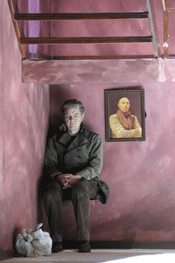 Klaus Schneider as Arminio
Klaus Schneider as Arminio
As ever, her knowing skill in crafting an arching vocal line was informed by her unerring musicality as she presented a well-rounded, varied, and eminently interesting characterization. What was a revelation to me was the facility with which she casually tossed off the exposed roulades and fiorituri, and the telling way each vocal gesture was meaningfully couched. Add to this Barbara’s sincere acting and unaffected stage presence, and we have yet another memorable role form this highly talented artist. Don’t know why she is not regularly treading the world stages by now, but the local public should (and does) rejoice in her continued presence in Karlsruhe.
Another company treasure is tenor Keith Ikaia-Purdy who seems born to sing these Verdi heroes. Although his burnished, ringing tone really shines above the staff, there is a warmly solid presence in the lower reaches as well. That said, the first aria lies a bit ungratefully in the fringes just upward of the middle of the voice, although he negotiated it reliably with his sound technique and professional skill. It was after this opening number that Mr. Ikaia-Purdy really came into his own, and he lavished us with some beautiful phrasing and heartfelt commitment, full of Bergonzian portamento and Verdian temperament. Moreover, he and Ms. Dobrzanska partner each other exceptionally well, and as they rose above the orchestra at full volume, the exquisite outpouring of molten vocalism was overwhelming.
Kammersänger Konstantin Gorny contributed a beautifully judged account of not only Massimiliano, but also Pastor Moser. His richly orotund, cavernous bass is powerfully deployed to outstanding effect. Mr. Gorny wrung the most out his every phrase, and is a stylish Verdian. His instrument lacks the biting edge of many other Russian singers (not a bad thing!), and when the orchestra is playing fortissimo he can blend into the instrumental fabric a bit. But this is a very minor observation in what was a commanding portrayal.
Baritone Stefan Stoll rounded out the quartet with an assured assumption of the role of Francseco. Mr. Stoll has a real Italianate ping in his upper register, and especially relished the many high-lying outbursts that gave great pleasure. Lower down, the tone got a bit more diffuse, sounding more German-generic, although always healthy and well-placed. In the small role of Arminio, Klaus Schneider was secure and did all that was required.
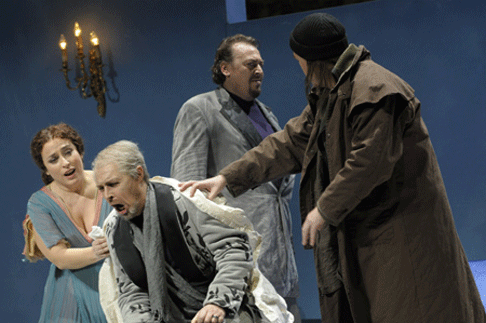 Barbara Dobrzanska as Amalia, Konstantin Gorny as Massimiliano/Moser, Stefan Stoll as Francesco and Klaus Schneider as Arminio
Barbara Dobrzanska as Amalia, Konstantin Gorny as Massimiliano/Moser, Stefan Stoll as Francesco and Klaus Schneider as Arminio
The orchestra had an exceptionally fine evening, playing with brio and stylistic acumen under the inspiring baton of conductor Jochem Hochstenbach. The Maestro not only found good variety in this lesser Verdi, but also maintained the dramatic shape with an unerring sense of pace and color. Johann Ludwig’s cello solo was achingly beautiful. The chorus (and ‘extra’ Chor) were schooled to a fare-thee-well (or an addio) by Ulrich Wagner.
Director Alexander Schulin’s idiosyncratic staging was quirky, to be sure, but he displayed the great, rare gift of making the relationships deeply personal and believably clarifying the story. This is no mean feat, given that the far-fetched machinations of the libretto pretty much follow the improbabilities of the original Schiller concoction. Mr. Schulin started with an imposing unit design by Christoph Sehl as realized by Michele Lorenzini. At curtain rise, a coolly beautiful, blue-green tinted photo-realistic forest drop was revealed. The three leading men wandered variously across the stage in front of it, passing each other without acknowledgment, like lost souls in Purgatory. So far so good.
The drop subsequently flew out to reveal an imposing two-story family manse with a large main reception hall stage left, a stairwell and landing in the center, and a greenhouse stage right topped by a second floor bed room/study, all meticulously constructed and dressed with meaningful, well-chosen furnishings. Behind it was an identical forest drop. And that, my friends, was all. And it was more than enough. In fact, it was splendidly compact.
Carlo plays his first scene isolated in the greenhouse (forest). Bad boy Francesco commandeers and prowls his space in the bed room above like Scarpia in the Farnese Palace. Massimiliano presides over the immense drawing room. Amalia first wanders the stairwell, belonging to none of the above. Lest these visuals sound blunt or obvious, they were essential in establishing and defining the shifting levels of power between the principals.
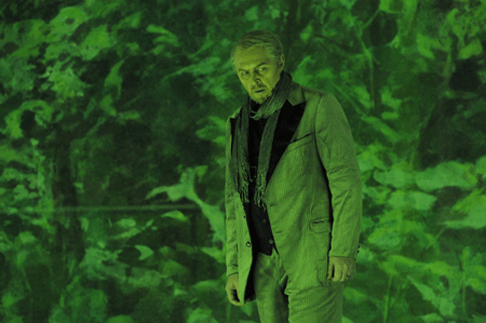 Konstantin Gorny as Massimiliano/Moser
Konstantin Gorny as Massimiliano/Moser
Mr. Schulin showed a deft touch with any number of problematic plot points. Massimiliano’s false “death” was beautifully communicated to us with a subtle ‘take’ from Francesco. The dramatic device of then plopping the coffin on Francesco’s (power) bed as a bier was inspired. The musico-dramatic device of doubling the bass to also sing the priest was brilliant, with the baritone therefore confessing his transgressions not just to a “father” but to “his” father. The similar doubling of Carlo as Rolla, however, made no sense whatsoever. (Ah well, it saved another singer’s fee…)
Although almost all of Ursina Zürcher’s brooding costumes were right on the mark in helping with character development, one widely missed the mark for me, and unfortunately that was the molting Schmatte that was thrown on Amalia, who started out looking like a frump in an ill-fitting cocktail dress at the opening of a Chattanooga Shopping Mall. Over time, one rumply layer after another was torn away and although Barbara looked progressively more shapely, I wish wish I could say that any of the variations truly flattered the diva as she should be.
One such strip tease was the result of Francesco having begun to manhandle her, with her shimmying out of his grasp leaving a layer of organdy. The over-sexed baritone had obviously been told to communicate arousal, but once he had possession of her dress I was not sure if he wanted to climax on it or wear it. (Or both?) The director also frequently has the principals doing stage business in their “room” while a solo is being sung in another. A less experienced hand (or cast) could easily become a distraction, but it is to everyone’s credit that the whole staging is well-calculated to point up dramatic focus. The company was greatly assisted by the well-conceived and atmospheric lighting design from Stefan Woinke.
Karlsruhe has served up a rare treat with its theatrically cogent, musically vivid, immensely satisfying I Masnadieri.
James Sohre
image=http://www.operatoday.com/Raeuber14.gif imagedescription=Keith Ikaia-Purdy as Carlo/Rolla [Photo by Jacqueline Krause-Burberg courtesy of Badisches Staatstheater]
product=yes
producttitle=Giuseppe Verdi: Die Räuber (I Masnadieri)
productby=Amalia: Barbara Dobrzanska/Ina Schlingensiepen; Massimiliano/Moser: Kammersänger Konstantin Gorny/Mika Kares/Ulrich Schneider; Carlo/Rolla: Keith Ikaia-Purdy; Francesco: Stefan Stoll/Armin Kolarczyk; Arminio: Kammersänger Klaus Schneider/Andreas Heideker. Musikalische Leitung und Einstudierung: Jochem Hochstenbach. Musikalische Leitung: Christoph Gedschold. Regie: Alexander Schulin. Bühnenbild: Christoph Sehl. Bühnenbild-Mitarbeit: Michele Lorenzini. Kostüme: Ursina Zürcher. Einstudierung der Chöre: Ulrich Wagner. Dramaturgie: Margrit Poremba.
product_id=Above: Keith Ikaia-Purdy as Carlo/Rolla
All photos by Jacqueline Krause-Burberg courtesy of Badisches Staatstheater
Matthias Goerne at Wigmore Hall, London
The paths on this occasion carried him largely to sombre, meditative places, the domains being defined by a series of mainly minor poets - friends and acquaintances of the composer, and with whom he performed, conversed and relaxed in the Viennese salons of the 1820s.
‘Der Jüngling und der Tod’ (‘The youth and death’), with a text by Schubert’s early champion, Josef von Spaun, opened the recital, firmly establishing the literary and emotional tone; for here, Youth cries out for the ‘calm embrace’ of Death, yearning to be led to ‘dreamed-of’ lands far from the torments of life. Deutsch’s dramatically dark piano postlude presented a stark contrast with the subsequent gentle grace of the strophic ‘Das Lied im Grünen’ (‘Songs in the open air’); but despite the apparent sense of ease, a tremulous disquiet troubled the surface as the speaker looks ahead to the days when life is ‘no longer green’.
Songs by Johann Gaudenz von Salis-Seewis followed. The introspective text of ‘Die Herbstnacht’ (‘Autumn night’) allowed Goerne to settle into the seamless, legato stream of sound - seductively sustained, yet coloured by delicate emotive shadings - for which he is revered. Indeed, the understated melancholy and brooding might have become a little too pervasive, particularly given the performers’ propensity for performing the songs with scarcely a break, and the more agitated contours and sentiments of ‘An mein Herz’ provided a welcome contrast.
Despite the attempts of Richard Stokes, in the programme notes, to bolster the merits of these lesser lights of German Romantic verse (“If Schubert composed some 150 songs to the minor verse of his friends and acquaintances, that does not imply a lack of literary awareness, but rather a gift of friendship”), it was a setting of Friedrich von Schlegel, ‘The Wanderer’, which proved to be the highlight of the first half. Deutsch’s aural impression of the ‘moon’s light’ perfectly captured in rare harmonic nuance the silvery gleam; and, the more sophisticated relationship between voice and accompaniment drew an added depth from the performers - a seriousness which was sustained through the anonymous ‘Klage’ (‘Lament’) and Schober’s ‘Am Bach im Frühling’ (‘By the stream in spring’), where the sudden wanings of colour and weight in the voice revealed the omnipresence of death.
After the interval, Goerne and Deutsch seemed even more in harmony, embraced by a shared aesthetic vision. The second half began with upwardly curving ripples from the keyboard, signalling a rare moment of lightness. In ‘An die Laute’ (‘To the lute’) the serenading lover urges his instrument to be tender and soft - not to win his loved one’s heart, but rather so that the jealous neighbours are not disturbed. After settings of Freiherr von Schlechta and Johann Baptist Mayrhofer, it was again perhaps telling that it was the more stellar figures of Rückert and von Schober who had so obviously had inspired Schubert to expressive heights. The former’s ‘Du bist die Ruh’ (‘You are repose’) was exquisitely shaped, the second climax approached and wrought with remarkably controlled passion. In the concluding lines, Goerne created a quiet stillness of remarkable and touching delicacy. In contrast, the satisfyingly familiar ‘An die Musik’ revealed the darker colours in Goerne’s baritone range, and the dialogue between voice and piano left hand enabled Deutsch to enter into the conversation as both accompanist and equal.
The final two songs, ‘Abschied von der Harfe’(‘Farewell to the harp’) and ‘Liebesend’ (‘Song’s end’) lowered a sombre curtain on the evening’s proceedings. The performers offered no hint of consolation, Goerne sustaining the embedded melancholy until the dying strains, as ‘From a cold heart/ the magic of song now steals away,/ and ever closer step/ transience and the grave.’ As throughout the recital, there were no melodramatic gestures, no exaggerated mannerisms, just a heartfelt sincerity communicated by the most controlled and often understated musical means.
What was most striking about this recital was Goerne’s ability not only to present the material with consummate mastery, but also to convey a genuine sense of inhabiting the experience of these songs; to balance introspection with direct communication, all the while sustaining a mood of intimacy worthy of the Schubertiaden itself.
Claire Seymour
image=http://www.operatoday.com/GOERNEBorggreve006.gif imagedescripton=© 2008 Marco Borggreve for harmonia mundi
product=yes producttitle=Matthias Goerne at Wigmore Hall, London productby=Matthias Goerne, baritone; Helmut Deutsch, piano. Wigmore Hall, London, Sunday 28th February
Ariadne auf Naxos, New York
Kyrill Petrenko bringing out all the elegant, edgy Schwarmerei of a score that is supremely sophisticated without being too sophisticated to believe in fanciful dreams, and the production, for once in a long while, was a production of the opera being performed, so that all the parts fit together instead of sticking out like bleeding, inefficiently amputated limbs. All was bliss. I can’t remember the last time I so thoroughly enjoyed being at the Met.
You remember the colorful Elijah Moshinsky production, with its vertiginous three-story farthingales on the earth spirits, its rather overdone acrobatics, its sky map giving way to shipscape giving way to setting (or is it rising?) sun? Well it’s as charming as ever. Laurie Feldman’s redirection has no doubt been hampered by having a cast of comparatively slim singers for once — her Brighella, has to wear a false tummy to live up to commedia expectations — but all were game, and the clowns tossed Zerbinetta about in the air in mid-roulade without hampering her breath control. (Diana Damrau, over in La Fille du Régiment, take notice.)
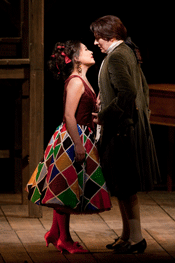 Kathleen Kim as Zerbinetta and Sarah Connolly as the Composer
Kathleen Kim as Zerbinetta and Sarah Connolly as the Composer
Sarah Connolly, who sang the Composer radiantly, is not a pretty woman, and
she makes her looks work for her in her frequent assumption of trouser roles
(Giulio Cesare, Romeo, Ariodante). As a lover, she is sometimes less than
convincing, but she was irresistibly right this time for the adolescent,
idealistic musician, Strauss’s tribute to his beloved Mozart:
clumsy-charming and visibly a-quiver when a seated Zerbinetta casually leaned
on his knee. Connolly sang the little air to Cupid and the fervent hymn to
Music (the two gods, one might say, who preside over this opera) with a fervent
delight that reminded more than one listener of Troyanos and was certainly the
most enthralling account of the part to be heard at the Met since her day.
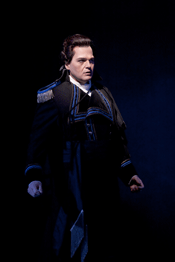 Lance Ryan as Bacchus
Lance Ryan as Bacchus
I think I’ve never heard a bad Zerbinetta — they’re either
good or terrific in my experience, which goes back to Reri Grist — and
Kathleen Kim (if not quite Swenson or Dessay) was on the terrific end of the
spectrum. She is one of the tiny Zerbinettas (a group including Grist
and Dessay), and she makes use of her size and agility to boss big
folks to great comic effect. Her bewitchment of the hapless Composer is quite
believable. In the early scenes her trills were on the colorless side, but all
was in place by the time her “Grossmächtige Prinzessin” began. In
that bravura number, where the cascades of ornament can often lack color, she
made the notes identifiable notes and brought down the house.
Nina Stemme is too rare a visitor on these shores, as the great dramatic German roles are currently in disfavor here or tend to be performed by second-rate Americans. She sang Ariadne with torrents of earth-deep sound in colors of cognac and sherry, rising to superb heights, rich with frustrated — and then idealized — emotion. She is also as slim as any lover of the opera could desire, and plays a glamorous send-up of a diva.
The trio of “earth-spirits” were charming — and in the higher reaches of the house, I’m told, blended with unusual delicacy.
Though all very decent, the men were not quite so fine as the women in the cast. This is not a tragedy in Strauss, who would have done without male voices entirely if he’d been permitted to do so. Lance Ryan sang the high-lying role of Bacchus without a squall or a crack, in itself an achievement, but with a dryish color that did not always give pleasure. Jochen Schmeckenbecher sang an admirable Music-Master, and the comedians were ably handled by Markus Werba as Harlekin — one has heard more sensuous serenades — Mark Schowalter, Joshua Bloom and Sean Panikkar. In this staging, Scaramuccio and Truffaldino have very little to do and no distinction, but Panikkar gave Brighella a distinctive sound and antics.
Michael Devlin — surely not the man I heard sing Ptolemy to Sills’s Cleopatra forty years ago! And the Count to Te Kanawa’s Countess thirty years ago! But yes, it was he — performed the speaking role of the Major-Domo with archducal hauteur, a man so snooty he regards singing in an opera as beneath his dignity.
Kyrill Petrenko demonstrated clarity and genuine feeling for Strauss’s mingling of delirious motifs, and produced not just a musical fabric but a philosophic statement. The singers all found him easy to work with — they went about their comical antics without appearing to pay him any attention, but they were always together and he was always having fun. So were we.
John Yohalem
image=http://www.operatoday.com/ARIADNE_Stemme_as_Ariadne_1.gif image_description=Nina Stemme as Ariadne [Photo: Marty Sohl/Metropolitan Opera] product=yes product_title=Richard Strauss: Ariadne auf Naxos product_by=Ariadne: Nina Stemme; Zerbinetta: Kathleen Kim; Composer: Sarah Connolly; Najade: Anne-Carolyn Bird; Dryade: Tamara Mumford; Echo: Erin Morley; Bacchus: Lance Ryan; Music Master: Jochen Schmeckenbecher; Harlekin: Markus Werba; Brighella: Sean Panikkar; Scaramuccio: Mark Schowalter; Truffaldino: Joshua Bloom. Production by Elijah Moshinsky. Chorus and orchestra of the Metropolitan Opera, conducted by Kyrill Petrenko. Performance of February 15. product_id=Above: Nina Stemme as AriadneAll photos by Marty Sohl/Metropolitan Opera
March 4, 2010
Zürich mal Zwei
No fooling, the dazzling visual included a primordial mist-scape of greenish-yellows and warm golds peopled with athletically leaping dancers in primitive body suits, angrily threatening a handful of prone choristers. What volumes it spoke of the theme of other-worldly control of man’s fate. What excitement it portended for the evening to come. It was with eager anticipation that I entered the auditorium.
Would that I could say the Idomeneo I experienced lived up to its graphics.
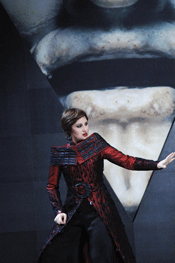 Eva Mei as Elettra
Eva Mei as Elettra
Nikolaus Harnoncourt, recently turned eighty, is a justly revered conductor, mentor, advocate, and operatic practitioner. His many accomplishments and successes are the stuff of legend, to the world in general and Zürich Opera in particular. But past triumphs be damned, we are only as good as our next show. And on this evening, while I found much to admire in his music-making, I found his staging (in tandem with his son Philipp Harnoncourt) to be dramatically unengaged and well, sometimes downright inappropriately silly.
Ma, prima la musica. The period orchestra was in a pit that was yanked up higher than I thought necessary, and while that facilitated its dramatic participation in the show (more to follow), given the Maestro’s substantial physique he loomed too large-and-in-charge as a visual distraction (sure glad I wasn’t sitting in those expensive orchestra seats behind him!). That Mr. H. knows his way around Mozart is a well-established foregone conclusion, and the meticulous attention to the smallest orchestral detail was revelatory. However, it has to be said that the sense of ensemble, especially in Act One, was not always equally attentive. On varied occasions, chorus and soloists got just behind his baton-less beat, a flaw that marred a few otherwise well-sung set pieces.
It must also be Mr. Harnoncourt’s wish that many of the pervasive recitatives be delivered as cooed, mewed, and bloodless statements. Just because a character is having a moment of introspection, shouldn’t mean that they have to lose the ‘point’ of the tone, or that they should become nigh unto inaudible. This delivery resulted in a number of turgid moments when the drama lost its forward motion, something Idomeneo can little afford. The arias were another matter entirely, lovingly shaped and propulsively led.
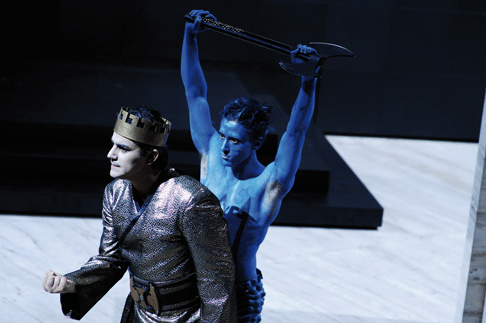 Saimir Pirgu as Idomeneo and Arman Grigoryan
Saimir Pirgu as Idomeneo and Arman Grigoryan
The most interesting musical consideration, is that Nikolaus and company here presented the ‘Munich’ version of Idomeneo, which resulted in substantial opportunities for extended dance moments, but which jettisoned the most famous aria in the piece, the eleven o’clock number D’Oreste d’Aiace. (Yes, you read it here…)
Thankfully, all the movement was exceedingly well choreographed by Heinz Spoerli. Indeed, the inventive dances were superbly executed by the talented young members of the Zürich Ballet. The extended finale gave much pleasure and would be an ideal addition to any compilation evening of any world company on any world stage. There was especially compelling use of the sinewy, inexhaustible male corps who leapt and spun, confronted and corralled the mere mortal citizenry. The threatening monster was brought on stage and eloquently danced by a muscular ballerino, all got up in briny and sparkling blue like a Vegas ‘Mister Sea.’ But say that name with a sibilant ‘s’ and you’ll have some idea of the menace he conveyed. (Nooooo, not the tour j’etee… .noooooooo… .arabesque?…arrrrrrggggggh…)
And that sort of sums up the lack of interest in dramatic tension. The Harnoncourt Boys have delivered us Idomeneo-Lite. There was some PR babble about no one yet having seen the ‘true’ presentation of this opera, and we rightly think that if Harnoncourt speaks we should listen. But the show itself was lacking in impact and emotional honesty. The entire Abraham-Isaac moment when the father is spared by the fates from sacrificing his son should be gripping, moving. Here it was glossed over as a facile plot point to be dispensed before dancing the finale.
The directors couldn’t seem to communicate if it was to be played for any comedy that could be mined, or if the relationships even mattered, or if it was guardedly anguished, or if it was realistic, or if it should resemble Bert-Brecht-on-a-Back-Burner. So they decided not to decide, and put all of it together. For an example:
As four instrumentalists stood up in the pit, and started to move around, I thought “gee, I hate that they can’t just sit there until the intermission even if they are finished for the act.” But no, the wind quartet made its way onto the stage for God’s sake, and tootled along in their black orchestra drag to Se il padre perdei. They played immaculately, but looked as uncomfortable as we were (not to mention poor Ilia). At aria’s end they simply sauntered off stage.
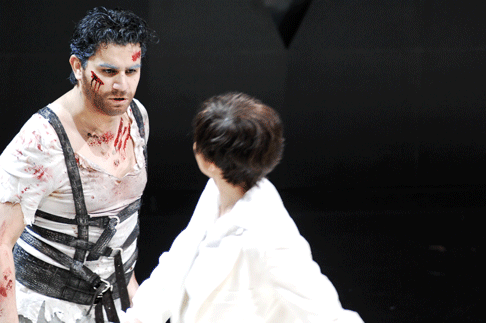 Saimir Pirgu as Idomeneo and Marie-Claude Chappuis as Idamante
Saimir Pirgu as Idomeneo and Marie-Claude Chappuis as Idamante
Elettra’s Idol mio found her entering through the pit as a fashionista with traveling case, hat, and other accoutrements. She then played the number as a clothes horse in search of a hitching post…which unfortunately included stops to tousle the hair of, and deliver Hot Mama come-hither business to several embarrassed male cellists. But even were it not for these couple of quirks, the fact is that there was no chemistry between any of the characters because none was asked of them. They were talking the story’s talk but not walking the corresponding dramatic walk. In fact the meandering blocking did more harm than good. And more is the pity, since overall the cast was highly skilled and capable of so much more.
Young (29) Saimir Pirgu was a revelation to me in the title role. Nothing about his uneven traversal of Santa Fe’s Alfredo last summer augured well for his assumption of Mozart’s most challenging tenor role. What a happy surprise then that I can report that Mr. Pirgu not only has the goods, but serves them up with relish. His passage work is clean, even fiery, his top secure and ringing, and his styling always attentive to Mozart’s wishes (save for some sanctioned crooning). There is still marginally less presence in his mid-range than in the extremes, and he is still not wholly engaged in the moment. But if Saimir can stop appearing quite so satisfied with his accomplishments as they are, and put his energies and considerable talent into where they could be, he could easily become one of the leading exponents of the role.
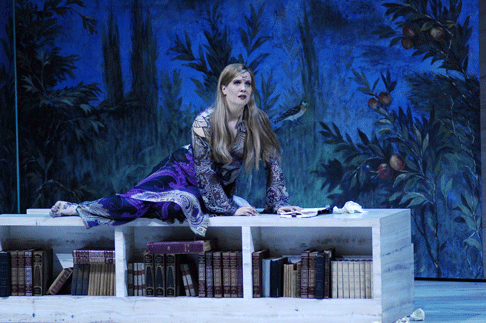 Julia Kleiter as Ilia
Julia Kleiter as Ilia
Julia Kleiter made a fine impression as Ilia, with crystal clear tone, limpid phrasing, and secure command of every facet of this complex vocal writing. I am quite sure she is capable of more spunk and sparkle, but was held back in a wilting violet, at times self-pitying character concept. Local girl Marie-Claude Chappuis was a clear audience favorite as Idamanate and she was roundly cheered. I found her voice an acquired taste, which to be fair I did actually acquire over the course of the evening. When Ms. Chappuis began I though her tone placement rather far back, not unlike Kasarova (also a local fave) in her lower register. Although a capable technician, this limited her color palette. Also, she was allowed to melodramatically ‘act’ like a male, all swagger and arm-swinging artifice, which did nothing to make her case. However, as the show wore on, and as she was able to let loose a bit more, I thought her straight-ish tone assumed more warmth and communicated considerably more character.
I first heard the young Eve Mei as a bewitching Luisa Miller some years ago. The intervening years have compromised a bit of the sheen and oomph in her lower voice. Happily, her lustrous top and reliable chest tones remain glorious, and our diva is as always a commanding stage presence. Ms. Mei’s consummate artistry was deftly deployed in negotiating the role of Elettra, and is to be credited for making a seamless impression even as she stitched together traversals through the lower middle. While we were deprived of her final aria, she nonetheless made the most of her closing outburst, vocally and dramatically, pulling down a giant black scrim and flourishing it as she exited stage left in Diva High Dudgeon.
The blind Arbace was Christoph Strehl in a successful role debut. His meandering and lengthy aria might have benefitted from a more variable color palette, but he negotiated it well, and made the most of his stage time, although hampered by a Konzept that relegated him to being a bit of a cipher, on the fringes of the story. Rudolf Schasching was imposing as the Gran Sacerdote but I wished he had sung it more and yelled it less. Mozart wrote notes for all those screamed phrases! Pavel Daniluk might have made more of an impression as La Voce had his orotund off-stage pronouncements been a teeny bit closer and/or better miked. As it was he sound like he was trapped in the men’s room. The smallest of small roles nevertheless contributed some lovely singing in the person(s) of Gloria Gottschalk and Julie Bartholomew (two Cretans) and Noel Vazquez and Flavio Mathis (two Trojans).
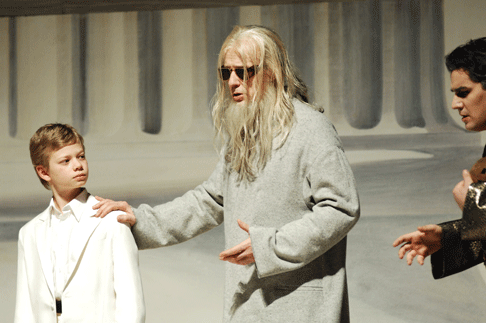 Christoph Strehl as Arbace
Christoph Strehl as Arbace
Although the costumes were all over the place in period and style, they were always handsome, often dramatically appropriate, and frequently witty. Credit the eye-catching attire to Renate Martin and Andres Donhauser, who I hope might be persuaded to re-think Ilia’s sort of paisley gown that not only seems trapped in the 60’s but does not flatter the lovely Ms. Kleiter’s coloring. The costumers did deliver a visual coup by putting the final ballet and then the returning choral forces all in white, a breath-taking evocation of a resplendent day at the beach.
Conversely, Rolf Glittenberg’s set design was curiously simplistic, the four rolling wagons looking more at home at a university opera workshop than on one of Europe’s major stages. They were decorated ‘okay’ with bits of ancient ruins on one side and flora/fauna on the other. A large black wall with a ‘V’ occupied stage right, containing a likeness of Neptune’s face. But while it swung in and out a few times (oooooh), it grew predictable and monotonous. The best technical moments actually came when the stage got cleared for the beautifully costumed dance numbers, and we could rejoice in the projected backdrops and the masterful lighting of Jürgen Hoffmann.
It was at those winning moments that Idomeneo fulfilled the great Promise of the Poster.
I am not sure if the next day’s Kőnigskinder had a good poster or not, or even if it had a poster at all. I do know that it was arguably my finest experience at Zürich Opera, and no need to beat around the bush as to why: Jonas Kaufmann and Isabel Rey must be two of the most thrilling artists to be found on the opera stage today.
The role of Humperdinck’s Goose Girl asks that its impersonator possess the youthful look of a Hannah Montana and the voice of a Sieglinde. Ms. Rey emphatically has the latter, and owing to her slight frame and inventive acting, effortlessly communicates the former. She inhabits the damaged girl’s persona like a second skin, and the hint of metal in her tone means every word is heard, every subtlety lands. She can not only vocally convey tremulous awe, deep-rooted anguish, and breathless anticipation, but can also will her well-schooled instrument to soar, tinged with unbridled joy. Masterful!
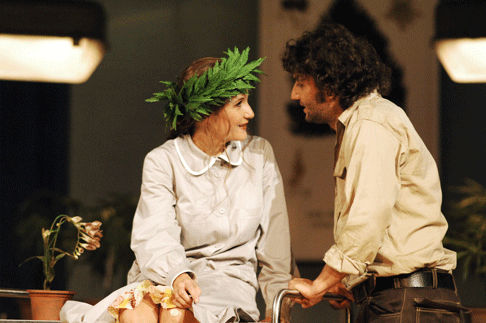 Isabel Rey as Magd and Jonas Kaufmann as Königssohn
Isabel Rey as Magd and Jonas Kaufmann as Königssohn
Mr. Kaufmann matches her for youthful demeanor, of course, and is second to none in fully embodying his characters. Jonas is born to the stage, but does not settle for generic comportment. The bewildered, well intentioned King’s Son gives him a chance to plumb depths of personality that results in a well-rounded and fascinating characterization. His burnished, at times brooding tone can smolder one minute, then ring out the next, then scale back to controlled mezza voce singing, and then execute some of the most intense high pianissimi I have heard from any tenor currently active (pace, JDF). At the peril of asking this out loud and jinxing it: Is Jonas Kaufmann the next world class star tenor we have all been waiting for? Time (and endurance) will tell but at this very moment there is no one quite like him.
But as terrific as they are singly, Rey and Kaufmann in tandem are musical magic. As they rode the whole orchestra in full-throated ecstasy my Thrill-and-Chill-Meter went off so many times that the goose bumps threatened to become a permanent condition. Later, their perfectly judged, deeply felt death scene found my eyes welling up with tears, so completely captured was I by their simplicity of purpose and their magnificent artistry. Flawless.
But this is Kőnigskinder, for God’s sake! That ‘other’ Humperdinck. The lesser one we don’t talk about, much less produce. Luckily, Zürich Opera didn’t get that memo and gifted the work with a compelling production. No pretty fairy tale setting for designer Mathis Neidhardt who instead created a dreary institution (boarding school? asylum?) with blue-ish gray walls and hanging industrial lighting fixtures, within which he suggested the opera’s bucolic Act One setting by placing us in what must be the botany room. Tagged potted plants abound on numerous rolling lab carts.
The Goose Girl is discovered alternatively day-dreaming and doing her homework, seated at one of the downstage carts, when a gaggle of young school girls burst in carrying a gaggle of paper cut-out geese on sticks like crude Japanese puppets. Are they teasing the heroine? Or playing a familiar and welcome game? The mysterious nature of the Goose Girl is captured in a portrayal that is reminiscent of the complex title character of Agnes of God. Part innocent, part child, part adult, part simpleton, and part yearning to be street-wise, this was a richly rewarding combination of subtexts, and one that Ms. Rey carried off to perfection.
When the King’s Son encountered her, he did so in the context of an intruder crawling through one of the massive windows on the side wall. Was this his first visit? Or was he simply another resident of the home returning to a recurring scenario? The vagaries of the story allow for such speculation, and the imaginative director Jens-Daniel Herzog devised richly rewarding character development and stage business. Not the least of his success was in drawing such youthfully believable, charismatic portrayals from his leading couple.
For instance, when it came time for the first kiss, the Girl was seated atop a cart, and the Son gingerly stepped up on the lower shelf causing the cart to roll slightly and break the moment. Both laughed at the mis-fired attempt. Then with locked gaze, and certain purpose, Jonas carefully stepped on again, moved to lock lips, and ‘just’ as he and Isabel tenderly kissed, he pushed off the floor with his other foot and they glided across the stage in perfect coordination with the orchestral effect. I am telling you, it was as unforgettable an image as when ET and Elliott flew across the face of the moon on the bicycle. Wow.
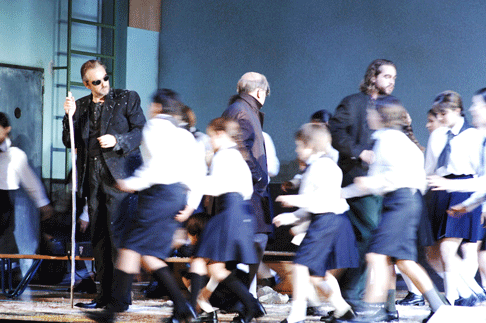 Oliver Widmer as Spielmann, Volker Vogel, Reinhard Mayr as Holzhacker and Kinder- und Jugendchor des Opernhauses Zürich
Oliver Widmer as Spielmann, Volker Vogel, Reinhard Mayr as Holzhacker and Kinder- und Jugendchor des Opernhauses Zürich
Liliana Nikiteanu’s Witch was assuredly sung with a honking big brass voice even up and down the scale; dramatically she was a school marm that combined the worst of Miss Jean Brodie and the best of Elmira Gulch. Oliver Widmer made the most of his crucial role as the (wandering) Minstrel, with a generous outpouring of stylish tone. Reinhard Mayr’s Woodcutter was a bit rough-and-tumble at first but later settled into a more vocally-controlled brash figure. The Broom-Maker was a jewel of an entertaining performance as presented by Boguslav Bidzinski, whose pleasing tenor was musically sound and deployed with theatrical flair.
In place of Act Two’s city street and (plot important) gate, the back wall rose to reveal…an identical back wall! But the room was expanded and transformed into the institution’s multi-purpose room, complete with kitchen/canteen, and a makeshift stage to accommodate some VP visitors who are coming to the place for an indeterminate ceremony. Among those dignitaries, the Head City Councilor was memorably portrayed as a frail-voiced, doddering old fool by Kai Florian Bischoff. The Landlord was competently sung by Tomasz Slawinski, and his Daughter (Anja Schlosser) was a randy Goth party girl who acted with real abandon. Her enthusiastic singing was occasionally marked by rowdy incaution. Stephanie Ritz evinced great empathy and offered plangent tones as the Broom Maker’s Daughter.
Act Three found us back in the same setting, now in ruins, with furniture over-turned and with copious snow blowing in through the open windows. It was with this act that resident designer Hoffmann’s stage lighting came into its own with splendid side and area effects. At first I thought I had visually tired of the basic box, but I have to say I cannot imagine the couple’s final moments working better any other way. Here they were, back where they began, climbing in through the window (in effect ‘breaking in’) to face their destiny in the oppressive, mysterious environment from which they had briefly ‘escaped.’
However engaging the production, or starry the singers, it all would have been for naught without a conductor able to make this massive orchestration spring to life. And here we were equally fortunate to have Ingo Metzmacher in the pit eliciting superlative playing from this talented band. His attentive sensitivity to the singers and the total understanding of the shape and pacing of the drama surely must place Maestro Metzmacher among the top opera conductors of the day. The string ensemble was especially warm and incisive, although pride of instrumental place must be given to the superb, bird-like solos from the principal flute.
With this world-class Kőnigskinder, Zürich has added another jewel to its crown.
James Sohre
image=http://www.operatoday.com/DSC2576.gif imagedescription=Saimir Pirgu as Idomeneo [Photo by Suzanne Schwiertz courtesy of Opernhaus Zürich]
product=yes
producttitle=W. A. Mozart: Idomeneo
productby=Eva Mei (Elettra), Marie-Claude Chappuis (Idamante), Julia Kleiter (Ilia); Saimir Pirgu (Idomeneo), Michael Laurenz Müller (Arbace), Rudolf Schasching (Gran Sacerdote), Pavel Daniluk (La Voce). Dirigent: Nikolaus Harnoncourt. Inszenierung: Nikolaus Harnoncourt. Ko-Regie: Philipp Harnoncourt. Choreographie: Heinz Spoerli.
Bühnenbild: Rolf Glittenberg. Kostüme: Renate Martin, Andreas Donhauser. Lichtgestaltung: Jürgen Hoffmann. Choreinstudierung: Ernst Raffelsberger. Ballett:
Zürcher Ballett. Orchester La Scintilla. Chor der Oper Zürich.
product_id=Above: Saimir Pirgu as Idomeneo
All photos by Suzanne Schwiertz courtesy of Opernhaus Zürich.
March 3, 2010
Emilie, Opéra de Lyon
By Andrew Clark [Financial Times, 2 March 2010]
She was learned and sexually liberated, a product of the 18th century but a role model for our time - “a great man whose only fault was being a woman”, according to Voltaire, her sometime lover. History has tended to place Emilie du Châtelet (1706-49) in Voltaire’s shadow, but she stole the limelight at Monday’s premiere of a new opera by Finnish composer Kaija Saariaho.
Sophia Serghi — An Interview
Her musical studies included work with Jonathan Kramer and Fred Lerdahl at Columbia University. She has been commissioned by groups including the Nash Ensemble and Relache. We spoke via Skype on February 5, 2010.
TM: You were born in Cyprus.
SS: I was born in Nicosia, Cyprus, in 1972, and grew up in a very musical and culturally interesting family. My mother was a musician. She was a pianist and also a composer. She wrote music for choirs and also did a lot of theatrical productions for children, and wrote the music for those as well. She was a very accomplished pianist — she studied at the Sorbonne, and at the Guildhall School. Coming out of a very small place like Cyprus she was a rare phenomenon. She also was a Professor of Music Education at the Ionian University in Greece. My father had theater in his background. He was a trained classicist and historian with a masters from Harvard as well as degrees from other countries, but his love was the theater, and he did finish drama school in Athens, Greece. He went on to produce a lot of plays, and he ended up being Minister of Culture on the island for thirty plus years. So I was surrounded by musicians — Yehudi Menuhin would be coming through for a performance. I remember him as a kid. My father told me stories about Kurt Masur visiting with the Leipzig Gewandhaus orchestra, and would bounce me on his knees. Zubin Mehta…basically I was around a lot of culture when I was growing up, but in a very small and isolated part of the world, because Cyprus is a tiny place, and only gained its independence in 1960. What I am describing only happened ten years after independence, since I was born in 1972. My father was responsible for setting up the National Theater, the State Orchestra of Cyprus, the National Gallery — lots of artists, painters, dancers would come through — the Ballet Russe would come through. That was my background. When I was fifteen my parents allowed me to participate in the American Field Service program (AFS), going to a great school in the Chicago suburbs, New Trier High School, with four orchestras, a full opera production troupe, three choirs — it was better than most colleges. It was complete coincidence that I landed there. That year I realized I could do something with all the music writing that I had been doing throughout my youth. My mother would give me lyrics for the songs in her plays and say “Here — try these!” and so on. I started studying piano at six, and I was more interested in writing music than in practicing what was on the page.
TM: That’s a very common story — that the composer is less interested in other people’s music than in writing their own.
SS: I would drive the piano teacher crazy — she would give me an assignment, and the next week it would be transposed into a different key, I would be adding my own counter points, and eventually she just said “Bring me your stuff.” When I discovered contemporary music during my year in Chicago, it completely changed my life. I had an opportunity to perform on stage at Carnegie Hall under John Rutter’s direction as part of the choir from New Trier. Meeting John Rutter and realizing that a composer can have a life put things into context. I had to return to Cyprus to finish high school and after that I was convinced that I would return to the United States to pursue music composition as a career.
TM: Please say a little more about Cyprus, since many people in the US will not know so much about the island.
 SS: Cyprus did not have a chance to get on its feet after independence because in 1974 Turkey invaded the island, and since then it has been divided in half. I was one and half years old when that happened, and as a result I spent some time in England with my mom, since my grandmother was living in England. Any infrastructure in place in 1960 was set back because of the 1974 war. My father, since he was in the government, remained on the island, and once the immediate danger passed, my mother and I returned, and the country began rebuilding. Education on the island has always been great, but there were gaps. For example, I wanted to study cello, and there was nobody who could teach me cello at the time. My piano teacher was spectacular, but up to a certain point — the idea of studying Prokofiev was totally outlandish. Chopin was as far as anyone would go in terms of new music, or maybe Liszt, so when I came back from my one year in Chicago, and had learned Prokofiev, had listened to new music, I got very much intrigued by this whole thing.
SS: Cyprus did not have a chance to get on its feet after independence because in 1974 Turkey invaded the island, and since then it has been divided in half. I was one and half years old when that happened, and as a result I spent some time in England with my mom, since my grandmother was living in England. Any infrastructure in place in 1960 was set back because of the 1974 war. My father, since he was in the government, remained on the island, and once the immediate danger passed, my mother and I returned, and the country began rebuilding. Education on the island has always been great, but there were gaps. For example, I wanted to study cello, and there was nobody who could teach me cello at the time. My piano teacher was spectacular, but up to a certain point — the idea of studying Prokofiev was totally outlandish. Chopin was as far as anyone would go in terms of new music, or maybe Liszt, so when I came back from my one year in Chicago, and had learned Prokofiev, had listened to new music, I got very much intrigued by this whole thing.
During my teens, after perestroika, there were a lot of Russians who came to the island to study how capitalism worked, instead of going to a totally western country. Cyprus was close, and it was something between the Middle East and Europe, so it was a safe haven for the Russians. When the Russians would arrive to take their seminars in capitalism, my father did lectures in classical Greek civilization. As a gift they would give him records, so he would bring home Schnittke, Sviridov and Gubaidulina and all these out-there composers whom I had never heard of. I had those sounds in my head, but I couldn’t put them in context until I came to the United States and realized that wow! These composers whose music I love are actually real people, and belong to a context called “contemporary music”. So Schnittke and other Russian composers played an important role in my early life as a composer.
TM: How did Cyprus come to become a British protectorate?
SS: That’s a long story. Cyprus had never been anything on its own until 1960. It had always been in the hands of some conqueror, be it the Venetians, or Richard the Lionheart, or the Franks, or the Ottoman Empire. Cyprus was sold to the British by the Turks in the later nineteenth century. In 1959 there was a liberation struggle.
TM: How much of the population spoke English?
SS: Everyone speaks English, and the education system and the constitution was very well-thought out because of the English. The infrastructure was way ahead of its time. But they never imposed English in the schools — Greek was always the main language. Until this day the English School is the best private high school on the island. Everything about the culture is very much Greek, but it’s a melting pot of the Middle East and Europe. The language we speak on the island is a Cypriot dialect which is quite different from what is spoken in mainland Greece. It’s a little closer to classical Greek, a little more archaic. If I was speaking with a friend, and someone from Athens was listening, he would understand about thirty percent of what we were talking about. It’s quite a different language.
TM: Are there influences from Italian and French?
SS: Yes, Turkish, Italian, some French. The official language taught in school, though, is Modern Greek.
TM: Were you studying composition as a child with your piano teacher?
SS: Not formally at all. I kept writing on my own. Basically, I imitated anything I was listening to. If I was listening to Shostakovich, I would imitate that. If I was listening to Mozart, I would imitate that. Any records that came into my hands, and I fell in love with — I would just write in that style. But it was entirely on my own, and it wasn’t until fifteen, when I was in high school in Chicago, that somebody actually noticed that I did that. I wrote a requiem that year, and my choral teacher at the time encouraged me. There were no formal lessons until I went to college here in the United States. That being said, though, I had enough of a portfolio that I applied to Cambridge University to study composition simply because I thought “John Rutter is a product of Cambridge, so I will apply to Cambridge”. As simple as that. Cypriots who wanted to study abroad would go through the process of taking four or five A-levels, and would also take SATs if you wanted to have the option of going to the United States, and Greek examinations for the Greek universities. I took my A-levels and did really well on them, was accepted to go to King’s College, Cambridge, but then I got a Fulbright scholarship to study in the United States, which meant that my parents would have to pay nothing, so I did that instead. My life would probably have been very different had I gone to Cambridge, from a musical point of view, because studying in England at the time (1990) was very different. It was a very narrow track, in comparison to a small liberal arts college in one of the most liberal cities in the United States — Portland, Oregon, which was very, very far away from Cyprus, which for me was a plus at the time, since I was looking for adventure.
TM: What sort of music were you exposed to, in terms of popular music, while you were still living in Cyprus?
SS: It was clearly UK top 40, basically. We had one Greek Cypriot radio station, and the British bases — since as part of the liberation in 1960 Cyprus gave the British two rather large pieces of land that are used as military bases — which had a radio station. So we would listen to the top 20 charts once a week. I would wait for that one time a week when I could turn the radio on, sit down with my tape recorder, tape the top 20 for that week, and listen to them over and over and over. Michael Jackson, Madonna — that is what came from outside. Then there was Greek popular music, a completely different thing entirely. We had Greek tradition music as well, Greek Cypriot traditional music, plus classical music from the various groups that would visit Cyprus. I loved popular music, and I still love it. I teach a seminar on hip-hop in sub-Saharan Africa. I love popular music.

TM: How was it arriving in Portland, Oregon? Was it a shock, culturally?
SS: I arrived wearing a blue blazer and a white turtleneck — I looked like an Oxford University prep kid. My roommate that first day took one look at me and thought “Oh my God! What am I getting into here?” She was wearing Birkenstocks and clothes that looked more like pajamas that she got from a thrift store and patchouli oil…within six months we had met half-way. I became more of a hippie and she cleaned up a little bit. It was a huge culture shock. I immediately became immersed in the music — I loved the whole grunge scene that was happening at the time. Portland was very, very big on the map in grunge terms because Seattle wasn’t that far away, San Francisco was right down below. Portland had its own grunge bands, mosh pits, and so forth. I was sixteen and a half, and Portland was such a liberal, open-minded town that it completely changed my life. I could not have gone to a more foreign place.
In a lot of respects, I became an ultra-open-minded person, not just personally and politically, but musically. The great thing about Lewis and Clark College is that it’s a very small place, and the ratio of instructor to student was 1 to 5. I got a lot of attention from my professors, whom I got to know personally. Three of them had a huge impact on my life as a musician for many years.
TM: Who were you studying with?
SS: My first teacher was Vincent McDermot. His main influence was in world music, and specifically the Javanese gamelan. Lewis and Clark is known for its great world music program — there’s the gamelan, there is Obo Addy, who does Ghanaian drumming. I studied Indian vocal styles, I sang in the gamelan, I played in the gamelan. This exposure to world musics gave me an appreciation of my own background, because growing up in Cyprus I would shun the Greek music thing. “Oh my God, this is so boring….let’s turn it off”. Once I realized that the sounds from the gamelan would find their way into my music it opened the door to all the rhythmic, frenzied music I had been exposed to while growing up. It was a huge liberation for me to come to terms with my own heritage, that I didn’t have to sound like Stravinsky, I could sound like a melting pot, which is how I still sound.
TM: When I think of music from that part of the world, I often think of irregular meters.
SS: I remember in my first composition class, not with Vincent McDermot, but with my piano teacher at the time, at Lewis and Clark. She asked us to write a piece, and for me it was normal to write in 11/8, and then jump to 7/8, and go to 5/8 — it was something innate. I performed the piece on the piano, and everybody was thrilled, with questions about “what does 11/8 sound like?”, “how do you break it down”….that’s been in my music effortlessly. It finds its way in, whether I think about it or not. That’s the same for a lot of modalities and collections of notes that I tend to use. That being said, the Javanese gamelan also had a huge effect on me in terms of choice of notes.
My piano teacher, Alexander Lee Frick, was a wonderful man. He passed away a couple of years ago. He had studied with Arturo Benedetti Michelangeli, and had a great career as a pianist himself, and became a great teacher. Through Lee, I became a really good pianist. At the time I was a brilliant pianist, and when I graduated from college I had a choice — to either go become a professional pianist or go to grad school in composition. Composition won me over, because although I love performing on the piano, and I still do, very much, I am a people person — that comes from my culture, I think. I couldn’t think of practicing by myself in a practice room for seven hours at a stretch, in order to keep up with the caliber that I was at the time. Composition always came more easily — it was just a way of life for me. Grad school was a breeze. I loved it — it was easy. Had I gone to study with John Perry at USC, it would have been a lot of hard work. I took the easier road, and went to Columbia.
TM: And New York City is the cultural capital of the US.
SS: I went from this expansive, natural place to a room that was an 8 by 11 foot cell that I lived in for four years while I was at Columbia, at International House, which was a great place to live, but you don’t have much space. My outlet was my window- I had a million-dollar view, overlooking Riverside Park, Riverside Church and the Hudson River. And my radio, which was just phenomenal, because I had such a wide range of music in my little cell. I would write music with the radio on and the window wide open and I would let the city sounds come in. I wrote very eccentric and adrenalin-crazed music at the time. My main teacher there, Jonathan Kramer, was a huge influence in terms of pushing my boundaries, allowing me to go in a direction that I wouldn’t normally, saying “if you feel this adrenalin, throw it in there. Go wild. Push your performers to the limit.” And I did. I wrote really virtuosic pieces that required a lot of stamina, but at the same time, accessible to the audience.
TM: How do you choose what style to work in? In the USA now it seems like anything is possible. How do you choose from all the possibilities on the menu?
SS: When I arrived at Columbia, it was one year after Mario Davidovsky had left to go to Harvard. Mind you, when I was in college, I was aware of Modern music, I did exercises as part of a theory course, was aware of the imposing position that Modernism had had in the United States for quite a while, but I had never felt compelled by a need to do this. Nobody told me that I needed to do it to gain acceptance anywhere, to be validated as a serious composer. I never felt that. I was always encouraged to do my own thing, to continue with my own voice in finding something new for myself. When I arrived at Columbia I was the only woman among 40 male composers. The next year a woman came from Japan, so we were two. Great! All these guys were writing in that “modern” style. They were either students of Mario Davidovsky, or had been influenced by the atonal, dodecaphonic, serial music esthetic, and instrumentation- and orchestration-wise, it was a very specific style that you had to write in. When I arrived, I was probably not considered a very serious composer, because my music was not that at all. It wasn’t Tchaikovsky, but it was totally tonal. Thank God that I arrived at the time that I did, because things changed over the next four years at Columbia. The whole idea of there being “uptown” and “downtown” music was on the verge of collapse. By the fourth year I was there it had collapsed — I watched it collapsing. I sensed all this anxiety from my colleagues about how their music should sound, who was going to be in the audience, if Babbitt would be in the audience, what would he say — they would hover around him to see what would come out of his mouth. I was on my own little planet, and was allowed to be on my own little planet, at least in part because I was a woman.
For me, if something moved me — let’s say I was playing Scriabin, and there was an etude that moved me — I would use that etude in a piece — the gestures, or even the melody. I would borrow that, and plant it in a completely new environment, where it is somehow recognizable, but maybe not. It’s not unlike sampling. For me it was paying homage to a lot of things — maybe a Latin song that I had heard on the radio. I would start with that, and then if it turns out to be in a certain style, great. My music varies considerably — I have introspective pieces and others that are really wild, that are dances, others that are really out there — clustery, loud, noisy. I never felt like I needed to box myself into an esthetic — anything goes.
TM: Please talk about your study with Fred Lerdahl.
SS: It was one year of study with Fred. He gave me a lot of confidence, he understood what I did — he was a very, very good teacher. I loved Fred’s music as well — it was closer to the direction that I saw myself going, post-modern, but with great respect for the tradition — you could see where his music was coming from. Where I didn’t see eye to eye with Fred was in the whole area of music theory. I am not a theorist, I never was a theorist, and will never be a theorist. Fred was trying to work on form, and ideas extrinsic to the music, whereas I didn’t feel that I needed to go in that direction. I sit down and write from left to right — I don’t think about form, I don’t think about structure — it is just there when it is done. I have had music theory grad students, friends, professors from other universities, pick up my music and find great connections, things that I never thought of. I just trust in what I know and what I have been doing for such a long time.
TM: You seem to belong to the camp of composers who have a more organic, rather than architectural, approach to composition.
SS: I think so. Two composers who give a context for what I do are Fredric Rzewski and Joan Tower. Tower’s music sounds architecturally sound, Rzewski’s, not so much. Rzewski would say “Look, I am a pianist, I sit at the piano, I start improvising, out of that something is created. Then I start writing the music down, and from there the structure is being built”. That is my way too. I am a pianist. I know my fingers are going to go where I want them to go. They have never failed me. If I sit there and put my hands on the keyboard something is going to happen. If I take that something, put it aside, and sit down the next day, something else is going to happen, and maybe the two will belong together, and maybe they won’t, but they are there. If I have a deadline, if I have to write a piece, I will sit at the piano, and I know it’s going to happen. I don’t have to think about structure, or number combinations — that’s just not my way.
TM: Is there a recent piece that you would like to talk about?
SS: My most popular piece — my husband likes to say it’s my portal piece — and I feel like it shouldn’t be because I wrote it in my freshman year at Lewis and Clark — is called Cantus Integritatis, a very, very simple piece for mezzo-soprano and string orchestra. That piece has gotten more airplay, more performances, more recognition than any other piece I have done subsequently. It’s been my struggle since that moment, when that piece was completed, to come back and capture whatever I captured there. But I can’t. Because I have learned complicated things, I have learned structures, I have learned ideas, and I can’t go back and be that simple person. Maybe later on in life, when I am 80, maybe I will be able to come back to that. That is my most popular piece by far.
One of my signature favorite pieces is called Sizzle, which I wrote when I was under the tutelage of Jonathan Kramer. That’s the first piece where I pushed myself in terms of exuberance and what the performers can do. It’s more like my extreme games, like snowboarding, and the energy that goes into performing these wild pirouettes — that was the idea behind this piece. Music that falls under the fingers, the performers will have fun doing it, but they will feel like Olympic athletes. That energy comes through in this piece. That piece has also been popular and won awards.
I have my two sides — I will go back into writing slow, introspective music which is deep, and mystical and spiritual, trying to capture whatever magic and beauty was there in Cantus Integritatis. And then there’s the other side — the wild, exuberant Greekness in me that has to find its outlet in fun chamber music pieces which exemplify the performer as virtuoso. Those pieces are the most structurally interesting. The slow, spiritual pieces are more stream-of-consciousness.
TM: One of the fascinating titles in your catalogue is the Hommage à P-Funk.
SS: And then there is the popular music. Right now I am writing a piece for the Cyprus State Orchestra which is going to be premiered in May. It’s called Shall We Dance, and I just started writing the jive. Dancing with the stars is in fashion, and I figured it’s my time to write a series of dance pieces for orchestra — like Bernstein for West Side Story — with that spirit. I just finished a string quartet which was performed by the Flux String Quartet at the Kennedy Center in October, which is called Breathless Punk, which is literally a string quartet in punk style. Hommage à P-Funk — that’s what it is — an homage to George Clinton and Parliament Funkadelic. Popular music, popular rhythms — always interlaced in the music, whether it has a Russian sound to it, or a Greek sound, or an American sound. I am shameless about using melodies that I hear and love.
TM: Are there other upcoming projects?
SS: My most recent piece is called Spark, and it was a commission by jazz drummer Bernhard Haaks. He lives in New York City, he leads the Bernhard Haaks Quartet, and they collaborate with a clarinet trio of Juilliard-trained musicians. He wanted a piece for jazz quartet and clarinet trio, bringing jazz and classical music together — nothing new, but it was new for me. He also had a specific image in mind — Bushmen dancing around a fire in Africa. I had just come back from Kenya, and had those images very fresh in my head. I created something that is very tribal/ritualistic, that blends in jazz, my style of virtuosic new music. That’s probably my most innovative piece to date. They plan to release it on CD by the end of summer 2010, and will be premiered in Philadelphia next September.
TM: Would you like to talk about your teaching?
SS: I teach at the College of William and Mary, and have been doing that for the last twelve years. It was my first job after Columbia, and the influence of my students and what they bring into the classroom on my work has been tremendous. It’s what keeps my music young and fresh. I listen to music that I would not hear otherwise because they bring it into the classroom. I keep up with popular music, with weird stuff that they listen to. Yesterday a student brought in the most unique tango for his assignment, and I was floored. You can never underestimate a sophomore with a great imagination. I came out of the classroom thrilled. What great potential. I love to see how they develop over four years as musicians. That’s a big part of who I am as well.
Click here for Sophia Serghi’s web site.
Here is a video of Professor Sophia Serghi and Susan Via rehearsing “Toward the Flame” in preparation for a concert on the Kennedy Center’s Millennium Stage in Washington, D.C.
image=http://www.operatoday.com/serghi.png image_description=Sophia Serghi
product=yes producttitle=An Interview with Sophia Serghi productby=By Tom Moore